- Skip to primary navigation
- Skip to main content
- Skip to primary sidebar
- Skip to footer
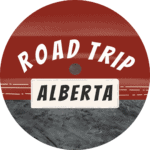

A Guide to Visiting Head-Smashed-In Buffalo Jump (for 2024)
Disclaimer: this page may contain affiliate links. please review our full terms and conditions for more information and our privacy policy. note that any pricing, operating hours, or other such information provided below may have changed since initial publication..
Compiled by the Road Trip Alberta team
Last updated on January 6, 2024
Designated a UNESCO World Heritage Site in 1981, Head-Smashed-In Buffalo Jump pays homage to the Indigenous peoples of the North American Plains. Full of significance, the site is also commemorated by the Government of Canada as a National and Provincial Historic Site.
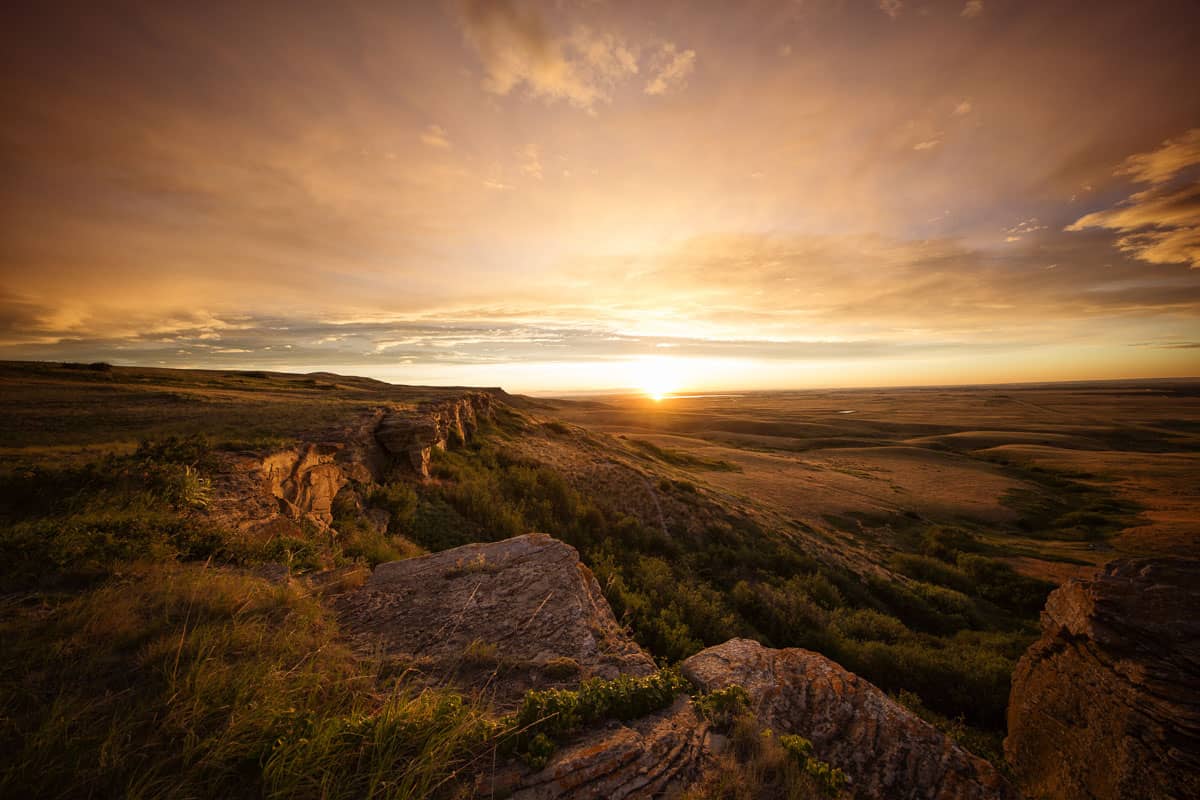
Sitting atop a prairie hill, the interpretive centre at Head-Smashed-In Buffalo Jump overlooks the spot where the primary food source and way of life were herded toward the edge and fell to their death. The demise of the bison provided sustenance and contributed to all facets of the Plains people’s way of being. Bison were how they clothed themselves, sustained themselves throughout brutal winters and provided shelter from the harsh prairie elements.
Showcasing extreme skill and knowledge of bison herd instincts, the Plains people used the location at Head-Smashed-In Buffalo Jump for over 6,000 years as depicted by extensive archaeological evidence. In fact, the evidence of human activities and hunting practices found at this site is some of the most developed in North America.
Head-Smashed-In Buffalo Jump is unlike any other attraction in Alberta, providing visitors with a glimpse into the past and into the culture and traditions of the native people of the Plains.
Land Acknowledgement
We acknowledge that Head-Smashed-In Buffalo Jump is located on the traditional land of the Blackfoot People. We honour and respect the way of life of the people who have walked this land for centuries.
How to get to Head-Smashed-In Buffalo Jump
From Calgary
The drive from Calgary to Head-Smashed-In Buffalo Jump is 183 km which takes approximately one hour and 50 minutes. If leaving from the city, take AB-2 / Deerfoot south, following the signs for Fort Macleod and Lethbridge. Follow AB-2 south for an hour and a half until reaching AB-785 W, and turn right at the marker for Head-Smashed-In Buffalo Jump. Follow AB-785 W until you see the large entrance sign for Head-Smashed-In Buffalo Jump which will be on the right-hand side.
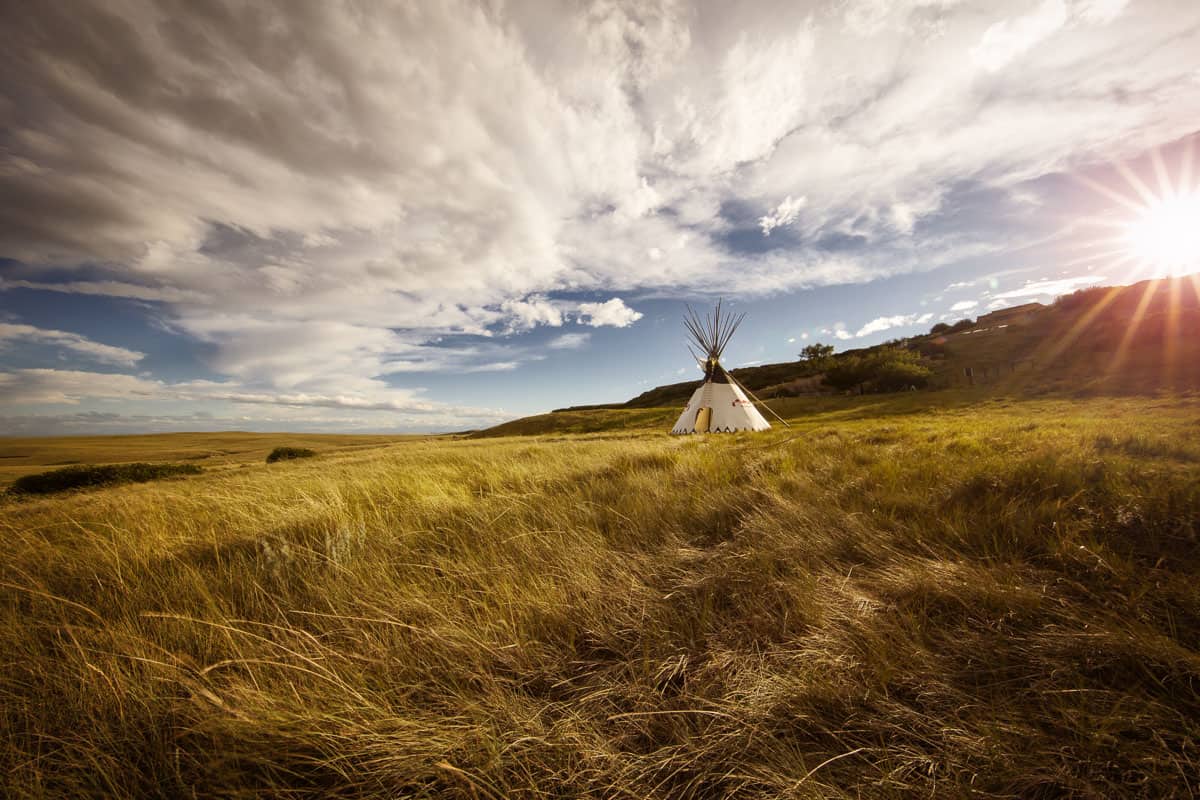
From Lethbridge
At only 70 km away, Lethbridge is the closest big city to Head-Smashed-In Buffalo Jump. To get to Head-Smashed-In Buffalo Jump from Lethbridge, head west out of the city on AB-3. Follow the highway through the town of Fort Macleod. Right after leaving the town, merge onto AB-3 W and use any lane to turn right onto Crowsnest Hwy/AB-2 N/AB-3 W (with signs for Fort Macleod/Pincher Creek/Calgary).
Use the right lane to take the AB-2 N ramp to Calgary and continue onto AB-2 N until reaching signs for Head-Smashed-In Buffalo Jump and AB-785 W. Turn left off the highway onto AB-785 W and follow the road for 16 km until reaching the large Head-Smashed-In Buffalo Jump sign on the right-hand side.
History and Archaeological Significance
Prior to colonization, the Blackfoot bands were nomadic. The structure of their movements was marked by three main factors: the location of the bison herds, the weather, and the season. Taking in those factors, they moved the location of their camp accordingly.
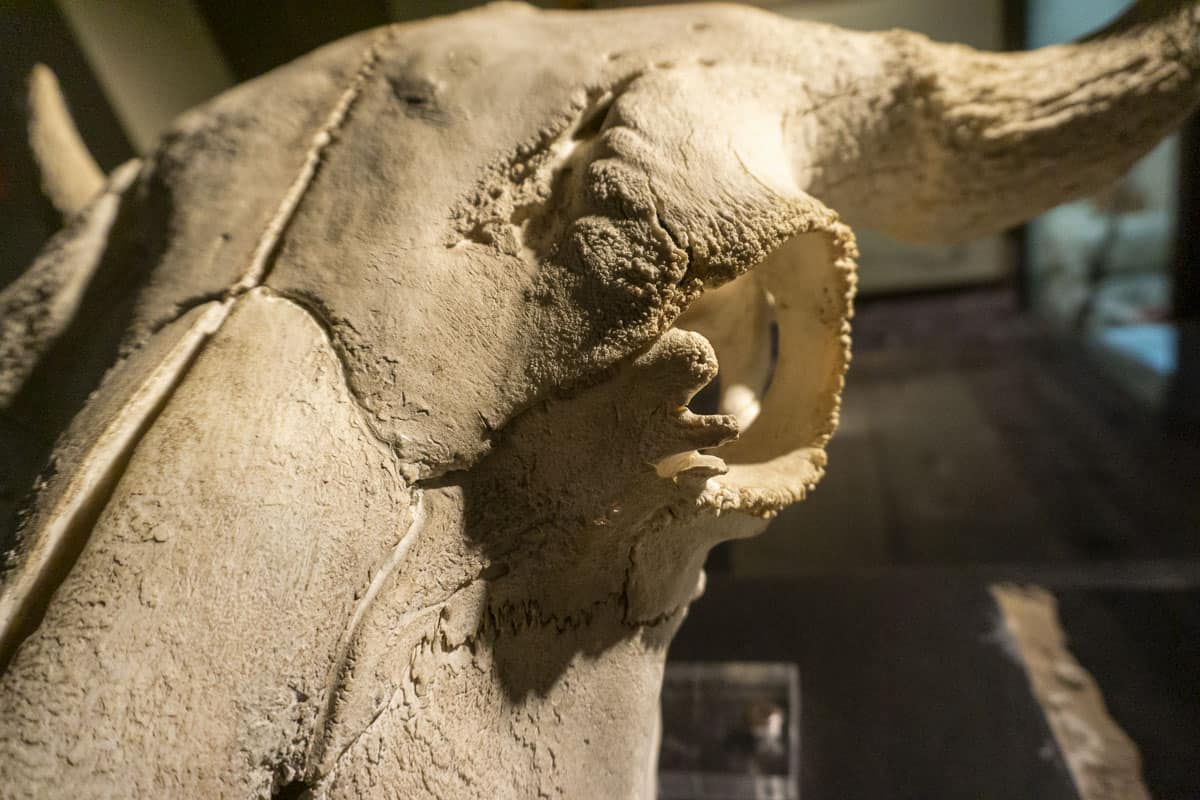
Although buffalo jumps can be found in multiple locations in the Northern Plains, the jump at Head-Smashed-In is the best-preserved and was the most extensively used for the longest period. Utilizing their knowledge of bison behaviour and herd patterns, the Plains people created an ingenious way to supply a large amount of food to the camps over the winter.
Buffalo runners dressed as wolves would sneak up on the vast herds of bison and play on their protective instincts of the babies, causing a stampede that was orchestrated by narrow drive lanes leading to an edge. When the bison got to the end of the drive lanes and realized that there was a deadly drop, the frenzy was too intense to stop the forward momentum; causing the herd to fall to their death. The kill site, or where the bison landed after their fall off the sandstone cliffs, is ripe with archaeological resources suggesting that people camped nearby. Furthermore, the stone tools and evidence of teepee rings helped to determine that all parts of the fallen bison were utilized in some way.
Archaeological evidence at the base of the jump shows that the Indigenous people utilized the bison remains for clothing, tools, food, and shelter. Bison were more than just a food source for the Plains people; this majestic animal was an integral part of their culture.
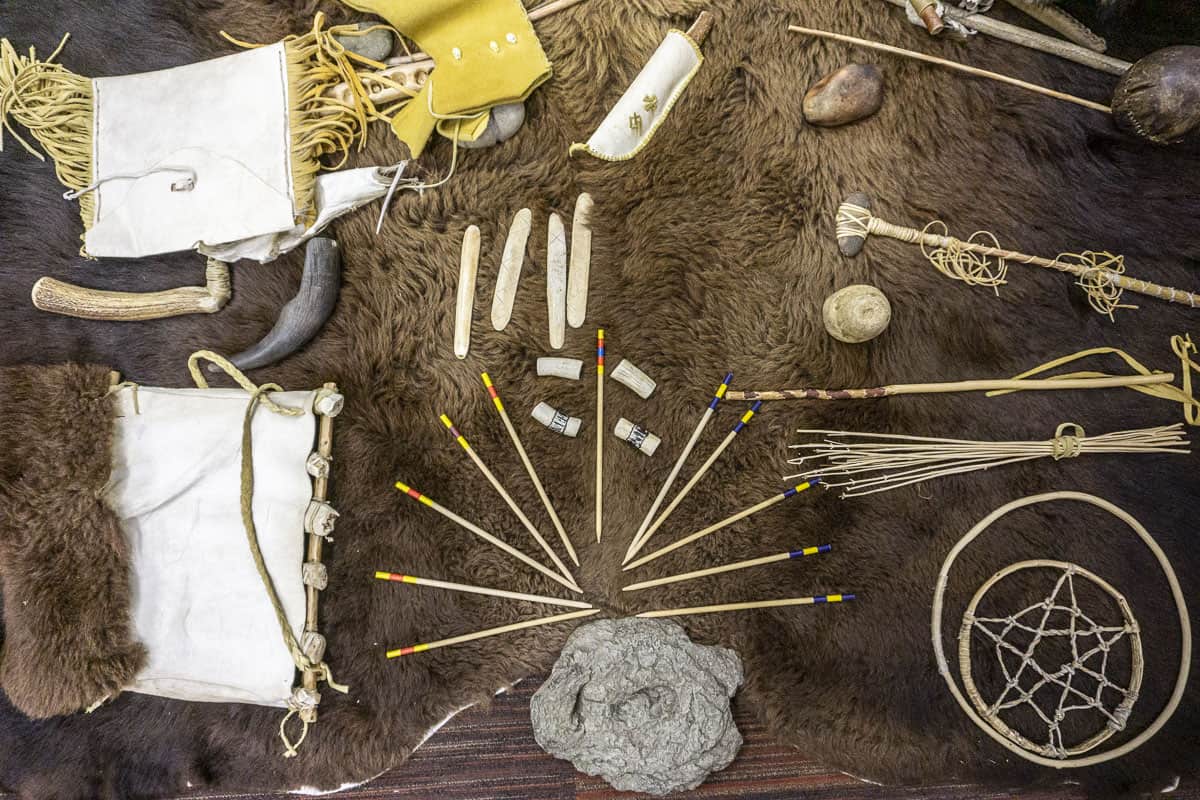
With the settlement of Europeans in the area in the late 19th century and the arrival of the North West Mounted Police, who began patrolling the region in 1874, bison became the main target of the settlers. Drawn in by the seemingly endless herds of them roaming the prairies, bison became not only a food source but targeted for their hides and often used as target practice for those with guns. Alas, the supply was not endless, and the buffalo hit near extinction in a very short amount of time.
In 1881, when the buffalo were few and far between, the Blackfoot people pursued their traditional lifeways for as long as possible. With the substantial loss of their main food supply, and with the persuading by North West Mounted Police patrols to adapt to a more civilized way of being, they were obliged to adapt to a new era.
Things To Do at the Head-Smashed-In Buffalo Jump Historical Site
To complete the full experience at Head-Smashed-In, allow for at least 2 hours to have adequate time at the Visitor Centre galleries and walk to the Cliff Top Viewpoint. Allocate additional time if you are planning on doing any hiking in the surrounding area.
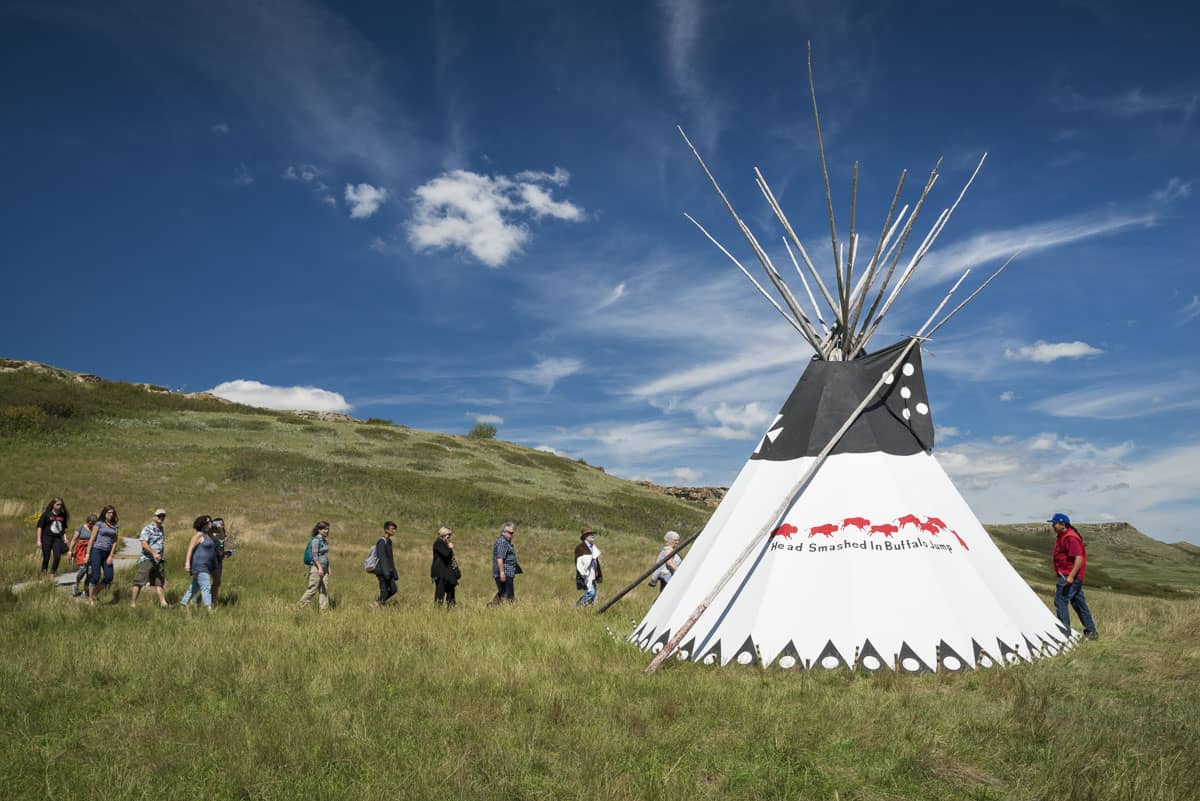
Visitor Information Centre
With seven layered stories, the visitor information centre at Head-Smashed-In Buffalo Jump World Heritage Site is world-class and full of interpretive displays and interactive exhibits. Weaving the cultural significance of the site with archaeological discoveries and historical data, the information provides a multi-faceted approach to understanding how a deep knowledge of the land and bison behaviour allowed the people to flourish for centuries. As we learn, bison represented more to the Native people of the Plains than just a food source. They were an integral part of their way of life. Hence why European settlement led to catastrophic damage to the Blackfoot People.
Don’t forget to stop into the gift shop as well to peruse the authentic First Nations wares and souvenirs to commemorate your visit to the site.
Theatre
Beyond the numerous displays in the interpretive centre, there is also an 80-person theatre where a 15-minute movie plays to illustrate communal hunting techniques utilized by Plains Peoples at the cliff. We highly recommend taking the time to watch a showing as it does an excellent job of showing the hunting strategy and culture that surrounds the buffalo jump.
Wheelchair Accessibility
For a multi-level information centre, the visitor information centre at Head-Smashed-In is wheelchair friendly. Guests can choose to either walk the steps throughout the tour or step onto the elevator to get to their desired floor.
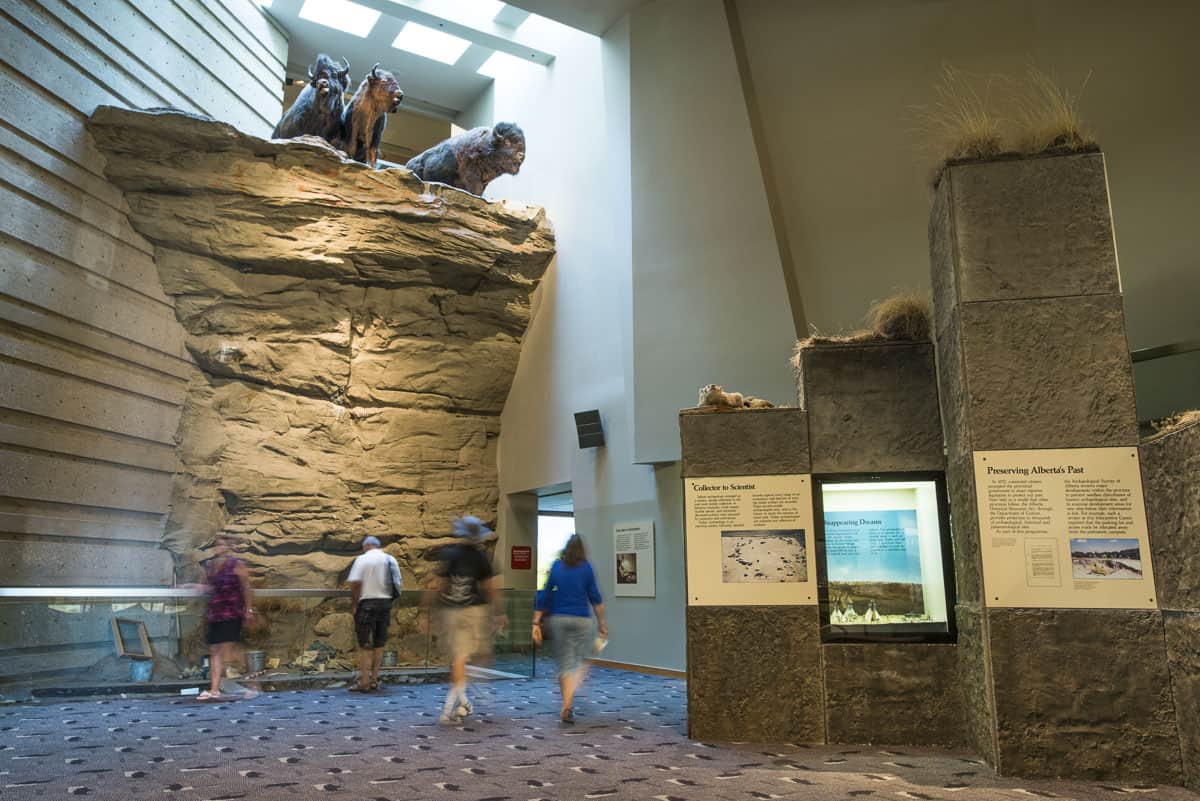
Even the lookout point at the top of the centre has a paved pathway that leads to the end with plenty of benches for rest breaks. The lookout has plenty of telescopes to allow visitors to take a closer look at the jump site or the breathtaking prairie landscape of the Porcupine Hills that surround the site.
Special Considerations for the 2024 Visitor Season
No cafeteria – Although there is an on-site cafeteria at Head-Smashed-In Buffalo Jump, it is currently closed. Ensure to pack your own picnic lunch, snacks, and plenty of water especially if you are planning to do some outdoor exploring.
Capacity restrictions – Head-Smashed-In Buffalo Jump is a popular tour bus and field trip stop and since the majority of experience lies within the interpretive centre, it can get very busy in the summer months. Be aware that there might be a wait to get in, especially at peak times (typically 11 am – 2 pm daily). We recommend planning your visit accordingly: 10 am – 11 am or 2 pm – 5 pm would be good times to visit in order to avoid intense crowds.
No tour guides – The hike to the drive lanes typically includes a guided interpretation. However, that will not be available in the 2024 season. Therefore, the popular “Hike To The Drive Lanes” program will not be available this season. The only self-guided hiking available is the Upper Trail and Viewpoint, and a walk along the self-guided Lower Trail. Additionally, the interpretive centre will be self-guided, and, there are plenty of interactive displays to make the most of the experience.
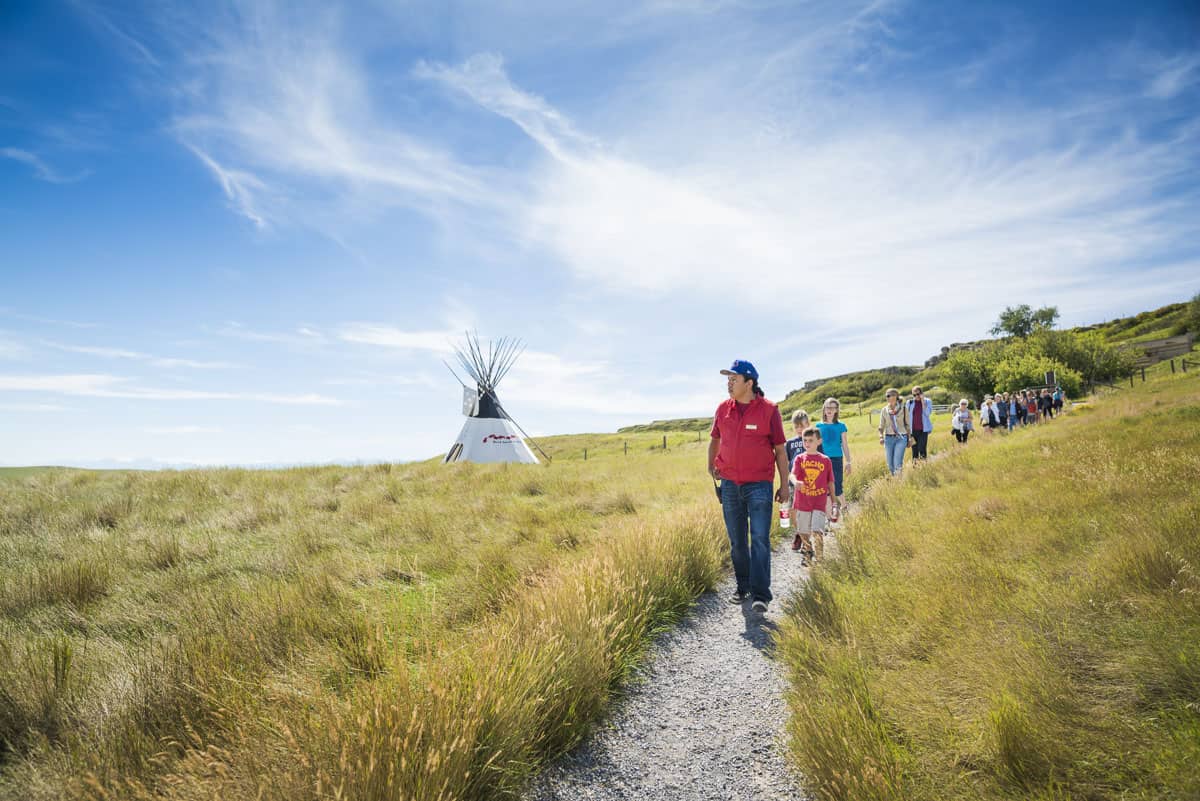
No assistance to get up the hill from the parking lot – Although the site itself is very wheelchair friendly, it is important to note that the centre is perched on the hillside with the parking lot at the bottom. It is paved, but it is a (relatively short) climb to get from your vehicle to the interpretive centre. It is also in the middle of the prairie landscape, so there is no shade, and temperatures routinely get above 30ºC in the sun. If travelling with someone who may have difficulty with a steep walk up and down the hill, we recommend dropping them off at the centre before parking the vehicle.
Don’t Miss Visiting This Important Archaeological Site
Right off the main highway, Head-Smashed-In Buffalo Jump is an easy add-on to a trip between Calgary and Lethbridge! Full of culture and history from a unique perspective, this UNESCO World Heritage Site is a stop worthy of a couple of hours that will delight travellers of all ages.
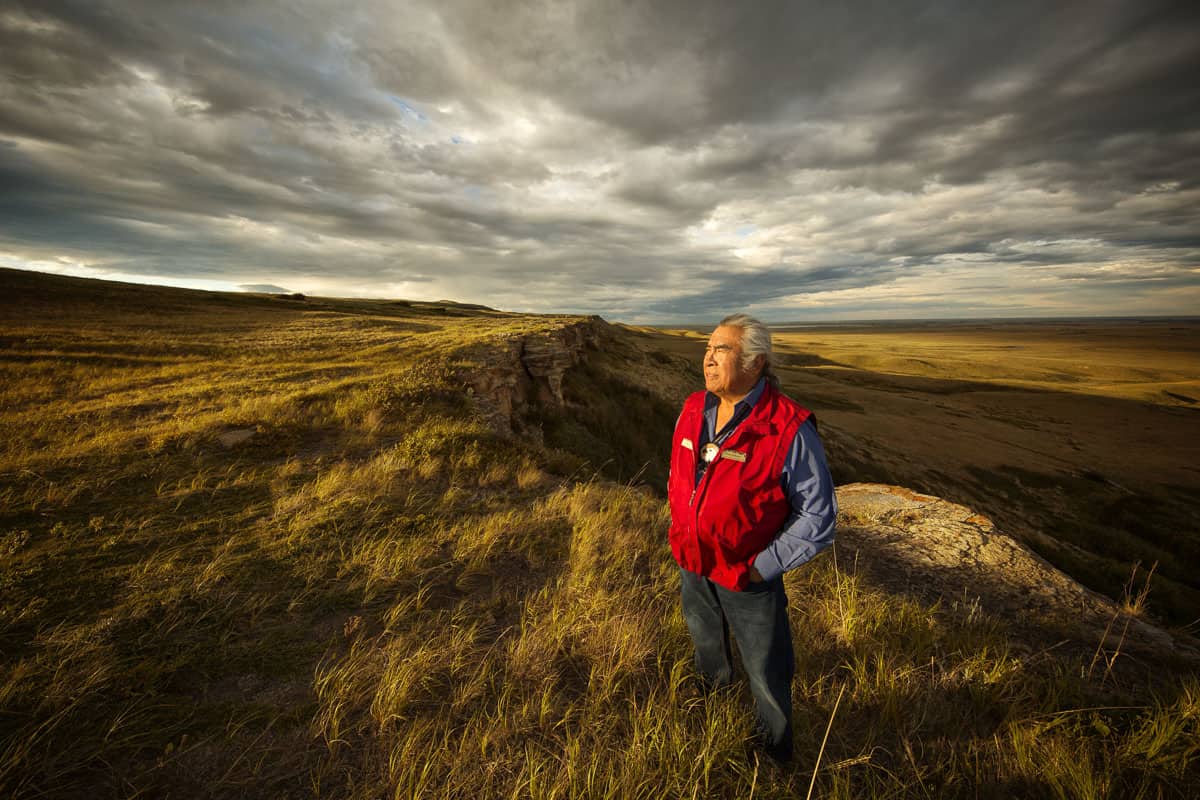
For another facet of Alberta history, we highly recommend also stopping in at the Fort Museum of the North-West Mounted Police in Fort Macleod. Or spend some time in the region and plan to visit another World Heritage Site to check off your bucket list (there are three others in southern Alberta!).
Looking for more to do in the area? Review this guide for a 2-3 day southwest Alberta road trip for ideas. And this guide of things to do in Fort Macleod .
And don’t forget to download our FREE Road Trip Alberta bingo cards to have in your car for any road trip!

Dalene Heck is a co-founder of Road Trip Alberta. She was born in Edmonton, grew up in the Peace Country, and has ventured to almost every corner of Alberta and the world (she’s travelled to 60 countries)! She is a serial blogger, the CEO of HMI Marketing , co-creator of the Trip Chaser card game, a leukemia-slayer, and cat whisperer.
Related Posts
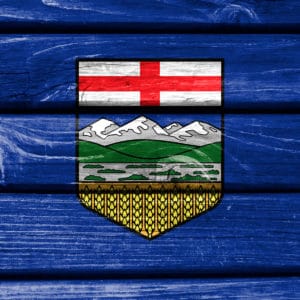
Sharing is caring!
Before Footer
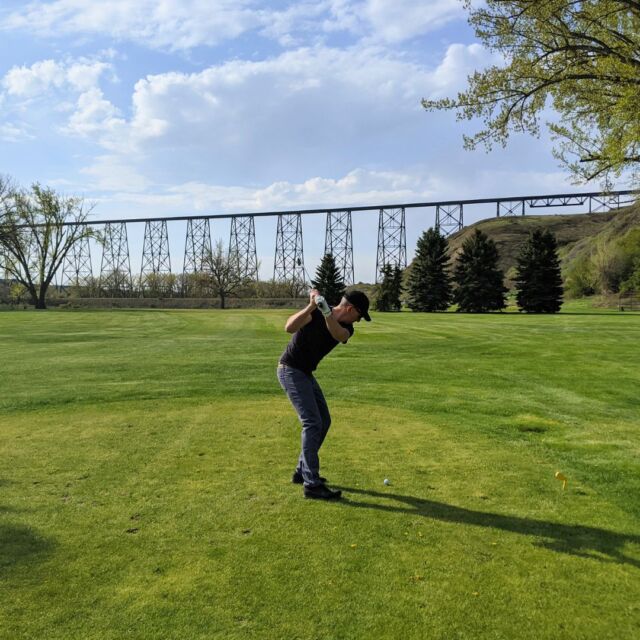
We're here to help you plan your Alberta vacation with real, local advice!
- Destination Guides
- Route Guides
- Driving Advisories
- Alberta Driving Guide
- Alberta Weather
- Alberta itineraries
Play Alberta Road Trip Bingo!
We've created FOUR Alberta specific bingo games to make your road trip even MORE fun. Included are some insider tips on what to see and eat in the province!
*Which you will definitely feel if you miss out on our awesome local advice!
Our guides and itineraries will save you time, money, and heartache*.

A Visit to Alberta’s Fascinating Head-Smashed-In Buffalo Jump

One of the most ingenious hunting practices in human history was the buffalo jump, which involved driving massive groups of buffalo off a cliff, then collecting the bodies for meat, hides, and other essential uses.
The Head-Smashed-In Buffalo Jump site in southern Alberta, Canada is among the most well-preserved buffalo jumps in North America. As such, it has been given the rare UNESCO World Heritage Site designation.
Visitors can walk right up to the ledge where native Blackfoot hunters would lead the buffalo to their demise. They can also walk on a trail down at the bottom of the hill where the bodies landed.

Interestingly, the cliff doesn’t look all that tall. The hillside is only about 36 feet high these days. It used to be double that height, but the buildup of bone fragments and debris at the bottom after nearly 6000 years of use has cut down on its vertical distance over time.
That modest height meant that some buffalo endured the fall, injured but alive. Hunters were positioned at the bottom of the hill to finish off any animals that did not die in the initial plunge.

Here’s what I find most amazing about Head-Smashed-In Buffalo Jump. This site was still being used as recently as the late 1800s!
Major League Baseball games were being played in America at roughly the same time that native people were still chasing buffalo off this hill. That’s amazing to think about.
The Art of the Buffalo Jump
Buffalo jumps were an extraordinarily complex and difficult to pull off. It wasn’t just a matter of chasing a few animals.
Buffalo have an excellent sense of smell but poor vision, so pulling off a successful drive required perfect wind, weather, and timing.

The drive started two miles away from the kill site. The hunters would first establish “drive lanes” by creating artificial boundaries of rocks or trees on either side of the field. The buffalo viewed these boundaries as solid walls and would not try to go through them.
Then “buffalo runners” would wear the hide of a buffalo and direct the group of animals deeper into the lanes toward the hill. Once the lead animals began running, the other would follow in a stampede.
Additional hunters would be stationed along the side boundaries to scream and yell, in order to keep the buffalo in their frightened and alarmed state.

The drive lanes got more narrow as they approached the cliff, which had the effect of funneling the pack of buffalo into the same small piece of land.
Just before reaching the kill spot, the buffalo runners who were running with the pack would scoot out through the side boundary, while all the animals behind them would continue running forward over the hill.
Attempts did not take place every year. The conditions had to be just right. The drive lanes had to be just the right size. The wind had to be blowing toward the cliff so the animals would not smell the humans gathered in that spot.
Drives were often held in the fall when the animals were healthy and fat. Multiple tribes in the area might join together to pull them off.
Not every attempt was successful. But when they were, the hunters suddenly found themselves with thousands of pounds of meat for food, clothing, and shelter. The bones were used to make tools. Very little of the animals was wasted.
Sights at Head-Smashed-In Buffalo Jump in Alberta

Learning about the buffalo jumps was fascinating, and Head-Smashed-In (named after a legend about a boy who tried to watch the buffalo jump at the bottom of the hill but got crushed) does a great job of telling the story with videos and exhibits in its indoor five-level museum section.

Standing in the actual, physical location where all this happened is an overwhelming feeling. You can sit on a bench right at the kill site. Talk about being right where the action happened!

The interpretive center includes a display of some of the ways that the buffalo parts were used. Buffalo horns could be used as a canister to transport hot coals (item #8), or used as drinking cups (item #9). Bones were sharpened into awls for sewing (item #11), and bladder bags were used to store and preserve fat (item #13).

Archaeologists have studied the soil and uncovered several different layers of bones and weapons that provide a record of various eras during which the site was used for hunting.

The trails at Head-Smashed-In aren’t very long, so anyone in decent shape should walk the paths to get a sense of what the Canadian plains are like.

While you’re in Alberta, be sure to also visit Athabasca Glacier , one of the wonders of Jasper National Park .
Also spend two days in Banff National Park if you get the chance. And stop in to the Gopher Hole Museum , one of the quirkiest places I’ve ever visited!
If You’re Going: Head-Smashed-In Buffalo Jump
Address : Route 785, Fort MacLeod, Alberta, Canada AB T0L 0Z0 ( Google Map ) Cost : $15 Canadian for adults, $13 for seniors, $10 for kids When to Visit : Open 10-5 everyday (only open Wednesday through Sunday in winter) Website : https://headsmashedin.ca/ Further Reading : Head Smashed In Buffalo Jump (paperback) (Amazon)
About The Author
Scott Shetler
Related posts.

Quirky Attraction: Museum of the Weird in Austin, Texas

15 Awesome Things To Do in New Bern, NC!
Leave a comment cancel reply.
Your email address will not be published. Required fields are marked *
Tips for Visiting Head Smashed in Buffalo Jump: Travel Guide
Love it? Share it!
Nestled on the rolling plains of southwestern Alberta, Canada, visiting Head-Smashed-In Buffalo Jump offers more than just a chronicle of history; it’s a journey that connects visitors to the land’s intrinsic story and the ancient traditions of the indigenous people.

This comprehensive Head-Smashed-In Buffalo Jump travel guide will walk you through everything you need to know to make the most of your visit to this world heritage site, from understanding its significance to planning your trip and making the most of the experience.
Visiting Head Smashed in Buffalo Jump: Travel Guide & Tips

Disclosure: This post contains affiliate links. If you click one of them, we may receive a small commission at no extra cost to you.
The Head-Smashed-In Buffalo Jump is a remarkable UNESCO World Heritage Site. It is a unique place to learn about the hunting practices of the indigenous Blackfoot people.
This is a UNESCO World Heritage Site, which was recognized in 1981. It has been designated a National Historic Site since 1968 and a Provincial Heritage Site since 1979.
History of Head Smashed in Buffalo Jump
Land Acknowledgement
We acknowledge that Head-Smashed-In Buffalo Jump is located on the traditional land of the Blackfoot People. We respect the way of life of the people who have walked this land for centuries.
The site has profound evidence – from well-marked trails and a camp to considerable remains of buffalo (American Bison) skeletons – of practices followed by Aboriginal peoples of the North American plains for nearly 6 000 years.

With an exceptional understanding of the terrain and buffalo behavior, they expertly hunted their prey by driving them over a precipice.
The educational video on the Blackfoot people and the visuals at the Buffalo Jump Interpretive Centre show how bison were lured to the edge and pushed down. It was very enlightening.
The term “Blackfoot – Plains People” encompasses three distinct tribes: the Blackfoot proper (Siksika), the Bloods (Kainai), and the Peigan (Piikani). While each tribe maintained their independence, they shared a common language.

These tribes possessed remarkable proficiency as warriors, exerting control over an expansive territory spanning the North Saskatchewan River in Alberta to the Yellowstone River in Montana. Their dominion extended from the majestic Rocky Mountains to the Cypress Hills on the Alberta-Saskatchewan border.
While the Blackfoot were nomadic, their movements adhered to a well-structured pattern, often dictated by the whereabouts of bison herds, prevailing weather conditions, and seasonal variations.
The site has diligently preserved this historical practice, and the interpretive exhibits vividly showcase the skillful butchering of the carcasses at the camp.

You will walk on trails (Upper and Lower Trails) and viewing areas to see where it all happened. These paths are equipped with informative exhibits that you can refer to as you take photographs and enjoy the view of the plains.
Blackfoot people continue to have a deep connection to this site; we also respect their culture and heritage by preserving it.
Things to see in Head Smashed in Buffalo Jump
Once at the Head Smashed in Buffalo Jump, you will be welcomed to a large parking lot (overnight parking is prohibited). You can also park your campervan here.

The visitor centre is located past the welcome sign and housed inside the Head Smashed in Buffalo Jump complex.
We bought our tickets at the centre (and it is a cheaper ticket when traveling in a group), and the lovely lady at the counter provided a quick overview of the site.
During our visit, group tours were not operational.
Key Attractions and Activities at Head-Smashed-In Buffalo Jump
Buffalo Jump Interpretive Centre/ Visitor Information Centre:
This is where we spent most of our time.

The visitor centre is a multi-level facility packed with a museum of interactive exhibits, film presentations, and curated displays, providing visitors with a holistic understanding of the Buffalo Jump and the Blackfoot way of life.
We went through the various exhibits and followed signs to explore all the floors.

The highlight of the visit was a 15-minute presentation that showcased how the ‘jump’ process took place, including its preparation, practicalities, nature-related struggles, and community building.
It indeed shows how the Blackfoot People were connected to the land and how the bison were more than just a game or source of food for them.

We highly recommend visiting and spending 1+ hour here to understand and delve into the incredible history and culture of the region.
Note that the facility is wheelchair accessible. There are elevators onsite, too. Certified Service Animals are allowed onsite.
Hiking Trails :
Adventurous spirits are welcome to explore the landscape around the jump. The trails offer beautiful views of the surrounding plains and a chance to see local wildlife if you’re keen.
Each path is well-maintained, perfect for a relaxing stroll or an ambitious hike.

You can grab the Lower Trail map and hit the route. Or choose the accessible Upper Trail with the viewpoint and informational exhibits.
Either way, you can see the gorgeous plains and stunning panorama and learn about its history.

Be sure to carry water, as the prairie climate can be unpredictable.
Guided Tours :
Different types of guided tours are available at the Head Smashed in Buffalo Jump. Knowledgeable interpreters lead these tours, providing deep insights into Blackfoot culture, the buffalo hunting techniques, and the significance of the jump.
During our visit, tours were not conducted (same for 2024). One popular program here, the Hike To The Drive Lanes, is canceled for this season.
You can use the self-guided trail map to navigate the complex and visit the Lower, Upper Trail, and Viewpoint.
Live Demonstrations and Special Events :
Watch out for special events and live demonstrations throughout the year to enrich your visit. These could include traditional dances, crafts, storytelling, and more, highlighting the living culture of today’s Blackfoot Nation.
Guided programs, including bus tours for all ages, youth, and school groups, are organized regularly. More details here

Note: We recommend checking the hours of operation before you start for Head Smashed in Buffalo Jump. They operate on a seasonal schedule.
As mentioned above, group tours are canceled for 2024. A cafeteria (Buffalo Jump Café) is available onsite but closed for 2024. Bring food and drinks if you plan to stay for long hours.
The gift shop is currently open.
Head Smashed in Buffalo Jump Tips
This address of the heritage site is secondary Highway#785, Fort MacLeod, AB (in southern Alberta).
Visitor Tips and Practical Information
Getting There : The closest airport to Head-Smashed-In Buffalo Jump is Calgary International Airport, approximately a two-and-a-half-hour drive south.
- When you leave the city, take the AB-2 / Deerfoot south and follow signs for Fort Macleod and Lethbridge
- Follow AB-2 south until you reach AB-785 W, and then turn right at the marker for Head-Smashed-In Buffalo Jump
- Next, follow AB-785 W until you see the entrance sign for Head-Smashed-In Buffalo Jump on your right
The drive from Calgary to Head-Smashed-In Buffalo Jump typically takes about two hours, depending on traffic and road conditions.

Traveling from Edmonton is about 5 hours by car.
You can visit the site by public transportation. Buses are available from Calgary to Fort Macleod; it is a short taxi ride to the site.
Hours of Operation : The site’s opening hours change according to the season (winter and summer hours). They are open daily from 10:00 AM to 5:00 PM (typical hours), except Mondays and Tuesdays.
The facility may be closed on major holidays—it is always best to check ahead.
Tours Available : Guided tours are available year-round. Reservations are recommended, especially during the high season.

Facilities : The site features a café, gift shop, elevator, picnic area, and parking. The interpretive center and the path to the jump site are wheelchair accessible, ensuring everyone can enjoy the visit.
Admission Fees: The entry fee is $15 for adults, and entry is free on Family Day.
Other Tips:
- Remember to wear comfortable walking shoes, as there are several trails to explore
- Although the site is open all year round, be prepared for the weather
- Respect any cultural artifacts or sites, such as the First Nation camp, by not touching or disturbing them
- Be mindful of responsible tourism practices while visiting the Head-Smashed-In Buffalo Jump World Heritage Site. Never no trace when you return.
Sample Itinerary for a Day Trip to Head-Smashed-In Buffalo Jump
Starting early from Calgary , hit the road by 7:00 AM to make the most of your day and avoid traffic on the Trans-Canada Highway.
Upon arrival at Head-Smashed-In Buffalo Jump, begin your day with a visit to the Interpretive Center. Spend 1-2 hours immersing yourself in the exhibits and gaining a richer understanding of the area’s significance.
Join a guided tour to the cliff base (if available). Tours usually last around 2 hours, including transit time to the jump’s launching area.

After the tour, enjoy a picnic or relax at the on-site café for lunch (when open). The center’s outdoor areas provide stunning backdrops for your meal.
Afternoon :
With your afternoon free, explore the hiking trails within the site. A shorter, easy trail will still reward you with great views, but longer hikes can lead to less explored corners.
Time your visit with any live demonstrations or scheduled cultural activities happening later in the afternoon.
Depart from Head-Smashed-In Buffalo Jump and head to Fort Macleod. You can also stop here for dinner.
Where to Go After Visiting Head-Smashed-In Buffalo Jump?
We visited the Head-Smashed-In Buffalo Jump on our way to Waterton Lakes National Park, a UNESCO World Heritage site with shimmering lakes, a view of the Rocky Mountains, and abundant wildlife.

We also stopped at Pincher Creek and the Red Rock Canyon before arriving at the Waterton townsite.
Both destinations promise a continuation of your journey through Alberta’s rich natural and historical landscapes, offering experiences that are as magical as they are unique.

Pincher Creek was stunning on our visit, and we also stayed overnight on one of our trips. This town is filled with windmills and is almost like a mini Switzerland!
The Head-Smashed-In Buffalo Jump is an extraordinary destination deeply rooted in Canada’s native culture and history, offering visitors a rare glimpse into ancient traditions.
As you plan your visit, keep this guide close, with your camera, a keen curiosity, and a hearty spirit of adventure. Immerse yourself in this remarkable place’s landscape, stories, and experiences, and you’ll leave with memories to treasure forever.
The site is pretty impressive, and the Blackfoot people continue to have a deep connection to this site; by preserving it, we also respect their culture and heritage.
Pin: Head-Smashed-In Buffalo Jump Travel Guide

Mayuri Kashyap is an Indian Canadian traveler, writer and photographer based in Alberta. She moved to Toronto as a student in 2009, and has been calling Canada home ever since. She started the blog - Canada Crossroads - to share her travel and living experiences in the Great White North!
A History graduate and an MBA, Mayuri is a destinations marketing expert. She loves traveling with her husband, Salil and soaking in experiences across Canada, India and Europe.
Similar Posts

Epic 10 day Canadian Rockies Itinerary & Road Trip
Canada’s showstopper mountains await you in Banff, Jasper and Yoho National Park. In this post, we will share an EPIC 10 day Canadian Rockies Itinerary in a road trip format. At these national parks located primarily in Alberta, you will see the Canadian Rockies in all their glory. Living in Edmonton, the Canadian Rockies have…

18 Top Things to do in Waterton Lakes National Park
Waterton Lakes National Park is a place of beauty and wonder. It’s the only park in Canada that borders two countries! The landscape is diverse, with rolling prairies, lush wetlands, towering mountains, and deep canyons – it really is an adventure for all seasons. Here are the top things to do in Waterton Lakes National…

60+ Things to do in Vancouver in Winter in 2023-24
Canada is a wonderful place to spend your Christmas holidays. And in this post, we will highlight some delightful things to do in Vancouver in winter. From Christmas markets, festive events, ice skating, and shopping, Vancouver will not disappoint you! 60+ Things to do in Vancouver in Winter 2023 and 2024: Attractions, tours & festivals…

65 Interesting Facts About Alberta You Must Know
Alberta is one of the 10 provinces in Canada. It is located in western Canada and is bordered by the provinces of British Columbia to the west and Saskatchewan to the east, the Northwest Territories to the north, and the US state of Montana to the south. We have been calling Alberta home for the…

15 Best Places to eat in Edmonton Alberta + Map
At first glance, it might seem like Edmonton doesn’t have many restaurants to check out. But little did you know that it actually has plenty of places for foodies to check out! Here’s presenting 15 amazingly best places to eat in Edmonton from cafes, baked shops, to romantic fine dining options. If you ask an Edmontonian…

27+ Epic Things to do in Toronto in Winter
Just because the weather outside is frightful, doesn’t mean you can’t have a blast in the city. Toronto is a winter wonderland with plenty of activities to keep you busy. In this guide, we will share all the fun things to do in Toronto in winter along with packing, sightseeing, and travel tips! Now, Toronto…
Leave a Reply Cancel reply
Your email address will not be published. Required fields are marked *
Save my name, email, and website in this browser for the next time I comment.
Take advantage of the search to browse through the World Heritage Centre information.
Share on social media
Unesco social media.
- Head-Smashed-In Buffalo Jump
- Description
In south-west Alberta, the remains of marked trails and an aboriginal camp, and a tumulus where vast quantities of buffalo (American Bison) skeletons can still be found, are evidence of a custom practised by aboriginal peoples of the North American plains for nearly 6,000 years. Using their excellent knowledge of the topography and of buffalo behaviour, they killed their prey by chasing them over a precipice; the carcasses were later carved up in the camp below.
Description is available under license CC-BY-SA IGO 3.0
Le précipice à bisons Head-Smashed-In
Dans le sud-ouest de l'Alberta, les vestiges de pistes balisées, les restes d'un campement autochtone et un tumulus où l'on a trouvé d'énormes quantités de squelettes de bisons illustrent un usage pratiqué pendant près de six millénaires par les peuples autochtones des grandes plaines de l'Amérique du Nord. Ceux-ci, grâce à leur connaissance très précise de la topographie du terrain et du comportement des bisons, pourchassaient les troupeaux vers le précipice et dépeçaient ensuite les carcasses dans un campement en contrebas.
جرف البيسون المغروز الرأس
في جنوب غرب مقاطعة ألبرتا، تشهد آثار المدارج الموسومة وبقايا مخيم سكنته الشعوب الأصلية وإحدى الجثوات التي تحوي كميّات كبيرة من الهياكل العظمية الخاصة بحيوان البيسون على عادة فريدة درجت لمدة ست آلاف سنة تقريباً لدى الشعوب الأصلية المنتشرة في السهول الشاسعة لأميركا الشمالية. وبفضل الإطلاع العميق لهؤلاء الشعوب على تضاريس هذا المكان وعلى سلوك البيسون، كانوا يطاردون قطعان البيسون باتجاه الجرف ثم يقطّعون هياكلها العظمية في المخيم الذي يقع في أسفل الجرف.
source: UNESCO/CPE Description is available under license CC-BY-SA IGO 3.0
在艾伯塔省(Alberta)的西南部,发现了标有记号的数条小道、土著人营房和坟地遗址,里面存有大量的野牛(美洲野牛)骨骼,向人们生动地展示了近六千年前的北美平原上土著人的生活习俗。他们利用对地形的熟悉和对野牛习性的了解,将牛群追赶到悬崖边,迫使其跳崖摔死,然后在下面的营房里分割尸体。
Despeñadero de bisontes Head-Smashed-In
En este sitio del sudoeste de la provincia de Alberta, se han hallado vestigios de pistas balizadas, restos de un campamento de nativos y un túmulo con enormes cantidades de osamentas de bisontes. Todos estos elementos ilustran una costumbre practicada durante seis milenios por los pobladores aborígenes de las grandes llanuras de América del Norte. Gracias a su exacto conocimiento de la topografía del terreno y del comportamiento de los bisontes, los nativos acosaban sus manadas hasta un precipicio para despeñarlas. Luego, descuartizaban a los animales en un campamento instalado en la base del despeñadero.
ヘッド-スマッシュト-イン・バッファロー・ジャンプ
source: NFUAJ
Head-smashed-in buffalo jump
Het landschap van de Head-smashed-in buffalo jump (ingeslagen-kop buffelsprong) ligt in het zuidwesten van Alberta. Er bevinden zich de overblijfselen van gemarkeerde paden, een kamp voor de inheemse bevolking en een grafheuvel waar nog steeds enorme hoeveelheden buffel (Amerikaanse Bizon) skeletten liggen. De restanten zijn het bewijs dat inheemse volkeren van de Noordelijke -Amerikaanse vlakten hier bijna 6.000 jaar hebben gewoond. Dankzij uitstekende kennis van het gebied en het gedrag van buffels, kon de inheemse bevolking de buffels doden door ze over een afgrond te jagen. De karkassen werden later opgedeeld in het ondergelegen kamp. Deze jachttechniek werd de buffalo jump (buffelsprong) genoemd.
Source: unesco.nl
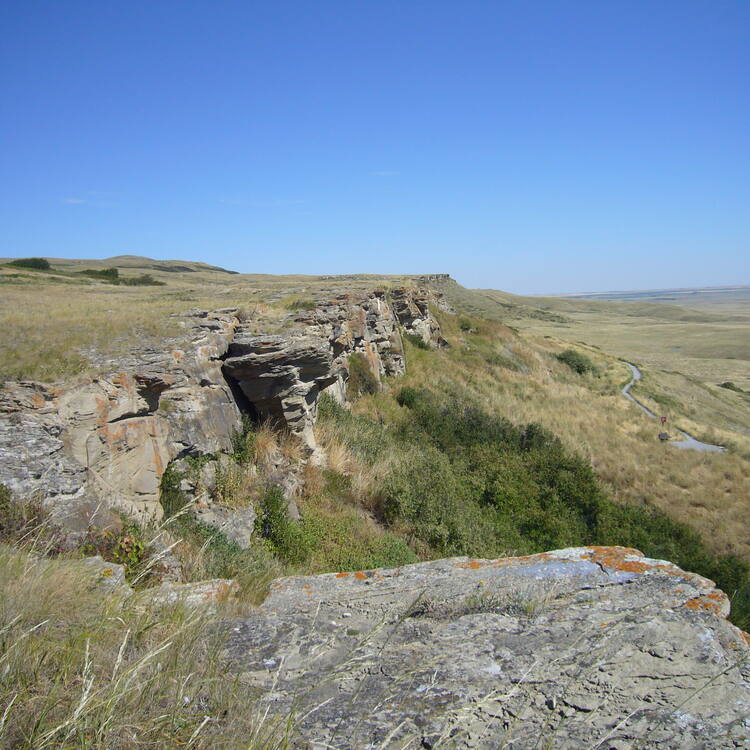
Outstanding Universal Value
Brief synthesis
The significance of the landscape of Head-Smashed-In Buffalo Jump lies in its historical, archaeological and scientific interest. The deep, undisturbed layers of animal bones (largely American Bison) represent nearly 6,000 years of continuous occupation with one lengthy period of unexplained interrupted hunting. This landscape is an outstanding example of subsistence hunting that continued into the late 19th century and which still forms part of the ‘traditional knowledge base’ of the Plains nations. It throws valuable light on the way of life and practices of traditional hunting cultures elsewhere in the world.
Head-Smashed-In Buffalo Jump is located in southern Alberta, Canada, where the foothills of the Rocky Mountains meet the Great Plains. It is the best preserved example of the communal hunting techniques and of the way of life of the Plains people based on the vast herds of bison that existed in North America for more than five millennia. A remarkable testimony of pre-European contact life in North America, this bison jump bears witness to a sophisticated custom practiced by Indigenous people of the North American plains. These people, drawing on their excellent understanding of bison behaviour and topography, used natural barriers such as coulees, depressions and hills to funnel these animals into drive lanes that ended at a precipice, over which the bison were stampeded. The animals’ carcasses were then butchered in a camp set up below the cliff to provide food and the materials for clothing, tools and dwellings. The development of complex social and technological systems to systematically and repeatedly harvest the herds in a communal hunt also nourished spiritual interests. Head-Smashed-In Buffalo Jump is the most outstanding of the surviving bison jumps in the Americas in use from approximately 5,800 years BP until AD 1850. On this grassy, windswept 3,626-ha landscape can be seen the drive lanes that led the bison toward the jump (including the remains of stone markers used to direct the bison toward the cliff), the 10-m-high cliff face that served as the actual jump, the foot of the cliff where numerous undisturbed stratified layers of bone and cultural deposits are found, and the area encompassing the many butchering camps established through the millennia.
Criterion (vi): Head-Smashed-In Buffalo Jump is one of the oldest, most extensive and best preserved sites that illustrate communal hunting techniques and of the way of life of Plains people who, for more than five millennia, subsisted on the vast herds of bison that existed in North America.
The 3,626-ha property encompasses all the elements necessary to understand the communal hunting technique that is the basis for its Outstanding Universal Value, including numerous undisturbed stratified layers of bone and cultural deposits, drive lanes, the cliff face and the butchering camps. Its boundaries thus adequately ensure the complete representation of the features and processes that convey the property’s significance. The property is not at risk of degradation and does not suffer from adverse effects of development and/or neglect. There is no buffer zone.
Authenticity
Head-Smashed-In Buffalo Jump is an exceptionally well-preserved landscape that illustrates the Indigenous tradition relating to bison hunting. In terms of setting and materials, the extensive landscape features include the gathering basin and archaeological features such as the rock cairns that define the borders of the extensive drive lanes. Since 1960, the property has been the object of systematic archaeological excavations that have enriched knowledge about the pre-European-contact era. This information transformed previously held theories on the use of game for food, clothing and shelter by the Plains people.
A potential threat to the authenticity of the property is the increase in the erosion of the cliff and pathways with use over time and with the extreme weather patterns seen in recent years. An increasing number of visitors at Head-Smashed-In Buffalo Jump has the potential to create pressures on the property. Since inscription, a visitor interpretation centre has been built into the cliff side and access to the property has been restricted in order to control visitor impacts and to interpret the property’s associated values more effectively. Where required, archaeologists have also surveyed and sampled pathways, roadways and parking structures to ensure they are clear of any significant cultural materials.
Protection and management requirements
Head-Smashed-In Buffalo Jump is safeguarded by several levels of protection from the federal, provincial and local governments. It is commemorated by the Government of Canada as a National Historic Site (1968). The Province of Alberta has also designated it a Provincial Historic Resource (1979), thereby protecting the property under the Alberta Historical Resources Act. This Act includes severe penalties for any action that has an adverse physical or visual effect on the resources associated with the reasons for the property’s designation, and provides for the administration of archaeological resources through its Archaeological Research Permit Regulation. Head-Smashed-In Buffalo Jump is also included in Alberta’s Special Places 2000 program in order to afford it another safeguard through monitored use. Alberta’s Municipal Government Act provides additional protection for the property by establishing Direct Control Zoning that can consider heritage conservation in land use planning at the municipal level in the province. As a result, activities such as the development of industry in the surrounding titled lands, including windmills, electrical lines, and mines, are restricted. The use of land for ranching has had minimal impact on the archaeological resource.
The central 640 acres (S6-9-27-W4) of the property is owned and managed by the Government of the Province of Alberta as a provincial historic site. The remainder of the 3,626 hectares is a mix of provincial Crown land leased to local ranchers and private deeded land owned by those same local ranchers, along with a strip of land along the southern border of the inscribed area that crosses over the northern border of the Piikani Nation Reserve.
Leasehold Crown Lands adjacent to the provincial historic site do have additional restrictions in place under provincial law to provide for strict controls on physical and visual impacts. For example, a fence must be placed in such a way as to be unobtrusive to the viewscape, by following land contours in coulee bottoms. The private deeded land within the inscribed area and the agreements with those landowners are not formalized in all cases.
These stakeholders were directly consulted in the site development process at the invitation of the Province of Alberta. Ongoing community consultations may at times include a Minister’s Advisory Committee comprised of the primary regional stakeholders.
The site is developed and managed by the Province of Alberta in consultation with the local Blackfoot-speaking First Nations. Blackfoot-speaking interpretive and education guides are engaged exclusively to interpret the property and their culture. While there is no Management Plan in place for the property, there is a Development Plan and Interpretation Plan, in addition to which the site is managed as an Alberta Culture, Historic Sites and Museums Branch Interpretive Centre.
Sustaining the Outstanding Universal Value of the property over time will require monitoring the erosion of the cliff and pathways, with the intent of preventing further erosion of land under stress, either by wind or water; and ensuring the number of visitors does not have a negative impact on the property’s value, authenticity or integrity.
- Facebook page
- Head-Smashed-In Buffalo Jump Interpretive Centre
- World Heritage in Canada (Parks Canada)
- Head-Smashed-In Buffalo Jump (Discover Alberta)
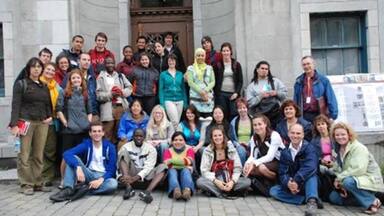

Shutterstock / canadastock
Head-Smashed-In Buffalo Jump
Top choice in Southern Alberta
The story behind this Unesco World Heritage site with the strangest name of any attraction in Alberta is one of ingenuity and resourcefulness – and is key to the First Nations' cultural heritage (and Canada's, too!). The Blackfoot people used the cliffs near the town of Fort Macleod to hunt buffalo when conditions were right. The well-presented displays and films at the interpretive center built cleverly into the hillside are definitely worth the excursion from Calgary or Lethbridge.
You can walk along the cliff trail to the kill site where the bison plummeted, a quiet pastoral overlook that seems incongruously peaceful now. The excellent movie brings a hunt to life in very realistic detail, explaining not only what the Blackfoot did to cause the animals to stampede, but why it was so vital to their livelihood and religious beliefs. The museum is wonderful, with six levels that are designed to be viewed from top to bottom, offering the viewer many interesting explanations of this unique time in North America's past.
The park, about 18km northwest of Fort Macleod and 16km west of Hwy 2, also has a cafe and a shop staffed by Blackfoot First Nations.
Secondary Hwy 785
Get In Touch
403-553-2731
https://headsmashedin.ca
Alberta Travel Ideas
Authentic travel stories from Alberta
Head-Smashed-In Buffalo Jump: History and Visitor Information
December 5, 2016 by albertatravelideas
At one point in our history, more than 60 million buffalo roamed the continent’s Interior Plains including the wide-open grasslands of Alberta’s fertile province, Today, those numbers have perished but Head-Smashed-In Buffalo Jump , located just 18 km northwest of Fort McLeod along highway 785 in the south end of Alberta, is home to the museum of Blackfoot culture and a trip back to a time when the buffalo ruled the area.
The Blackfoot Nation or Niitsitapi, meaning original people, consists of four distinct nations, who share a common cultural and historic background but have separate leadership. The Siksika Nation, whose name literally means Blackfoot, the Akainawa Nation who are also called Kainai or Bloods and the Piikani or Peigan Nation all make Alberta their home. Montana is home to the fourth group, the Blackfeet Nation, that make up this family. Because these nomadic plains hunters shared a common language and culture they worked together to build treaties of mutual defense and very often intermarried. Southern Alberta’s grasslands make for great grazing and in their day, buffalo were drawn to the area in large numbers. Before the modern invention of irrigation, the local soils were much too dry for farming so the Blackfoot peoples relied on their strong knowledge of topography and buffalo behavior to prosper as successful buffalo hunters and for half of the year these nomads would follow the herds. They set up camp in ideal hunting locations, such as at Head-Smashed-In Buffalo Jump , and the Blackfoot people worked together to feed and clothe their families.
On our trip to the heritage site, we started with a walk along the lower trail that wound through the area, once bustling with families setting up base camp in the excitement of what was to come from the great cliff above. And the view up from these lower trails, toward the top of the vast face of the cliff, it is possible to imagine the sights and sound of the spectacle as one after the other; the buffalo would crash down from the great height to their death at the bottom.
Through the camp, a stream that once flowed, clean and fresh, from a nearby spring was the source of water used for cooking and drinking by the Blackfoot people. We could feel the presence of the spirits of both the brave hunters and their powerful fallen prey and the serenity of the grounds made it easy to imagine yourself among the busyness of the community that worked together to share the great task of cutting grinding and pounding all the useful parts of the fallen buffalo into the food and clothing they would need to survive the long, cold winters.
It was in this stream, long since dried up, that the oldest evidence of prehistoric occupation at Head-Smashed-In was found. A rancher, walking along the dry creek bed in 1940 discovered two ancient spearheads called Scottsbluff. The tools, known to date back some 9,000 years, are among the artifacts that can be found in the interpretive center, an unassuming building that that blends naturally into the ancient sandstone cliff.
The Head-Smashed-In Interpretive Center
The Head-Smashed-In interpretive center is a building with five levels of beautiful displays and in-depth history that describe, in vivid detail, how the community of Blackfoot people lived on the land and interacted with the buffalo and other wildlife. It reveals the great stories of the ecology, mythology, lifestyle and technology of the Blackfoot people and the in-depth history lesson blends the viewpoints of the aboriginal people with archaeological science.
The Blackfoot people have two principal deities; the Sun, and a supernatural being known as Napi, ‘Old Man’. Napi taught the Blackfoot people that a group of hunters must be ready at the bottom of the cliff to kill all the buffalo that did not die because of their fall. If any of these buffalo survived the fall according Napi’s stories they would return to their heard and share the story of the great hunt with the rest of the heard who would then be wiser, more informed and less likely to be as easily lead in the future.
By the early 1900’s the buffalo became extinct and the Blackfoot people struggled to find their way of living without them. They eventually turned to farming or cattle ranching and these resilient peoples were able to adapt and they became strong again. There are approximately 14,000 Blackfoot peoples living in the area today.
Hours of Operation
From Labour Day, which is the first weekend in September through to May 14, the hours of operation are 10 a.m. to 5 p.m. daily, seven days a week. The crisp, quiet of the historic site in winter adds to the solemn feeling, but if Southern Alberta winters are too much for you, don’t worry, Head-Smashed-In Buffalo Jump has both indoor and outdoor exhibits. During the summer, from May 15 th to the Labour Day weekend, operating hours are extended by an hour to open at 9 a.m. And the interpretive center is only closed for four days all year; on Christmas Eve, Christmas Day, New Year’s Day, and Easter Sunday, but be sure to check before you head out because severe weather may lead to temporary closures.
The following admission rates are a great value for your money and will provide an experience you will never forget:
Categories Daily Admission
Adult (18-64) $15.00
Senior (65+) $13.00
Youth (7-17 ) $10.00
Child (0-6) FREE
A family pass is available for 2 Adults and up to 6 youths for a price range of $40.00 to $120.00 and Canadian Military and their family, by presenting a CFOne card are entitled to free admission. If you are planning a group tour of 15 or more people, the historic site offers a 20% discount on pre-booked admission. All these prices include G.S.T.
You can purchase an Experience Alberta History Annual Pass and for one full year, you will gain unlimited access to a network of provincial historic sites, museums and interpretive centers around Alberta.
Places to Stay
The area around Head-Smashed-In Buffalo Jump is rich with history and unique experiences and depending on the off-site experience you are looking for, there is something for everyone. Relax at a Bed and Breakfast, stay in a heritage motel or hotel or if you’re up to it there are great camping experiences in the area. The Fort Motel, in Fort McMurray, is only a 18 km trip from the site and an 8-minute walk to the Fort Museum and Empress Theatre and the Fort MacLeod Airport is just 3.5 km away.
Or for a more historic feel, you could become one of more than 500,000 visitors to Pincher Creek each year. Just a 45-minute drive along highway 3 from Head-Smashed-In, the historic town is nestled in the natural beauty of the foothills of the Rocky Mountains and offers a year-round destination.
A little further west along highway 3 and you will find yourself in the Crowsnest Pass and more great accommodations as well as a whole new vacation’s worth of amazing history and scenic tours, but that is a story for another day.
Authored by Caroline Steman .
Explore Alberta with us!
Subscribe to our monthly email newsletter and get travel ideas right to your inbox.

Digitally Preserving Alberta's Diverse Cultural Heritage
Head-smashed-in buffalo jump.
Head-Smashed-In Buffalo Jump is an important historic site to the Blackfoot people, and is designated as a Provincial Historic Resource, National Historic Site, and UNESCO World Heritage Site located in Southwestern Alberta. The significance of this site lies within its historical, archaeological, traditional, and scientific value. The archaeological layers of this site indicate use by the Indigenous Plains nations stretching back at least 6,000 years. Head-Smashed-In is one of the oldest, most extensive, and best-preserved examples of a buffalo jump in North America. Overall, this site and the surrounding landscape is a hugely valuable representation of this traditional hunting method used by Plains Nations until the late 19th century.
Southwest Alberta
Field Documentation:
October 12, 2019
Field Documentation Type:
Photogrammetry
Historic Period:
-113.655234
Datum Type:
Threat Level

The Blackfoot
Buffalo, or more properly named plains bison, have always been an essential resource to the

The term “Blackfoot” actually refers to four Nations/Tribes which compose the Blackfoot Confederacy, or Siksikaitsiitapi : Amsskapipiikunniwa (Blackfeet Tribe) located in northern Montana, U.S.A., Kainaiwa (Blood Tribe), Siksikawa (Siksika Nation) and Aapatohipiikunniwa (Piikani Nation), located in southern Alberta, Canada [1]. Today, the Blackfoot Confederacy accounts for 25% of the Indigenous population of Alberta with a local population of 22,000 and a population of 45,000 for all of North America [1].
The Blackfoot traditional way of life was interrupted with the arrival of the North West Mounted Police in 1874 and then further disrupted with the near extinction of the North American bison in 1881 [2]. Tens of millions of buffalo had once roamed over the plains of North America, but with the arrival of Europeans came over hunting for resources and sport; the populations of bison rapidly declined to nearly nothing. Until then, the bison were not only a staple subsistence resource but a fundamental part of Blackfoot culture.
According to Blackfoot oral tradition, as Old Man traveled, he created the mountains, rivers, grass, and trees [3]. When he came to the present-day Porcupine Hills, Old Man formed the images of people from mud and breathed life into them. When the people asked what they would eat, Old Man created images of buffalo from clay and brought them to life as well. Old Man then took the people to a rocky ledge and called to the buffalo who ran over the cliff and said “Those are your food” [3].
Buffalo Jumps
A buffalo jump, or pishkun , refers to land formations that were culturally used to mass-hunt plains bison in North America. The way that the jumps worked were through utilizing the landscape and mentality of the bison to run them off of a cliff, where they would either die from the impact or be immobilized and more easily killed by people.
This type of hunting was a communal endeavour. Before the use of horses, bison would be gathered into a natural basin formation that was above the main cliff or jump [3]. From the gathering basin, “buffalo runners” dressed in buffalo or wolf hides would guide the animals through the basin towards the drive lanes which lead up to the cliff itself. Drive lanes would be marked by rock cairns and piles of brush and were used to direct the bison herd toward the cliff once a stampede was started [3].

This method of hunting has been called “the most product food getting enterprise ever derived by human beings” as a single jump could yield over 80,000 kg of edible meat [3]. Once the jump event was over, it would be a massive communal effort to process the animals. Fresh meat was one benefit, but other parts of the bison would be used as well. Bladders and stomachs could be used to produce the bags for boiling pits; hides could be turned into furs for the winter or processed into leather for a variety of uses. Meat was also dried and mixed with fat and berries to create pemmican. This was an invaluable food source across the plains as it contained the protein, nutrients, and high calories of its ingredients in a preserved form that could last through the winter and be easily transported as people moved through the landscape.
Head-Smashed-In
The Head-Smashed-In Buffalo Jump is located in Southern Alberta, approximately 20km northwest of Fort MacLeod and in the heart of the Blackfoot Nation’s traditional territory [3]. It represents one of the best persevered buffalo jumps left in the area. The bones of the bison are high in potassium, and bone mining was a profitable industry through both World Wars, the droughts throughout the 1920s, and the Great Depression [4]. Excavated both with hand tools and mechanized equipment, kill sites throughout Alberta, Montana, and North Dakota were heavily exploited for sale to commercial fertilizer manufacturers [3; 4]. Coupled with looting for artifacts, many large kill sites were thoroughly destroyed in the early half of the 20 th century [4].
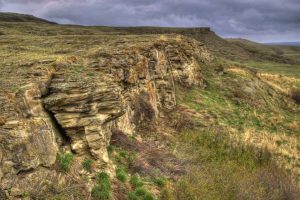
This site is 1,470 acres that include portions of the gathering basin, the drive lanes, the cliff, and the processing area [2]. Archaeologically, the site contains a wide variety of cultural remains associated with this method of communal hunting. These remains include cairns from the drive lanes, stone weapons and tools such as projectile points, whole and butchered bison bones, fire broken rock, as well as artifacts from meat processing and camp life in the fields below the cliff [2].
The cultural remains not only preserve evidence of periodic ways of life, but the evolution of tools and methods associated with this hunting technique. The archaeological evidence indicates the jump was used by at least 6,000 years ago, and that other hunting methods were used in this area as far back as 10,000 years ago [2]. Except for one interval, this site was used continuously for bison hunting throughout that time frame. This attests not only to the skill of the hunters and the importance of large-scale bison kills to the people of the plains, but also to the suitability of the Head-Smashed-In jump. The 300 m long cliff is now 10 m high at its tallest point, but this sits over archaeological deposits over 10 m deep and when in use, the cliff would have been over 20 m high in some locations [2; 3].
While it is a particularly well-preserved example of a buffalo jump and a protected site, Head-Smashed-In Buffalo Jump is still subject to natural and human threats [6]. With increases in more extreme weather events, there has been a noticeable increase in erosion of the site. This has been most evident on the cliff-face where portions of rocks have fallen off in recent years, leading to temporary closures of the pathways below the jump.
Increases in tourism also pose an erosional threat to the site as larger numbers of visitors can contribution to the degradation of pathways, especially those along the top of the jump [6]. Access to the property is controlled and movement throughout the site is restricted to mark pathways in order to minimize these impacts [6].
This page has been created in collaboration with individuals from Head-Smashed-In Buffalo Jump. Many thanks are extended to them for their help in editing, providing cultural knowledge, and verifying the information contained within this page.
This site is located on Treaty 7 Territory of Southern Alberta, which is the traditional and ancestral territory of the Blackfoot Confederacy: Kainai, Piikani and Siksika as well as the Tsuu T’ina Nation and Stoney Nakoda First Nation. This territory is home to the Métis Nation of Alberta, Region 3 within the historical Northwest Métis Homeland. We acknowledge the many First Nations, Métis and Inuit who have lived in and cared for these lands for generations. We are grateful for the traditional Knowledge Keepers and Elders who are still with us today and those who have gone before us. We make this acknowledgement as an act of reconciliation and gratitude to those whose territory we reside on or are visiting.
[1] Blackfoot Confederacy. 2020. History & Purpose . Electronic document, http://blackfootconfederacy.ca/history-purpose/ , accessed on July 16, 2020.
[2] UNESCO 2020. Buffalo Tracks: Educational and Scientific Studies from Head-Smashed-In Buffalo Jump. Electronic document, https://headsmashedin.ca/sites/headsmashedin/files/editor_files/Buffalo%20Tracks.pdf , accessed on July 10, 2020.
[3] Kristensen, Todd. 2016. Blood Kettles and Buffalo Jumps: Communal Hunting of the Plains of Alberta . Electronic document, https://albertashistoricplaces.com/2016/06/08/blood-kettles-and-buffalo-jumps-communal-hunting-on-the-plains-of-alberta/ , accessed July 13, 2020.
[4] Davis, Leslie B. 1978. The 20 th Century Commercial Mining of Northern Plains Bison Kills. Plains Anthropologist 23(82):254-286.
[5] Head-Smashed-In Buffalo Jump World Heritage Site. Electronic document, https://headsmashedin.ca/ , accessed July 7, 2020.
[6] UNESCO. 2020. Head-Smashed-In Buffalo Jump . Electronic document, https://whc.unesco.org/en/list/158/ , accessed July 12, 2020.
Photo Gallery
These photos show photos of Head-Smashed-In Buffalo Jump at various points in time, as well as related images. Images have been sourced from The Blackfoot Confederacy , Head-Smashed-In Buffalo Jump World Heritage Site , a post from the RETROactive by Todd Kristensen, and the Capture2Preserv Team.
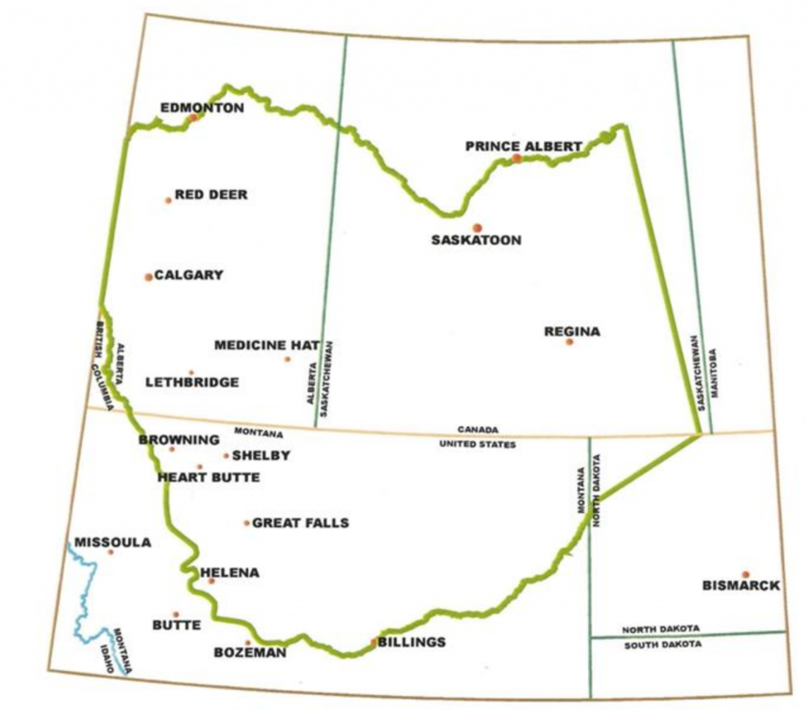
Capture Techniques
Digitally capturing head-smashed-in buffalo jump.
Working in partnership with the Historic Resources Management Branch, this project was conducted by the School of Construction, Southern Albertan Insitute of Technology (SAIT). Two different surveys were conducted. A photogrammetric survey was conducted with a DJI Matrice 210 RTK drone with a DJI D-RTK 2 mobile station for real-time differential corrections covering the Head-Smashed-In Interpretation Centre and Buffalo Jump. The drone was flown with Pix4D Capture in nadir polygonal mission and the data processed in Pix4D Mapper producing an orthomosaic and Digital Surface Model (DSM). The terrestrial laser scanning (TLS) survey was conducted with a Leica C10 and a Licea BKL 360 and the data processed in Licea Cyclone. This survey covered the kill site trail and the top of the buffalo jump cliff face. To provide control points for both surveys a GPS survey was conducted with a Lecia GS14 Rover and base kit located on an Alberta Survey Control Marker (ASCM).
Laser Scanning and Photogrammetric Data
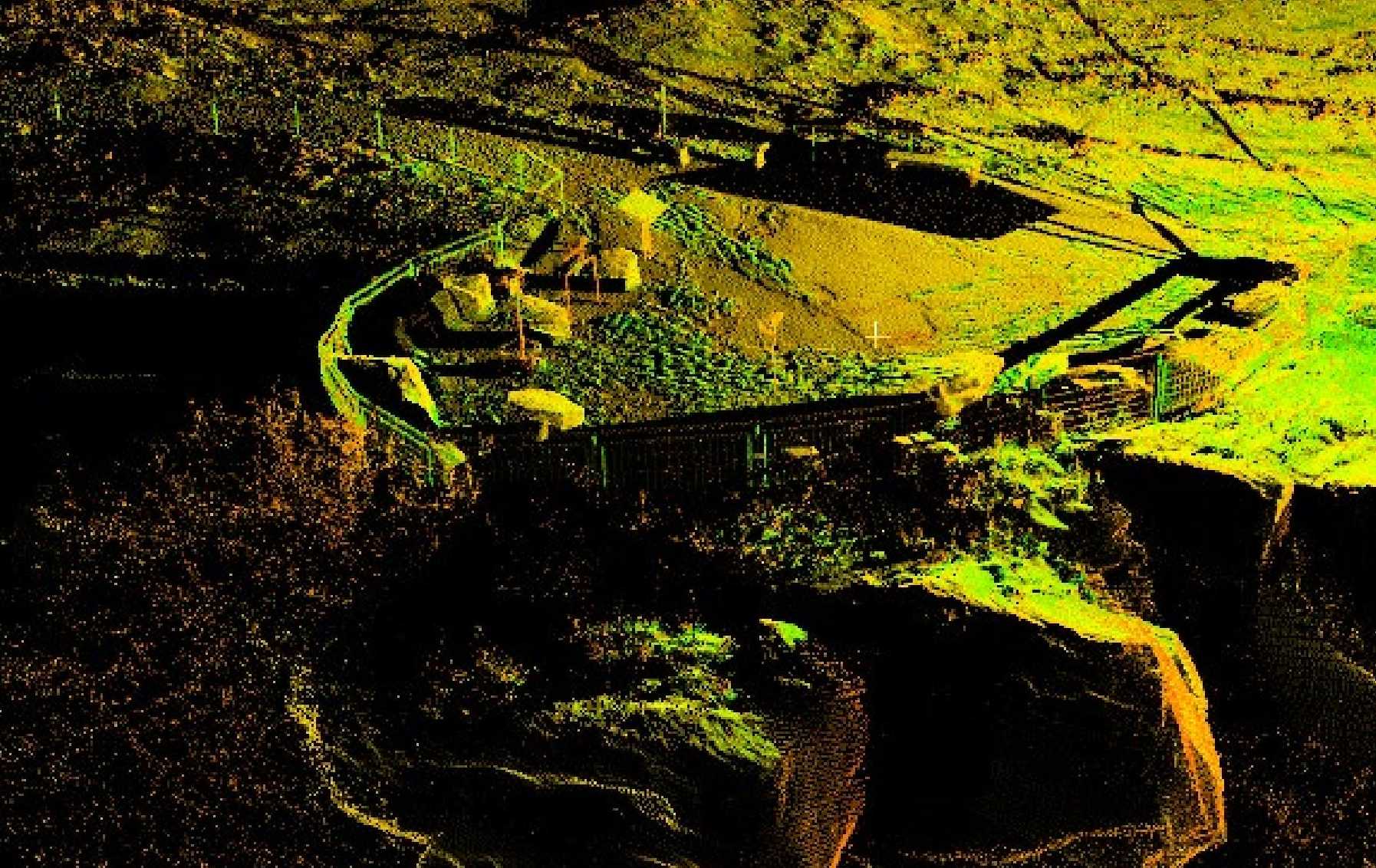
Open Access Data
This dataset was donated to the Alberta Digital Heritage Archive by Rick Duchscher, P.L. (Eng.), P.Tech. (Eng.), Centre for Innovation and Research in Unmanned Systems, Geomatics Engineering Technology, School of Construction, Southern Alberta Institute of Technology (SAIT).
The raw data files for this project are available for download from the archive repository. There are two file formats available: 3D point cloud in a .las file format and the orthomosaic tiles in world tiff file formats. Please download the metadata template to access metadata associated with each file. All data is published under the Attribution-Non-Commercial Creatives Common License CC BY-NC 4.0 and we would ask that you acknowledge this repository and data collectors in any research that results from the use of these data sets. The laser scanning data can be viewed and manipulated in CloudCompare an opensource software.
Head-Smashed-In UAV Photogrammerty Orthomosaic Data Set
Head-Smashed-In UAV Photogrammetry Metadata
Head-Smashed-In Laser Scanning Data Set
Head-Smashed-In Laser Scanning Metadata
Why A Visit to Head-Smashed-In Buffalo Jump in Alberta is a Must-See
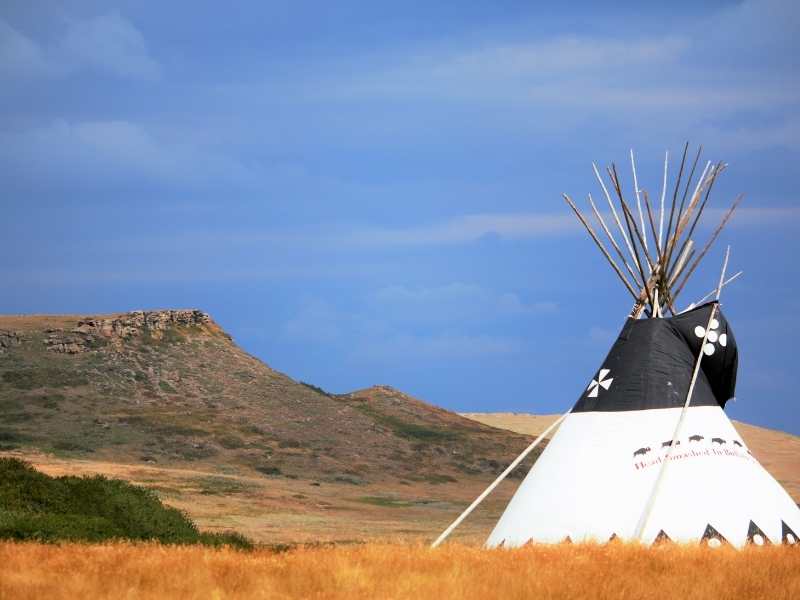
Head-Smashed-In Buffalo Jump is a UNESCO World Heritage Site and one of the best-preserved buffalo jumps on the planet. It’s a must-see stop when you visit Alberta, Canada.
Table of Contents
What is a Buffalo Jump?
Head-Smashed-in Buffalo Jump is one of the largest and best examples of a buffalo jump on the planet. There are only a few in Canada and the U.S.
Buffalo jumps are a foreign concept to many people living outside of Canada and the U.S. But they’re the best example of a communal hunting technique, plus they’re pretty fascinating.
A buffalo jump was a means of killing a lot of buffalo at one time. This was necessary for food over the winter when it was especially scarce. The Blackfoot (a North American indigenous people) would round up the buffalo into a driveline. They would literally drive the buffalo over a cliff.
By the time the buffalo realized what was happening they couldn’t stop since they were going so fast and with a stampede of buffalo right behind them. They would plunge over the sandstone cliff to their deaths (hence the term “buffalo jump”).
If they did survive the 10 m-high cliffs, they would have a broken leg or two making them immobile and the Blackfoot would put them out of their misery shortly.
Related Reading: Writing-On-Stone: Your Guide to Exploring This Treasure in Alberta, Canada
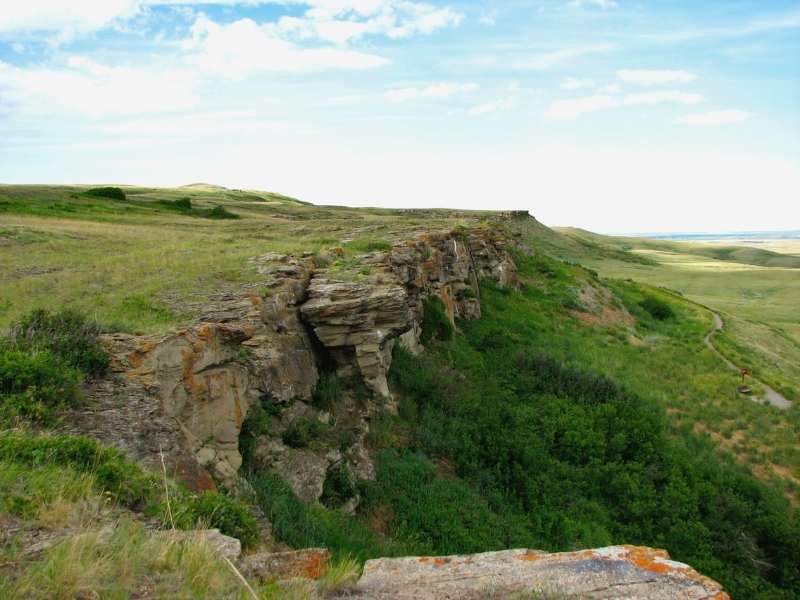
A Successful Buffalo Jump Meant Survival
At first glance, a buffalo jump may sound rather barbaric, but it was a matter of survival. A successful jump meant your family lived through a long harsh winter. Winter temperatures would easily reach (and still do) -30 C and colder.
An unsuccessful jump meant your family starved. Furthermore, the Blackfoot used all parts of the buffalo. Tools were carved out of buffalo bones. And the buffalo coats provided warmth against the frigid winter winds.
Wind protection was especially important. Winds frequently topped over 100km/hour, at below-freezing temperatures. I know, I grew up in Pincher Creek, not far from the buffalo jump. Trust me when I say the winds are legendary.
However, a buffalo jump is not as simple as it sounds. Buffalos are surprisingly smart animals. Planning a buffalo hunt could take months. Every detail had to be analyzed to ensure it all went right.
To get to the formed drive lanes for them to jump, they would slowly direct a herd of buffalo from the gathering basin. It’s not as easy as it sounds. A strong understanding of animal behavior especially the buffalo was required for the buffalo jump to be a successful hunt.
Related Reading: The Rocky Mountains Canada: The Best Adventures For Everyone

The End of The Buffalo Jump
This Buffalo Jump World Heritage Site was in use for almost 6000 years until ~ 110 years ago. Then the Euro-Canadian settlers came and virtually wiped out almost all of the buffalo population which left a negative impact on the natives.
They hunted them with rifles for their warm coats leaving thousands of buffalo carcasses to rot and wasting most of the buffalo. I’m ashamed to think of how devasting this must have been for the Blackfoot and what they thought of the settlers.
Today, it is an amazing venue for the historical sites of those who once occupied the area. It’s such a beautiful hike with a wide variety of plants everywhere you look. Archeological evidence also showcases vast quantities of bones, cultural deposits of the indigenous culture, and the extreme skills and knowledge of the native people.
Visiting Head-Smashed-In Buffalo Jump:
- Head-Smashed-In Buffalo Jump is open Monday – Sunday from 10 am to 5 pm daily. There’s a large interpretive center and a Blackfoot Museum.
- There is a small theatre showing scenes from history. It plays a 15-minute re-enactment of the buffalo hunt throughout the day. I recommend watching this to get a better idea of how it worked.
- Make sure to explore the indoor and outdoor exhibits. The exhibits are entertaining and informative and will make your experience better. I love the outdoor exhibits where you can see the buffalo jump.
- At the top of the building is a short paved trail that gives you great views of the Buffalo Jump Cliff, Calderwood Buffalo Jump, and the Rocky Mountains.
- There is also an interpretive trail you can arrange to go on. This interpretive hike at the cliff base was very enjoyable. It gives you an active way to walk on the actual jump site and enjoy the beauty of this historic site.
- For admission, information click here .
- Book a tour here .
Getting to Head-Smashed-In Buffalo Jump
Head-Smashed-In Buffalo Jump is off the beaten path (which is one of the things I like about it). It is ~ a 3-hour drive from Banff National Park. lt lies between the small towns of Pincher Creek (my home town) and Fort McLeod.
Recommended Reading: The Best Way to Experience Castle Provincial Park in Alberta
What Other Attractions Are Near Head-Smashed-In Buffalo Jump in southern Alberta?
If you’re interested in buffalo, then I’d recommend visiting the Bison Paddock in Waterton National Park.
I NSIDER TRAVEL TIP FROM AN ALBERTAN: This is a gorgeous drive but you don’t always get a great view of the bison. It really depends on where they are.
Located just inside the Park’s northern boundary, off Highway 6 (the “Bisons Pasture Loop Road”), the Bisons Paddocks provide an excellent chance to see wild bisons in their native prairie environment. During the summer months, visitors may drive along the loop road and watch the bisons grazing in the open pastures. The short, scenic route passes by fescue grasslands within the Park’s summer paddocks. The bisons are free to roam the enclosures.
UPDATE: Due to a park fire the bison have been removed. They plan to bring them back but that date hasn’t been announced yet. Check before you visit.
Besides the bison paddock, Waterton is worth seeing in itself. It’s a UNESCO World Heritage Site and one of my favorite places on the planet. If you like nature and the outdoors you’ll love it. A can’t-miss highlight is Redrock Canyon a very easy flat walk and a good place to spot Bighorn sheep.
I also love Castle Provincial Park . There are ample hiking, camping, and various outdoor activities you can do here. The main visitors are locals which is one reason I love it.
You’ll also want to visit Frank Slide , the deadliest rock slide in Canada. You can hike up to Turtle Mountain or visit the interpretive center which offers a mind-numbing view of the rock slide.
The Kootenai Brown Pioneer Village in the town of Pincher Creek (en route to Waterton) is also worth a visit. The highlight is the collection of heritage buildings that date back to the late 19th century that you can wander through. It gives you a good sense of what life was like for the pioneers. Admittedly, I’m not much of a museum person, but this is a good one.
Visit the Fort Museum in the town of Fort McCleod to see what life was like for the Northwest Mounted Police and First Nations Interpretive Center. INSIDER TRAVEL TIP FROM AN ALBERTAN: Try to time your visit to see the Musical Ride.
Further east of Lethbridge is Writing-On-Stone Provincial Park . It features hoodoos with paintings from Blackfoot and is also a UNESCO site.
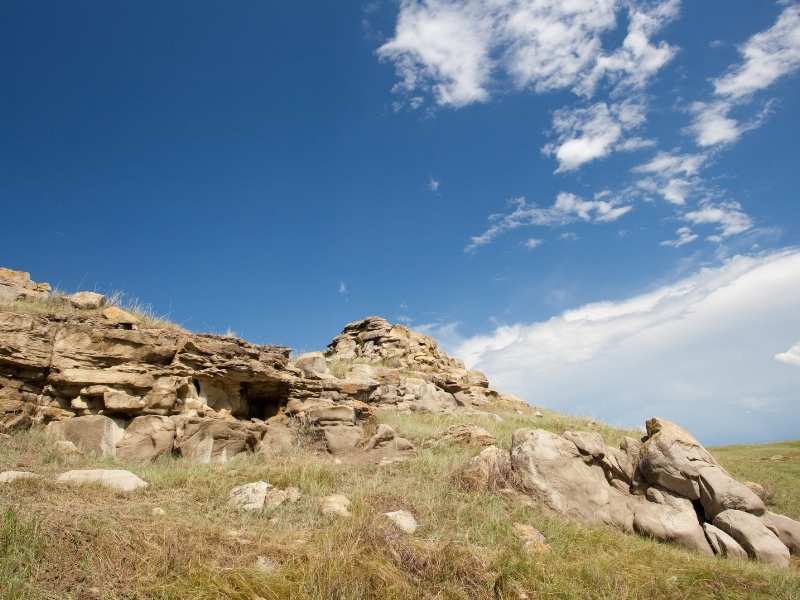
Itinerary for Visiting the Buffalo Jump and Other Attractions in southern Alberta
If you’re coming from Calgary, I’d recommend heading to Head-Smashed-In Buffalo Jump, then Pincher Creek, then Waterton National Park, and spending the night there. If you want to hike, plan for several days there.
Accommodations are often hard to find around Waterton so a gorgeous alternative is to stay in Castle Provincial Park or around Lundbreck if you’re going to go to Frank Slide. Check out the map below for Airbnb properties.
Then, the next day drive to Castle Provincial Park if you wanted to do some hiking or outdoor adventures, before continuing on to Frank Slide in the Crowsnest Pass. You can either visit the interpretive center or climb up the mountain for a very unique hike.
Then, you could visit Fort McCleod on either the way back to Calgary or on your way to Lethbridge if you were planning to visit Writing-On-Stone Provincial Park. If you’re planning on doing the latter, I recommend either staying the night in Lethbridge or camping in Writing-On-Stone Provincial Park as it would be a long day to do both.
Most visitors to Alberta head to Banff and Jasper, which are amazing but in my humble opinion, Head-Smashed-In Buffalo Jump is also worth a visit to explore this lesser-seen part of Alberta.
This post has been updated and republished..
You Need to Visit Alberta's Six UNESCO World Heritage Sites

Reading time: 3 minutes
No matter where you travel in Alberta, you won’t be far from one or more of the province’s famous UNESCO World Heritage Sites – these amazing sites are well worth a visit.
- UNESCO recognizes over 1,000 World Heritage Sites around the world.
- Alberta has the most UNESCO World Heritage Sites in Canada.
- You can easily visit all of Alberta’s UNESCO Sites.
Alberta is home to six UNESCO World Heritage Sites – more than any other province in Canada. These iconic spots, designated for preservation due to their significance to Alberta’s history and culture, are a must to add to your Alberta itinerary.
Canadian Rocky Mountain Parks
Alberta's Rocky Mountains are stunningly beautiful. The Canadian Rocky Mountain Parks UNESCO World Heritage Site includes Banff and Jasper National Parks in Alberta, as well as the Yoho and Kootenay National Parks in British Columbia. These parks received the UNESCO designation in 1984. Visiting the Rockies is an amazing experience any time of year. Hit the slopes and do some skiing or snowboarding in the winter. In the summer, explore this vast wilderness by camping, hiking, climbing, whitewater rafting or horseback riding – just like a true Canadian. Or, stay in a resort and enjoy the perfect scenery from the lap of luxury.

Dinosaur Provincial Park
The scenery throughout Dinosaur Provincial Park is out of this world. Dinosaurs used to roam around this area some 75 million years ago when it was a subtropical paradise. Now it is dry and desert-like, with quirky hoodoos (tall spires of eroded rock) and wind-swept coulees. More than 150 full dinosaur skeletons have been discovered in Dinosaur Provincial Park, which became a UNESCO World Heritage Site in 1979. Book a guided hike to experience the Canadian Badlands for yourself – and keep an eye out for fossils along the way.

Head-Smashed-In Buffalo Jump
This is one of the world's oldest and best-preserved buffalo jumps. Indigenous hunters used the buffalo jump for nearly 6,000 years. You can tour the storied cliffs with an Indigenous guide to learn more about the history and importance of Head-Smashed-In Buffalo Jump , which became a UNESCO World Heritage Site in 1981. Don't miss the on-site interpretive centre nestled right into the cliffside.

Wood Buffalo National Park
The buffalo roam in Wood Buffalo National Park – literally. This remote park in northern Alberta covers a staggering 44,807 km 2 (27,842 mi 2 ), making it the largest national park in Canada. That's over twice the size of Maryland. The park, which was named a UNESCO site in 1983, is home to a lush boreal forest and abundant wildlife. Over 3,000 free-range bison live here, along with wolves, bears, moose, owls and the very rare whooping crane. Wood Buffalo is a sky-watcher's paradise as the world's largest dark sky preserve. Stay up late and watch dancing aurora borealis and other wonders of the night sky.

Waterton-Glacier International Peace Park
Alberta's unforgettable mountain scenery goes all the way south to the Waterton-Glacier International Peace Park . The park extends across the U.S. border into Montana. Book a trip with Waterton Shoreline Cruise Co. and visit both countries in a single day. Waterton became a UNESCO World Heritage Site in 1995. It's an outdoor oasis of sparkling lakes (great for stand-up paddleboarding and canoeing), colourful wildflowers, iconic hiking trails for all experience levels and plenty of wildlife. Don't miss a visit to Red Rock Canyon, Blakiston Falls and the historic Prince of Wales Hotel, which overlooks the expansive lakes for Instagram-worthy views.

Writing-on-Stone / Áísínai´pi
This park is Alberta's newest UNESCO World Heritage Site and received its designation in 2019. The Indigenous name for Writing-on-Stone is Áísínai´pi, which means “it is pictured / written” in Blackfoot. The area is full of amazing hoodoos and is very important for many Indigenous cultures, who have visited here for over 10,000 years. There are many Indigenous stories about the area being inhabited by spirits who write their truths on the rocks. Take a guided tour to see one of the largest concentrations of petroglyphs (rock carvings) and pictographs (rock paintings) in North America.

Last modified: Apr 9, 2024
Article Tags
Modal heading.
Head-Smashed-In Buffalo Jump – Facts and How to Visit
Visit Head Smashed In Buffalo Jump and learn about the Plains People and their efficient buffalo hunt which ensured their survival through the harsh prairie winter. This UNESCO World Heritage Site, 2 hours south of Calgary, Alberta Canada, shows evidence of use for over 6,000 years. UNESCO recognizes it as one of the most outstanding and well-preserved buffalo jump sites in North America.
Table of Contents
What will I see at Head-Smashed-In Buffalo Jump?
Learn about use of vertical cliffs found in the North American prairies in a bison hunting system employed by communities of Early Plains Peoples. The site has:
- A world-class Interpretive Centre ,
- Cliff-top trail to see the grasslands and bison drive lanes , and
- Trail to the kill site at the cliff base where the community gathered to process the killed animals.
Spend a couple hours discovering this historic place.
Interpretive Centre
The exhibits in the modern 5-level centre tells the Head-Smashed-In Buffalo story and how the location was central to the survival of the area’s Early Plains People for thousands of years. The displays helped us understand the culture, ceremonies and the family life of the ancestors of the Blackfoot Nation.

Learn about the bison hunt; the preparation, the tools used, and how the bison was processed into useful items for the community. For a better understanding of how these large hunts were carried out, watch the feature film in the theatre.
The best way to slaughter large numbers of bison in one hunt was to force them to “jump” over a sheer cliff. A successful hunt of this type required a large, communal and organized effort.
What makes a good Buffalo Jump?
An efficient jump site has a sheer cliff or ridge line with an open plateau of prairie grassland behind it. Hundreds of bison stampede unknowingly to the cliff edge and fall over the precipice, landing in a heap at the base of the cliff. The Plains people used these steep cliffs to efficiently kill bison in mass quantities, ensuring the survival of the entire community.
Buffalo Hunt
Preparation started days before the hunt. On the plateau, the people constructed cairns which were piles of rock and brush. Cairns were placed 5 to 10 meters apart, in 2 lines, in the shape of a funnel. The v-shaped lines of cairns created a drive lane for the buffalo. Due to its limited vision, the bison perceive these lines of cairns as solid walls.
Once the drive lane was constructed, the hunt could begin. Buffalo runners were brave young men. They slowly directed a herd of bison from the gathering basin and into the formed drive lanes.
As the herd moved deeper into the funnel, the buffalo runners intentionally startled the animals into a stampede. Unable to see the edge of the cliff, the buffalo fell over, in the hundreds.

Why did the Buffalo Stampede? Bison are social animals. They gather in tight herds for protection. When they sense or smell a threat, such as a wolf or human hunter, the lead animal moves quickly and the rest of the herd automatically follows, causing a stampede.
Spring Buffalo Hunting? Most of the large hunts occurred in the summer and fall, after calving season. While the Plains People did conduct hunts in the spring, the calving season had more risks. The cow buffalo are very protective of their young calves. This maternal instinct makes their behaviour hard to predict. Regardless, the people proceeded with their hunts as new calves were considered a delicacy. The people were also hungry for fresh meat after surviving the winter subsisting mostly on stored food and the small amount of fresh meat provided by infrequent winter hunts.
Processing the kill A successful hunt resulted in several hundred buffalo being run over the cliff. Once the buffalo lay dead at the base of the cliff, the work had just begun. The carcasses needed to be processed quickly.
Using sharp stone knives, the buffalo were skinned and butchered. The most nutritious parts, the tongues and internal organs, were considered delicacies and were eaten raw. Huge cuts of meats were cooked in boiling water. The boiled meat was dried and mixed with berries and fat to make pemmican which was their primary protein source for the winter. The hunters returned to this cliff site year after year.
Head-Smashed-In Buffalo Jump Site
The geography of area makes Head-Smashed-In Buffalo Jump the perfect site for hunting bison.

Head-Smashed-In Upper Trail
The trail follows the upper cliff edge. Look back to the prairie grasslands where bison once grazed. This trail begins at the Interpretive Centre’s upper exit.

Huge herds of buffalo roamed these rolling hills and plains which were covered with short, mixed grasses. In summer, there was water in the nearby creeks and the grasses were generally thick and nutritious.

Grasslands occasionally burn due to natural causes, such as lightning strikes. Fire clears overgrowth and more nutritious grasses grow the following season. The Plains hunters understood this and intentionally lit fires to ensure that the bison would return in successive seasons.
Hidden Cliff
The area at Head-Smashed-In was an ideal jump site. Bison grazed on grasses in the gathering basin. Drive lanes were easily constructed pointing towards the cliff, which was hidden by a slight rise. Under favourable conditions, with the wind blowing toward the cliff, the buffalo did not sense the impending danger at the edge of the cliff.

There is archaeological evidence that at one time this cliff was 20 meters high. Today, it is only 10 meters.
Head-Smashed-In Lower Trail
Walk beneath the cliffs along the 1.2 km interpretive trail to see where the hunt ended at the cliff-based kill site. The community’s temporary camp was set up near here.

At the cliff base, beneath the soil layer, there are 10 meters of rubble consisting of buffalo bones and stone tools. Radiocarbon dating of this rubble indicates that this site was used for approximately 6000 years.

Spring Channel
A readily available water supply was important to the hunters. The Spring Channel at Head-Smashed-In was a natural spring that seeped out from the sandstone cliffs. This provided easily accessible drinking water. However, and almost more important, the water required for the task of butchering and cooking vast quantities of buffalo was close by. Today, the spring has moved below surface. Evidence that this vital spring channel was above ground provides another reason why Head-Smashed-In was used as a successful site for so many years.
Oldman River Valley

The Plains People lived year-round in the Oldman River Valley. The Oldman River, just three kilometres from Head-Smashed-In, was an ideal permanent home area to return to after a hunt. The area had water year-round. There was quartzite rock for stone boiling to finish the processing of the meat. Animal hides were tanned here as well. Lodges were built and wood was available nearby, to provide warmth to survive the harsh prairie winter.
Early Plains Peoples
Thousands of years ago, the People arrived from Asia. They migrated for generations following game to survive. Once they arrived on the Northwest Plains, they depended on the buffalo to provide their food, clothing and tools. Hunting buffalo on foot on the open plain was difficult. It was more efficient to organize communities to pursue the herds for the hunt. This cooperation was the key to their survival.

Families and Bands
A family unit was a man, his wives, children and elders. Multiple families lived, worked and travelled together, in bands of about 50 people. Several bands would join together at large camps during the summer. They traded and participated in ceremonies and celebrations. They also joined together for buffalo hunts in areas like Head-Smashed-In. The goal was to butcher enough buffalo to satisfy the needs of the community and create stores for the long winter months.
Nomadic Lifestyle
For thousands of years, the Plains People moved with the herds and the seasons. Their housing needed to be easy to transport. The tipi was the perfect structure. A large tipi typically housed a family of 6-8 members. The sides of this portable dwelling were tanned buffalo hides sewn together. The hides were draped over a frame of straight poles. Rocks were placed around the outside of the hides, to support the tipi.

To move the tipi, the hides were taken down and bundled onto a travois, essentially a sled, made from the tipi’s poles. For many thousand of years, dogs were used by the Plains People to drag the travois to the next camp. The men and women would carry their remaining possessions on their own backs. Today, rings of rocks that supported the tipis can still be seen across the prairies.
Know Before You Go – Head-Smashed-In Buffalo Jump
How much time should i spend at head-smashed-in buffalo jump.
Allow at least two hours to explore Head-Smashed-In Buffalo Jump to learn about these early people and how the bison was central to their way of life.
How far is Head-Smashed-In Buffalo Jump from Calgary?
The site is about a 2 hour drive (175 km) south of Calgary.
Why is it called Head-Smashed-In Buffalo Jump?
An information panel at the Interpretive Center notes the following:
“According to Blackfoot legend, a young boy wanted to witness the plunge of buffalo as his people drove them to their deaths over the cliffs.
Standing under the shelter of a ledge, he watched the great beasts fall past him. The hunt was unusually good that day. As the bodies mounted, he became trapped between the animals and the cliff. When his people came to do the butchering, they found him with his skull crushed under the weight of the buffalo carcasses. Thus, they named this buffalo jump “Head-Smashed-In”.
Are the animals called “buffalo” or “bison”?
In North America, these animals are properly called bison. The term buffalo comes from the old world term that refers to the African or Asia buffalo.
Is there camping near Head-Smashed-In Buffalo Jump?
Fort MacLeod, located 15 minutes to the east, has several campgrounds, including River’s Edge RV Park & Campground
What are the hours of Head-Smashed-In Buffalo Jump?
Hours vary from summer to winter. Check the Head-Smashed-In Buffalo Jump website for details.
For more great Alberta destinations, be sure to check out our article Best Alberta Road Trips .

Interested in more Itineraries? Sign up here.
(No spam. Just great travel tips.)

Valerie Vanr
Valerie is the Co-founder of AvrexTravel.com. Val enjoys travel photography and writing informative City Walking tours.
- Skip to main content
- Skip to primary sidebar
- Skip to footer
Must Do Canada
The Best Things to Do in Canada
Three Ways to Experience Head-Smashed-In Buffalo Jump, Alberta, Canada
July 18, 2018 By Matthew G. Bailey 2 Comments
Sharing is caring!

For anyone interested in First Nations culture, I can hardly think of a better place to visit than Head Smashed In Buffalo Jump . In fact, it’s so special that it’s one of Canada’s 19 UNESCO World Heritage Sites, helping to preserve more than 6,000 years of Blackfoot cultures and traditions that happened here in the North American plains.
Upon arriving at the site, it doesn’t look like much, which is actually a good thing. The amazing architect who designed the building did so by building it right into the Earth, allowing it to provide visitors with an incredible interpretative centre without taking away from the natural area around it. It’s such a great design that it won the Governor General’s award for Architecture back in 1990.
Upon entering the interpretive centre, we knew we were in good hands. Everyone was so friendly. They joked around and took pride in their heritage. The museum has a variety of artifacts and displays, as well as a wonderful movie that re-enacts the buffalo hunt, a must-see for anyone visiting the site. This will help make the jump come alive for you. Without watching the movie or taking a tour, it would just look like a cliff. You’d lose the magic that comes from knowing the history that made this into one of the world’s 1,000+ World Heritage Sites.
( For a more in-depth look into the Piskun experience, read the article we wrote for ZenSeekers: Put on a Buffalo Hide and Run with the Pack at Head-Smashed-In Buffalo Jump )
Three Ways to Experience Head-Smashed-In Buffalo Jump

There are a variety of ways to experience Head-Smashed-In Buffalo Jump. From guided tours to full-on unique experiences, the interpretive centre has developed many ways to get visitors involved. Here are three ways to get the most of your visit.
Take a General Tour
If you happen to miss one of the tours or just feel like doing it at your own pace, a general tour is still a great option. Before going out to see the actual cliff where the buffalo ran off, take your time to watch the buffalo jump re-enactment video and spend an hour or more looking at the various artifacts and exhibits, and learning about the culture. It will really help liven up the experience for you. Then you can go out and see the cliff while having the background knowledge to see it for what it once was. It’s beautiful.
Piskun, the Buffalo Jump
This 3-hour immersive experience takes visitors back in time to learn the basics of buffalo hunting, get deeper into the Blackfoot culture, and get a much better appreciation of the site. First, an elder gives everyone a traditional Blackfoot blessing, a truly special and heart-warming experience in and of itself. You’ll then move out into the museum to get some insight into what this site is all about. We learned about the teepee’s, the wolves they tamed and used for work, the types of food they ate, and how they survived as a community, despite the harsh conditions of the prairies. We then moved outdoors to see the actual buffalo jump, where hundreds of thousands of buffalo were herded off the 36-foot cliff and to their demise throughout the centuries. What’s truly incredible about the buffalo jump, however, is how they managed to do it. Next, you’ll get to go down to an area below the cliff to dress up like a buffalo or a wolf for a chance to re-enact the buffalo jump in a light-hearted way. You’ll also get the chance to throw an arrow and have a look at various tools and weapons they used back then. If it’s happening on the day you arrive, we highly recommend it.

Hike to the Drive Lanes
Anything you can do with a guide is a special experience. It’s a great way to meet people from the Blackfoot culture and ask them any questions you might have. You’ll also get to hear stories first hand and leave with a much deeper experience. One of these experiences is called “Hike to the Drive Lanes”. A guide takes visitors to the place where the plains people hunted the mighty buffalo, partaking in a 4-hour off-trail hike. Both the Piskun experience mentioned above and the hike are not offered every day so check in advance if it’s something you’d like to do. For anyone interested in indigenous culture, this is one of the top fun things to do in Alberta.
One of Alberta’s Top Attractions
Whether you take in one of the unique experiences offered or just browse the museum at your own pace, Head-Smashed-In Buffalo Jump will easily become one of the most interesting places you’ve ever visited and is one of the best things to do in Alberta . Between the uniqueness of the area, the skill of the buffalo hunt, the wonderful presentations offered throughout the interpretative centre, or the general awesomeness of the staff, this is an absolute must-do attraction for anyone with even a slight interest in indigenous culture and human history.

Calgary to Head Smashed In Buffalo Jump
Head Smashed In Buffalo Jump is around two and a half hours south of Calgary, near Fort MacLeod. If you go, we highly recommend combining the visit with a tour of Fort MacLeod Heritage Park, which is one of the top places to go in Alberta for those interested in history and the RCMP.
Other Places to Visit in Alberta
As one of Canada’s top tourist attractions, there’s no shortage of things to do in Alberta . Whether you’re looking to explore the beautiful city of Calgary, North America’s biggest shopping mall in Edmonton, prehistoric history in Drumheller, or some of the best things to do in Banff , Alberta is the perfect place for your next holiday or adventure.
Save Money on Alberta Tourist Attractions with the all-new Canada Saver Card !
LIKE THIS POST? PIN IT!

About Matthew G. Bailey
Matthew G. Bailey is the founder and editor-in-chief of Must Do Canada. Growing up in Alberta to a mother from Quebec and a father from Newfoundland, Matt spent his childhood playing hockey under the Northern Lights and hanging out in the forest before moving to Calgary and travelling to more than 250 cities spanning 42 countries and 6 continents. He loves travel, learning new things, playing sports, writing, making videos, photography, and scuba diving. You can also find him at LiveLimitless.net .
Reader Interactions
April 7, 2023 at 11:48 am
The first time I have looked at Must Do Canada and enjoyed very much the Buffalo Jump article. I will probably be visiting Alberta this year and I intend to visit this site.
April 7, 2023 at 1:58 pm
That’s awesome! So happy to hear
Leave a Reply Cancel reply
Your email address will not be published. Required fields are marked *
Please enter an answer in digits: two + 8 =
This site uses Akismet to reduce spam. Learn how your comment data is processed .

© 2022 Must Do Canada. All Rights Reserved.
Things to Do in Canada
- Privacy Policy
- Work With Us
- Get in Touch
- Facts about Canada
- Canadian Languages
- Canadian Money
- Canada Flags
- Things to Do in Calgary
- Best Canada Road Trips
- Best Road Trip Essentials
- Fall in Canada
- Travel Resources
Travel Across Canada Every Week
Join our weekly newsletter for the latest articles, videos, top photos, and more!
Head-Smashed-In Buffalo Jump Guide
crackmacs | December 3, 2019 July 13, 2019 | Tourism
Albertas World Famous Buffalo Jump
You’ve probably heard of Head-smashed-in Buffalo Jump , but have you ever been to visit in person? It’s quite the experience. They have an interpretative centre and museum packed full of Blackfoot culture and artifacts built right into the hillside, but the real treat in my opinion is standing on top of the very same ridge that was once used for running herds of Buffalo to their doom, much to the delight of Alberta’s indigenous people for well over 5000 years! Using the natural lay of the land to their advantage to catch and kill Buffalo was genius. Getting to see the expansive prairies from the location where so much history has taken place is pretty astounding. We’re so lucky to live so close to it! In addition to being a provincial and national historical site, did you know Head-smashed-in Buffalo Jump is an Unesco world heritage site ? Sure is!
- https://headsmashedin.ca
- Instagram @ hsibj
- Twitter @ HSIBuffaloJump
- Facebook @ HeadSmashedInBuffaloJump
Getting There
Head-smashed in Buffalo Jump is located 15 minutes west of Fort Macleod . It’ll take you about 2 hours to get there, leaving from Calgary.
- Click here for directions from Calgary
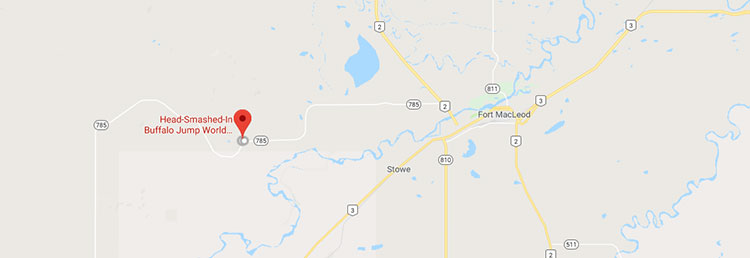
- Adult (18-64) $15
- Senior (65+) $13
- Youth (7-17 ) $10
- Family (2 Adults + Youths. Maximum of 8 people.) $40
- Child (0-6) Free
10:00 am – 5:00 pm daily.
Closed Christmas Eve, Christmas Day, New Year’s Day, and Easter Sunday. Severe weather may cause closure.
History of Head-smashed-in Buffalo Jump
Head-Smashed-In Buffalo Jump Interpretive Centre is a UNESCO-designated World Heritage Site that preserves and interprets over 6,000 years of Plains Buffalo culture. Through vast landscapes, exhibits, and diverse programming, learn about the cultural significance of this cliff to the Plains People.
From Wikipedia :
The buffalo jump was used for 5,500 years by the indigenous peoples of the plains to kill buffalo by driving them off the 11 metre (36 foot) high cliff. Before the late introduction of horses, the Blackfoot drove the buffalo from a grazing area in the Porcupine Hills about 3 kilometres (1.9 mi) west of the site to the “drive lanes”, lined by hundreds of cairns, by dressing up as coyotes and wolves. These specialized “buffalo runners” were young men trained in animal behavior to guide the buffalo into the drive lanes. Then, at full gallop, the buffalo would fall from the weight of the herd pressing behind them, breaking their legs and rendering them immobile. The cliff itself is about 300 metres (1000 feet) long, and at its highest point drops 10 metres (33 ft) into the valley below. The site was in use at least 6,000 years ago, and the bone deposits are 12 metres (39 feet) deep. After falling off the cliff, the injured buffalo were finished off by other Blackfoot warriors at the cliff base armed with spears and clubs. The carcasses were then processed at a nearby camp. The camp at the foot of the cliffs provided the people with everything they needed to process a buffalo carcass, including fresh water. The buffalo carcass was used for a variety of purposes, from tools made from the bone, to the hide used to make dwellings and clothing. The importance of the site goes beyond just providing food and supplies. After a successful hunt, the wealth of food allowed the people to enjoy leisure time and pursue artistic and spiritual interests. This increased the cultural complexity of the society.
- Designated a National Historic Site – 1968
- Designated a Provincial Heritage Site – 1979
- Designated a World Heritage Site – 1981
- Official opening of the Interpretive Centre with the Duke and Duchess of York – July 23, 1987
How Head-smashed-in Buffalo Jump Got Its Name
Contrary to what you might be thinking, the name didn’t come from the Buffalo getting their heads smashed in, although that certainly did happen too. Legend has it that during one of the runs of the bison, a young brave wanted to get a better view of the action, so he stood under the cliff waiting for the stampede to come pouring over like a waterfall. As you’d expect, he ended up getting smooshed and died. When they found him, his head was smashed in, so now it’s called Head-smashed-in Buffalo Jump. That’s the legend anyway. Source (PDF).

The unassuming entrance to the Head-smashed-in museum. It’s built right into the hill side and looks almost like a temple.
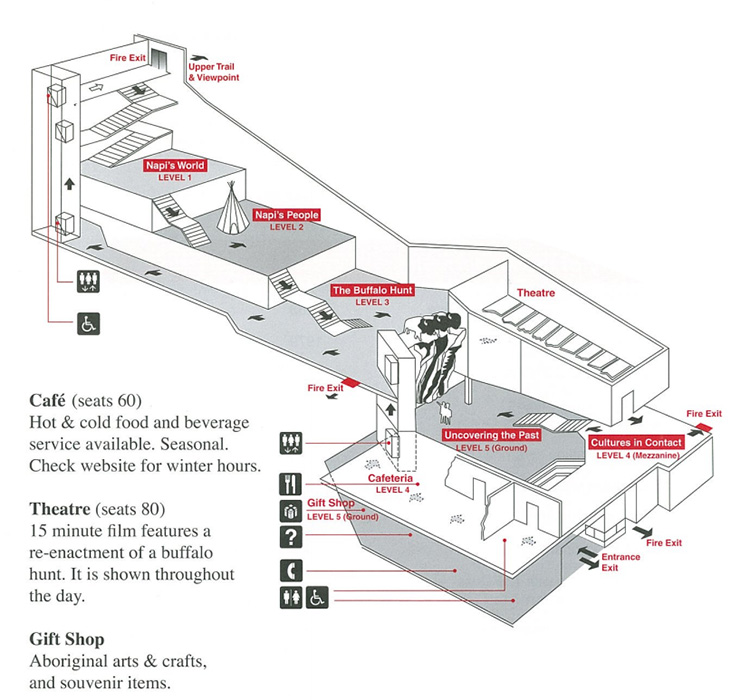
Inside, you will discover 5 levels of exhibits that explore:
- Napi’s world, story of creation
- Buffalo hunting culture
- The art of driving the great herds from the cliff
- The eventual demise of the buffalo hunting culture
- The work of archaeologists at Head-Smashed-In

Looking outward across the prairies. Once you’re out there you can really get a feel for how expansive Alberta is.
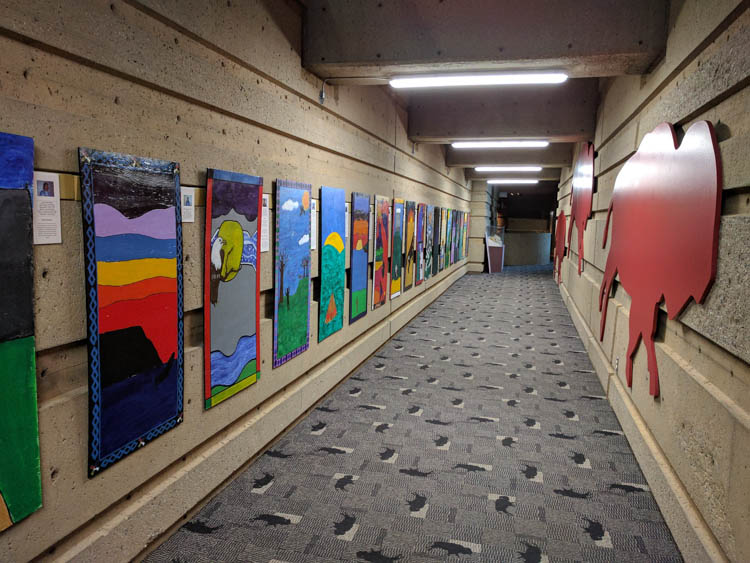
The interpretive centre has a lot of artwork.
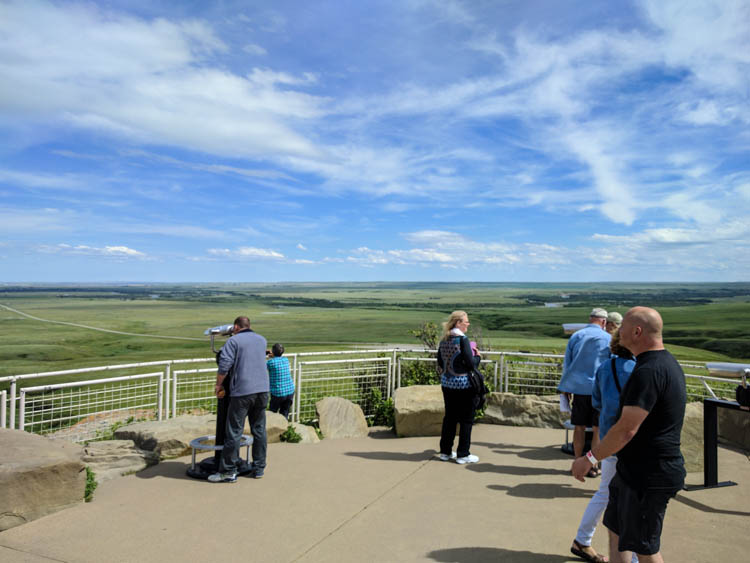
There’s an observation deck at the top, on the ridge. This is actually where you’re supposed to begin the tour, making your way down through the museums different levels, because you know, gravity.
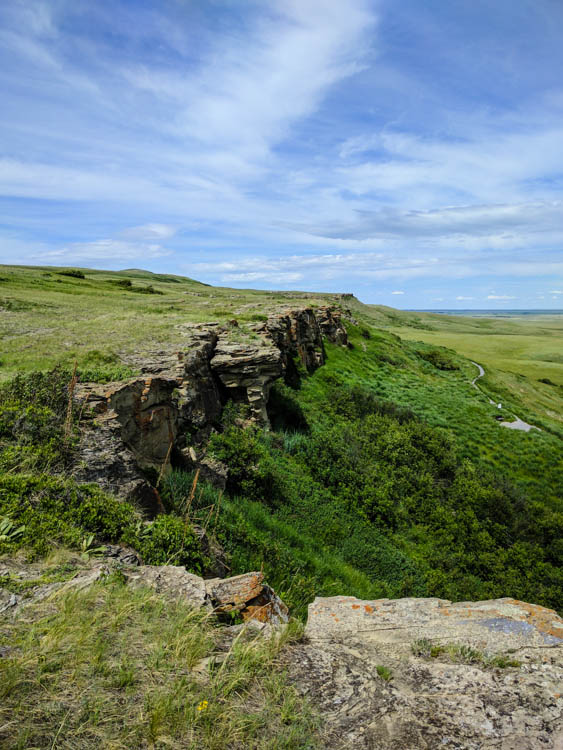
Bison going over the edge would be killed or severely hurt by their own sheer weight + hitting the ground. Groups of people would also be waiting at the bottom with weapons to finish them off if gravity didn’t.

Plan to spend at least an hour going through the floors, viewing all of the artifacts, plus lots to read.
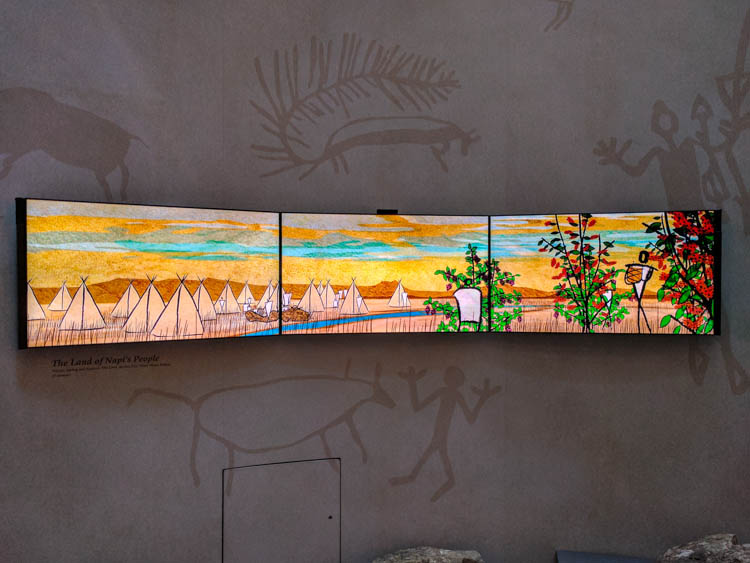
Skulls are cool, there I said it.
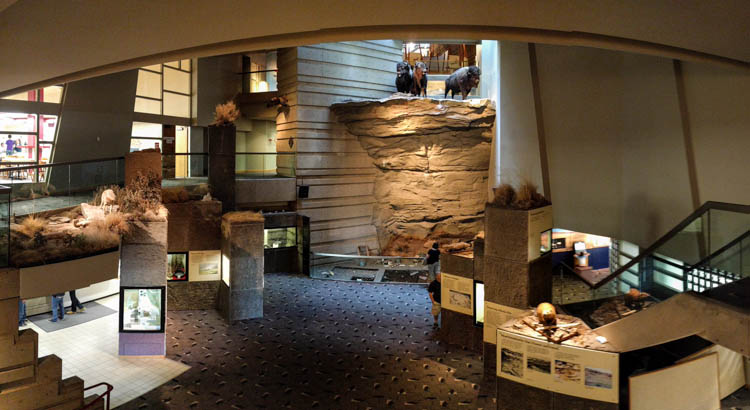
Go On A Virtual Tour With Google
Google maps street view includes a tour of the outdoor pathways around head-smashed-in Buffalo Jump. You can access the outer loop trail for free, but to get to the top, you’ll need to pay admission.
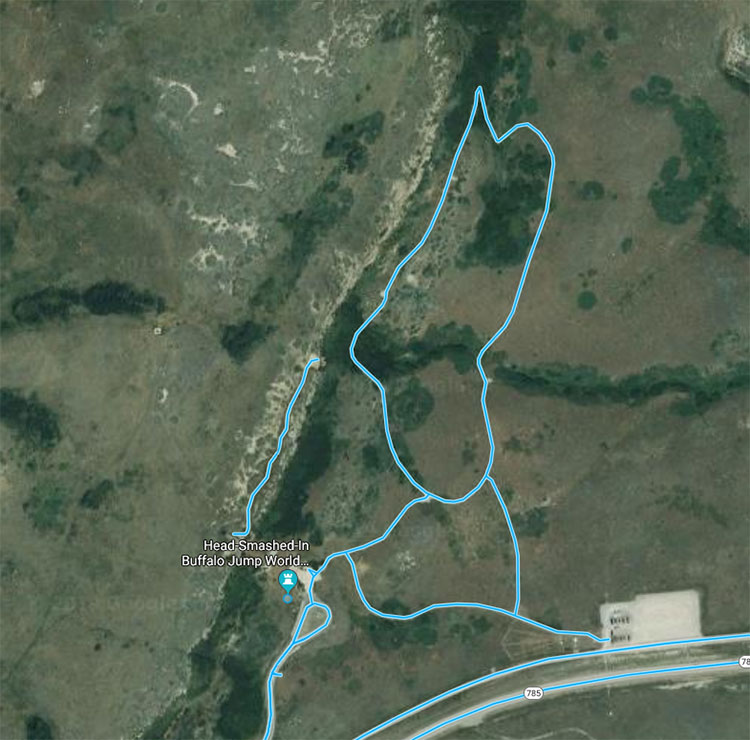
Head-smashed-in Buffalo Jump Video From Travel Alberta
This video from Travel Alberta explains some of the history about the buffalo jump and other info you may want to see before going. It’s got some really beautiful video too, check it out.
Everyone should visit at least once. Perhaps drive down on a weekend and take in some history?
Blogging in Calgary.
Follow along on Facebook , Instagram , Twitter . Join the Calgary Discord Server !
Where to buy marijuana / cannabis / weed in Edmonton
Meow charity thrift shop, leave a comment cancel reply.
Save my name, email, and website in this browser for the next time I comment.
- Skip to primary navigation
- Skip to main content
- Skip to primary sidebar
Time.Travel.Trek.
Actively Seeking the Past
Exploring Head-Smashed-In Buffalo Jump
Megan Kopp · August 19, 2021 · 10 Comments
Day Tripping to Head-Smashed-In Buffalo Jump, Alberta, Canada – Join us on a mini-adventure to visit one of Alberta’s six UNESCO World Heritage Sites. It’s a story that spans over 5,000 years. Somewhere in the neighbourhood of 100,000 bison went over the cliff, sustaining generation after generation of Plains people. It boggles the mind when you start to learn about the prehistory and history of the Plains Buffalo Culture at Head-Smashed-In Buffalo Jump.
Disclosure: This post contains affiliate links. If you buy something from one of our affiliates, we receive a small commission at no extra charge to you. Thanks for helping to keep our blog up and running !
Table of Contents
Walking into the Past
It was like taking a step back in time – way back in time – onto the prairies in Southern Alberta 500 years before the first Egyptian pyramid was built. The air was acrid with smoke from summer forest fires as we stepped out onto the cliff. Wind tossed hair around our faces. We walked forward with purpose. In the distance, we could hear the sound of hoofbeats . They were slow at first and then pounding faster and faster…
Okay, maybe it was just me! Truth be told, I have a pretty good imagination. Today’s path is made of concrete and fenced with metal posts and rail. Still, there is something about standing on top of the jump that creates a sense of wonder . The first bison were driven over the cliff over 5,500 years ago.
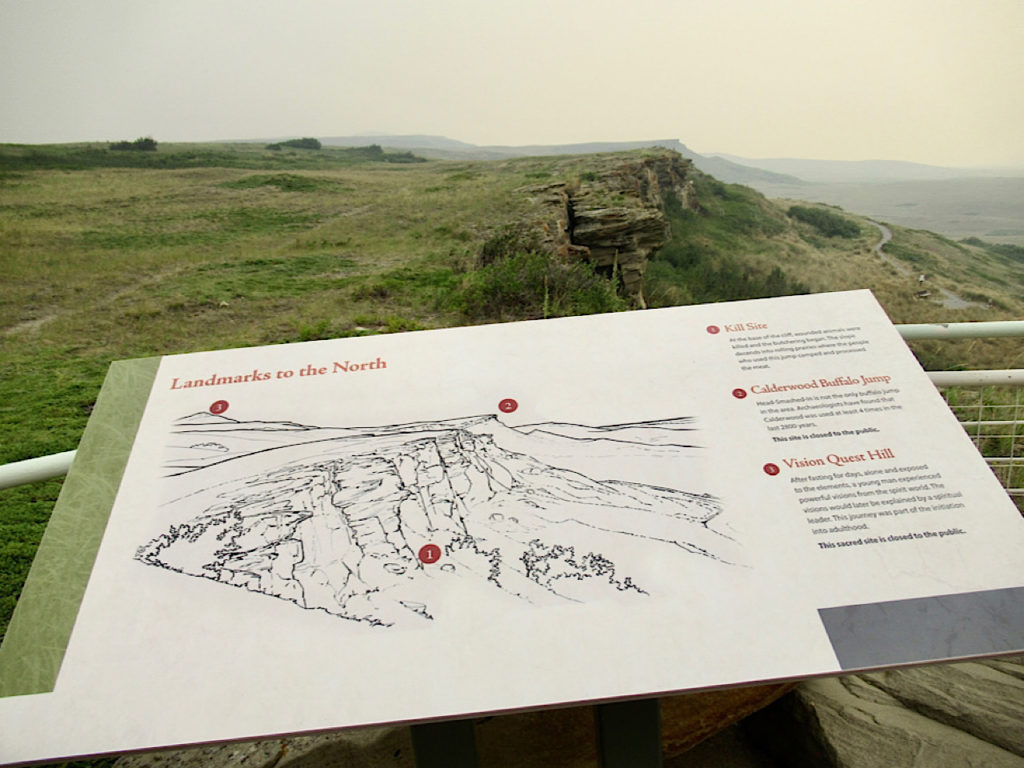
Let me take a step back for a minute.
First of all, what is Head-Smashed-In Buffalo Jump ?
Secondly, where is it located?
And finally, why should you add this Alberta adventure to your must-do list?
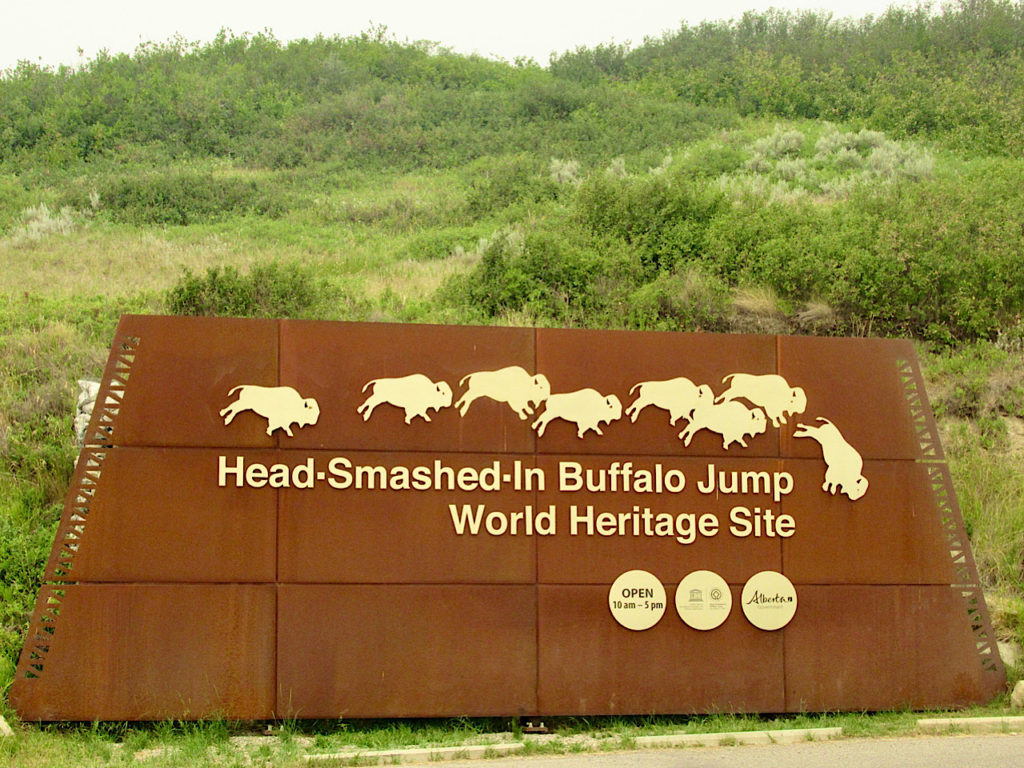
All About Head-Smashed-In Buffalo Jump
This buffalo jump is one of the deepest, oldest and best-preserved bison kill sites in North America. It is located on a cliffside at the southeastern edge of the Porcupine Hills, near Fort Macleod, Alberta . Head-Smashed-In Buffalo Jump is a world-class cultural site with an impressive, multi-story Interpretive Centre that leads visitors from the past to the present.
As a result of its significance, the area became a National Historic Site in 1968. Thirteen years later – in 1981 – it became a UNESCO World Heritage Site . Yes, this relatively small site in Southern Alberta is in the same league as Peru’s Machu Piccu, France’s Palace of Versailles and England’s Stonehenge ! The Interpretive Centre officially opened in July of 1987.
Interested in discovering other Alberta-based, UNESCO World Heritage Sites ? Check out our post on the Milk River for a paddle down to Writing-on-Stone!
Did You Know?
Buffalo are huge part of the folklore of the North American Plains, but there is no such thing as a North American buffalo! The name “buffalo” only applies to animals found in Africa and Asia. Our “buffalo” is actually a bison. But the popular name of buffalo has stuck and both terms are used regularly. Thus, Head-Smashed-In Buffalo – not bison – Jump.
At Head-Smashed-In, member of the Blackfoot tribes hunted the Plains bison . This species of bison occupied much of the central region of North America for thousands of years. No one knows exactly how many bison existed at their highest numbers, but it was in the tens of millions of animals.
And the site has another unique naming feature! It’s easy to assume that “Head-Smashed-In” refers to the bison killed at the site. Nope. According to legend , a young man was found near the cliff, his skull crushed by the weight of the bison carcasses.
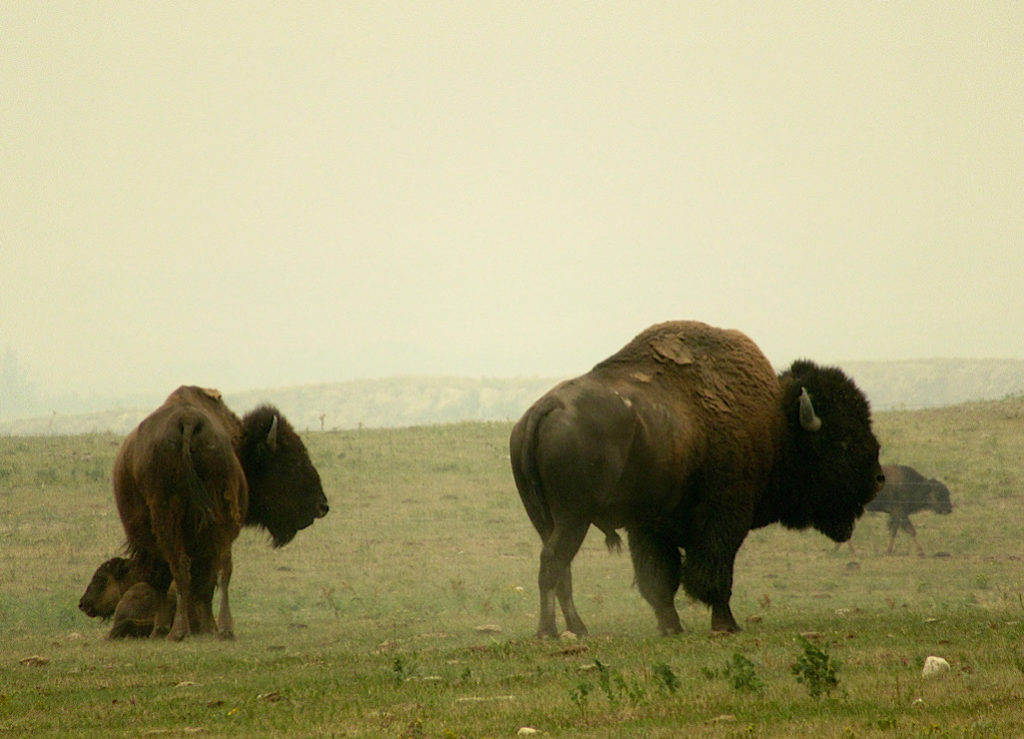
How Does a Buffalo Jump Work?
Plains people relied on their collective wisdom and knowledge of topography and bison behaviour to hunt these massive animals. They mastered buffalo jumps long before they ever saw a horse or bow or gun.
Spiritual ceremonies were held to ensure a safe and successful hunt. Runners were sent to locate and start slowly herding the animals closer to the jump site. This area is called the gathering basin . V-shaped drive lanes lined with stone cairns helped funnel the herds of bison in the right direction. Remnants of these cairns are still found today.
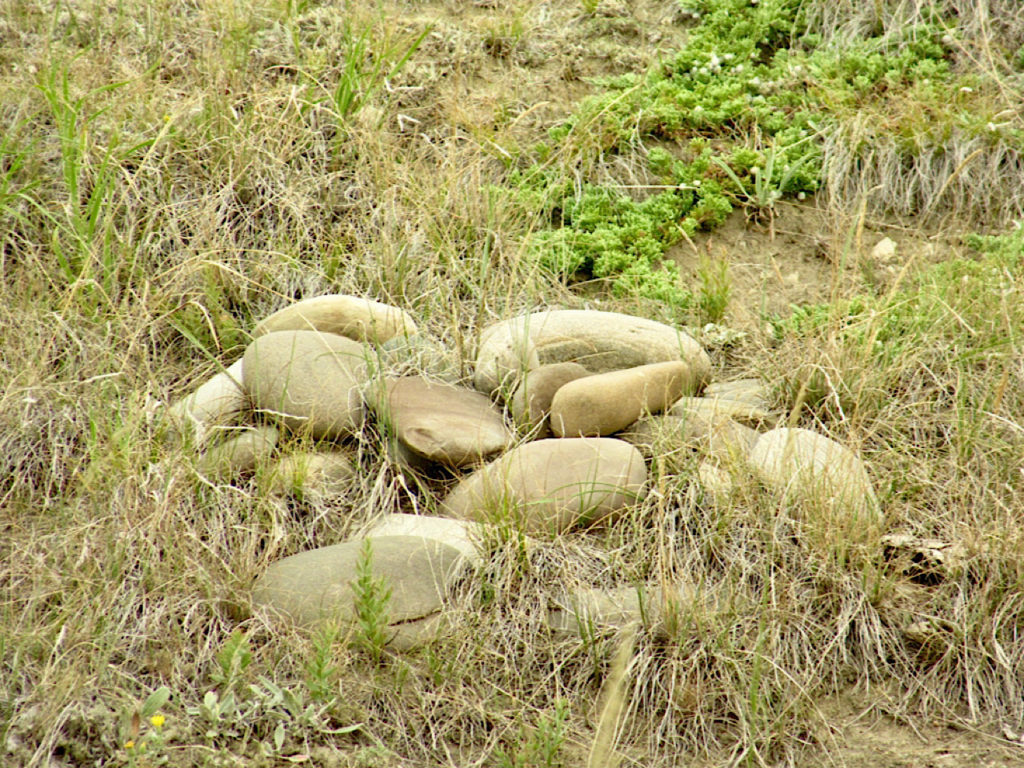
As the herd drew closer, people hiding behind the cairns and brush would stand up and start shouting and waving their arms. The herd would panic and thunder over the cliff to their death. The animals were processed in the butchering camp set up below the precipice.
Bison was essential for Plains tribes. Almost every part of the animal i s used . Meat, fat and bone marrow is eaten. Hides were used for clothing and shelter. Bones are shaped into tools. Horns are made into spoons. Bison tongues were often given to medicine men or women, who were responsible for ceremonies ensuring the success of a hunt.
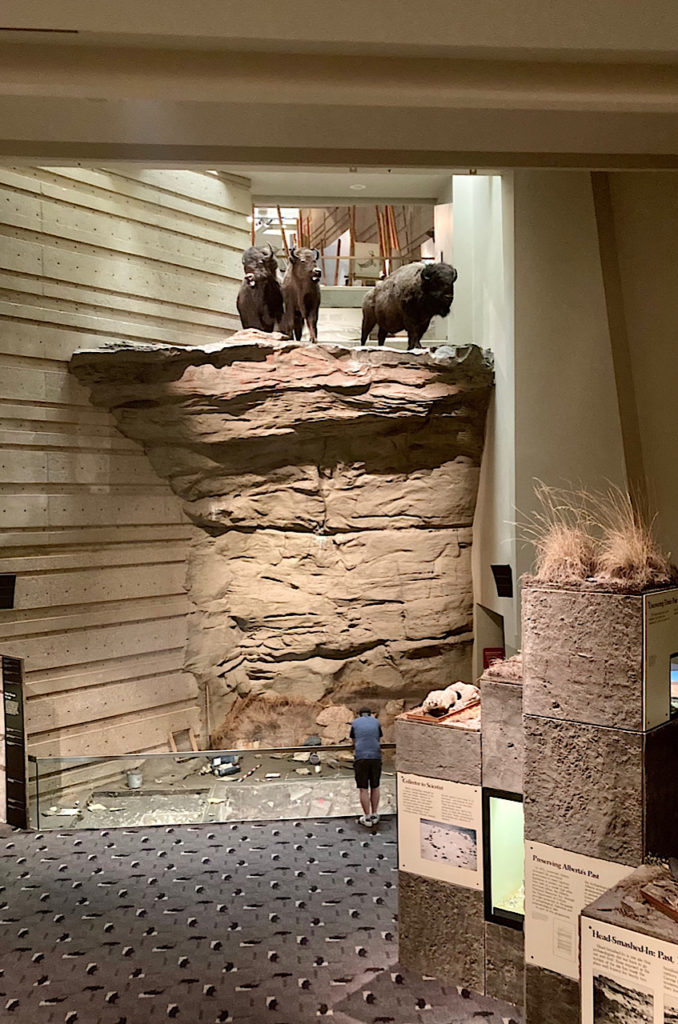
Stepping Inside This Cultural Adventure
After viewing the jump site, my niece and I went back into the interpretive centre and started working our way down the levels – starting with a captivating video and explanation of Napi’s World . Another level introduced Napi’s people and life on the plains. The museum’s open design allows glimpses of the herd at the cliff edge before we walked down to the Buffalo Hunt and into the theatre for a flashback to all of the action.
Cultures in Contact took our breath away. The piles of skulls in historic photos were mind-numbing. Bison hunting had become a sport by non-native people. By the end of the 19 th century, the mighty herds of bison were decimated. Less than 1,000 plains bison a re left . European contact brought in human diseases as well. Before long, more than just the bison population was in peril.
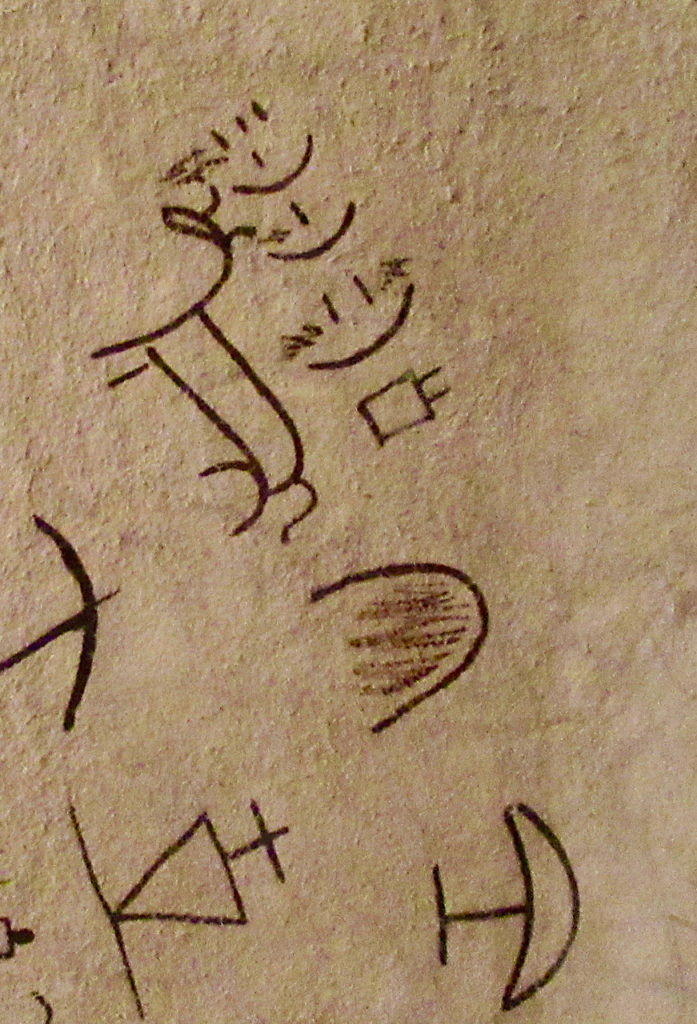
Archaeology at Head-Smashed-In
We wandered through the final level, Uncovering the Past , appreciating the film with archaeologists talking about their interpretation of the finds and their meanings. Head-Smashed-In Buffalo Jump was the first site in Alberta to be excavated by a professional archaeologist.
In 1938, Junius Bird from the American Museum of Natural History spent a few days at the site and did some cursory testing. Eleven years later, archeology student Boyd Wettlaufer from the University of New Mexico spent a summer working at Head-Smashed-In. His work that summer was the first archaeological excavation in Alberta.
Subsequent archaeological digs have increased understanding of this unique and complex archaeological site. The Head-Smashed-In site includes three different components spread out over 1,470 acres . There is the gathering basin , the kill site , and the campsite and processing area . Each area has different kinds of archaeological remains.

Together, these remains help tell the story of Head-Smashed-In. The oldest evidence of humans in the area are two spear points – believed to be 9,000 years old ! Radiocarbon dating of the bones show the site was an active buffalo jump 5,700 years ago.
The layers show changes in technology . The uppermost layers at Head-Smashed-In Buffalo Jump have metal arrowheads . These show that the jump was used in historic times – after European contact . With the signing of Treaty No. 7 in 1877 at Blackfoot Crossing , the Plains people settled on reserves in Southern Alberta. The great herds are gone. The buffalo jump is no longer needed.
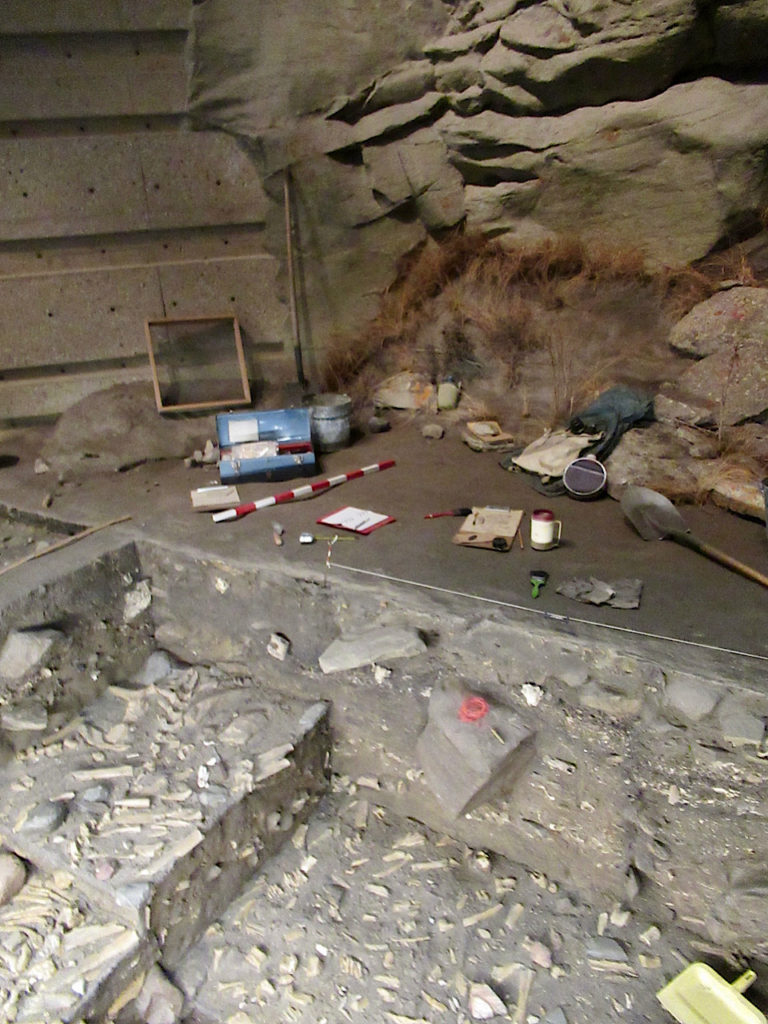
Bringing the Past to Life
The interpretive centre is full of great information, captivating films and thought-provoking photos, but it was a chance encounter with an interpreter who brought it all to life. We were standing at a wall of black-and-white photos for an exhibit called: Rediscovering the Voices .
“ Photographs can speak. They can whisper or shout. They can lie. Many photographs though, are silent. Every time the people, event or places shown in a picture are not know, the photograph has lost a voice. When a drawing on a tipi or robe aren’t explained, another voice is silenced… ”
We were talking about the photos and how the exhibit brought such an important topic to light when a man came out of a nearby office.
“How are you enjoying your visit?” he asked.
“It’s been very good,” I replied. “However, we’re especially appreciating this exhibit.”
“You’ve both had your shots?” he queried.
“Yes,” we answered in unison.
“I guess I can talk with you then.”
And with that, he launched into a discussion about the photos, the faces, the photographers. He questioned our impressions and told us what he knew. He brought everything to life with a few simple guided words .
It made our day.
I cannot wait to revisit the museum when all of the interpreters are back, sharing their voices and their knowledge and illuminating the amazing prehistory and history of Head-Smashed-In Buffalo Jump. The displays and films are good, but it is truly the people who make it real , who bring the past to life.
PIN THIS POST FOR FUTURE REFERENCE!
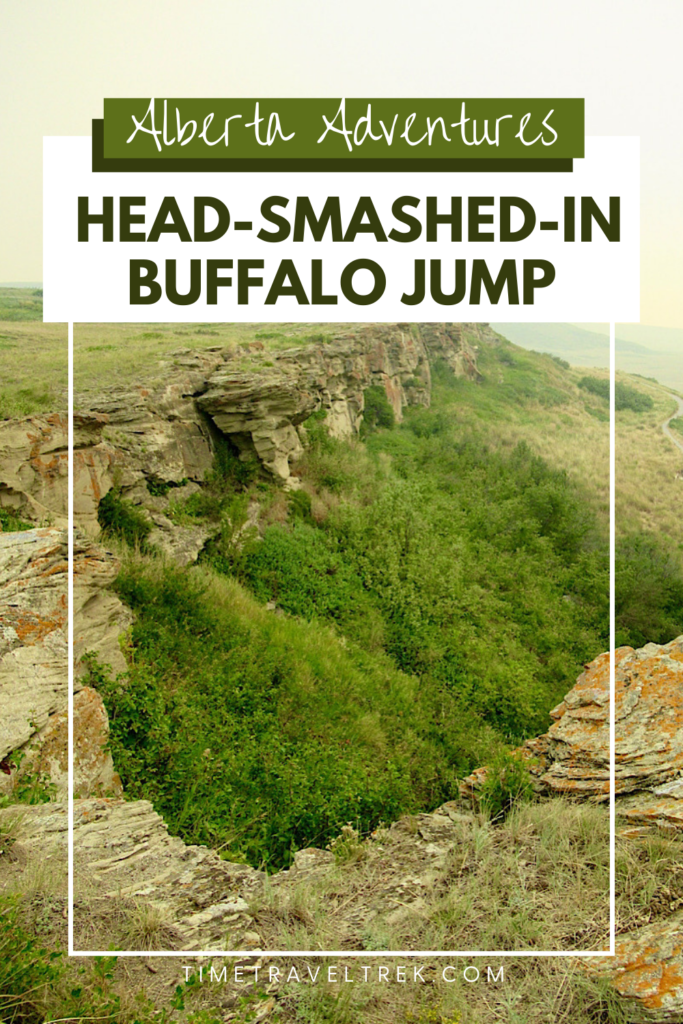
When You Go
Hours of Operation : Due to the pandemic, the Interpretive Centre is self-guiding for Summer 2021, but visitors can still enjoy the Viewpoint, exhibits and theatre presentations. It is open 10-5 daily until September 7, 2021. The site will be fully open again in 2022.
Location : Head-Smashed-In Buffalo Jump is located 18 kilometres northwest of Fort Macleod on the paved secondary Highway #785 (west off Highway #2).
Nearby RV Camping Option : River’s Edge RV Park offers 15 and 30 Amp Service with River Front and Pull Thru sites available.
Looking for additional Southern Alberta adventures ? Check out our posts about Cycling the Crowsnest Community Trail and Exploring the Crowsnest Pass: Hillcrest Mine Disaster – both just an hour away!
Reader Interactions
August 19, 2021 at 9:42 am
Whilst in the area, Lundbreck Falls (50km from Head Smashed In) is a great stop for a picnic and also has an excellent campsite complete with the serenade of the nearby falls to lull a person into dreamland!
August 19, 2021 at 10:10 am
Perfect tip, thanks for sharing Richard!
August 19, 2021 at 10:18 am
We ended up choosing to do 2 weeks on the South Saskatchewan in July. I had asked your opinion about that or the Red Deer. No regrets at all! What a beautiful 2 weeks we had – wildlife galore, great weather (including some intense wind storms to challenge our camp-setting skills and an outstanding electrical storm one night. 2 weeks got us from the confluence of the Olman and the Bow Rivers to Estuary, just into Saskatchewan. We had a couple of land days due to wind, and then took another day to walk / hitch into Empress which was a great experience – the friendliest of people. On more than half of our days, we saw no other humans, and had cell phone reception only as we paddled through Medicine Hat and when we walked to the top of the valley at Hwy 41 to confirm our take-out point. Fantastic experience. Would do it again in a heartbeat!
August 19, 2021 at 11:44 am
Excellent! So glad you enjoyed the South Saskatchewan; it is a beautiful paddle.
August 20, 2021 at 3:07 pm
What a fascinating place!! So glad this important history is being preserved.
August 20, 2021 at 7:43 pm
August 23, 2021 at 9:43 am
What an interesting place that I had never heard of before. Thanks for sharing this gem,
August 23, 2021 at 4:46 pm
Glad you found something new in the world of travel adventure by reading this post Susan!
February 9, 2022 at 9:31 am
I am Kirby Smith with the Archaeological Society of Virginia. How high is the cliff top from the grass or dirt below? I was just curious. Thank you
February 10, 2022 at 8:41 am
Hello Kirby, The cliff face is 10 metres (~33 ft) high; how deep the bone deposits are below the grass and shrubs that now cover the jump I’m not sure. A great resource for more information is https://whc.unesco.org/en/list/158/ . Cheers, M.
Leave a Reply Cancel reply
Your email address will not be published. Required fields are marked *
Notify me of follow-up comments by email.
Notify me of new posts by email.
This site uses Akismet to reduce spam. Learn how your comment data is processed .
Privacy Policy
You can read our Privacy Policy here .

2025 - Head Smashed-In Buffalo Jump
3-day fort macleod itinerary, weekend fort macleod itinerary, general tips, 408 brookpark dr sw.
- 10-6pm 7days a week
- Candy & ice cream
- Water Tap Poster/Sign
Granview Recreation Park
- Off-leash area
- In Alberta's smallest town. Parking, washrooms and the 1st tee are just south of the quiet, inexpensive and shady campground. Fun walking tour of the town the historical plaques on every block. The campground wraps around a well stocked trout pond. 3 sets of tees, tight OB lines, a water hazard, and a tunnel hole makes this a good warm up for Canada's longest disc golf course at Nicholas Sheran Park - just 30 minutes to the SE. Fund raising, construction and installation of the course all due to the efforts of the teachers, students and parents of the Granum Community School.
Prairie Dog Kennels
Head-smashed-in buffalo jump world heritage site.
- Maggie’s Diner (Heartland TV show) 123 3 Ave SW, High River, AB T1V 1R3
- Historic Murals walking tour
- ? have dinner before heading home
Hitchin Post Drive-In
Little bow dog park.
- East of 5 Street S.E. behind the Canadian Tire/Mark’s Work Warehouse shopping centre.
See your itinerary and your map in one view: no more switching between different apps to keep track of your travel plans.
Change location
- UK / International
- Call toll-free tomorrow from 10am EDT 617-223-4521 617-223-4583 or
- REQUEST A QUOTE
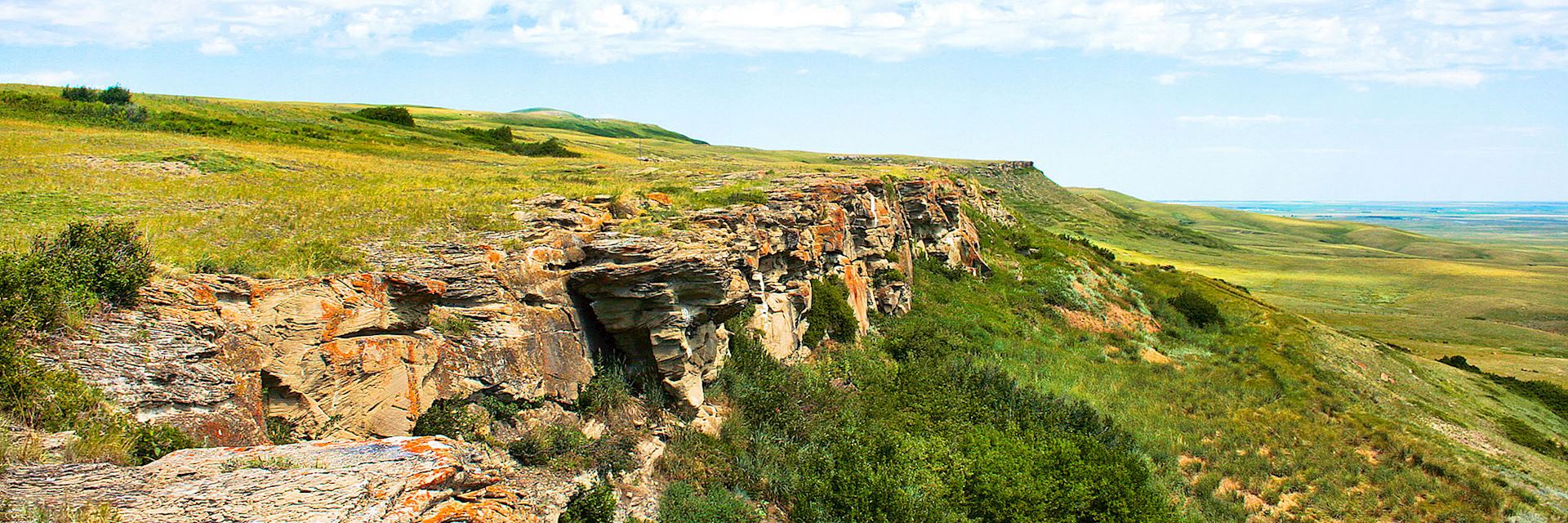
Visit Head-Smashed-In Buffalo Jump, Canada
This remarkable testament to the native peoples of the North American plains was awarded UNESCO World Heritage status in 1981.
This was after archaeological evidence showed that the site was used repeatedly for traditional buffalo hunts for nearly 6,000 years.
Archaeological site
The plains people would dress as wolves or foxes and spend days carefully herding the buffalo, finally stampeding them over a ten meter high cliff. This age-old practice was stopped almost overnight in the 19th century when horses were introduced, making it easy for individuals to hunt without involving the entire tribe.
The site’s name doesn’t quite mean what you might expect. It comes from the tale of a brave who waited below the cliff to get a different view of the buffalos as they flew into the air: not, in retrospect, such a good idea.
Fort Macleod
While in the area it is also worth visiting Fort Macleod, a historic outpost of the North West Mounted Police who were dispatched in 1874 to bring order to the west.
Start planning your tailor-made trip to Head-Smashed-In Buffalo Jump by contacting one of our Canada specialists
- 617-223-4521 617-223-4583
- Make an inquiry
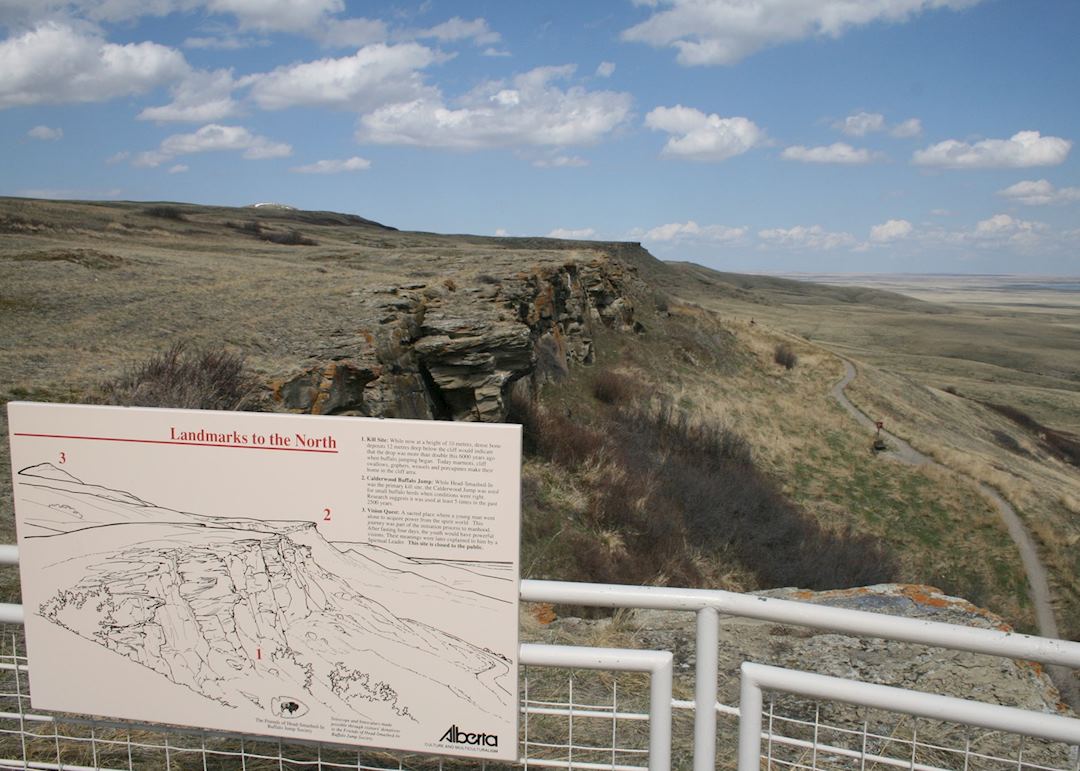
Start planning your trip to Head-Smashed-In Buffalo Jump
Map of head-smashed-in buffalo jump, places & hotels on the map, places near head-smashed-in buffalo jump.
- Claresholm 22 miles away
- Waterton Lakes National Park 48 miles away
- Fernie 65 miles away
- Calgary 96 miles away
- Writing-on-Stone Provincial Park 102 miles away
- The Purcell Mountains 117 miles away
- Dinosaur Provincial Park 121 miles away
- Canmore 122 miles away
- Banff 133 miles away
- The Kootenays 137 miles away
- Lake Louise 163 miles away
- Yoho National Park 168 miles away
- Field 172 miles away
- Kyle 261 miles away
- Edmonton 266 miles away
- Naramata & Okanagan Valley 267 miles away
- Sun Peaks 288 miles away
- Jasper 292 miles away
Photos of Head-Smashed-In Buffalo Jump
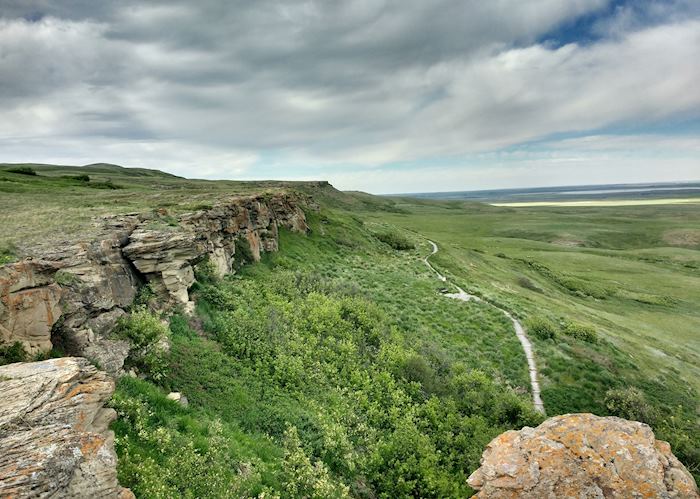
Our expert guides to exploring Head-Smashed-In Buffalo Jump
Written by our specialists from their own experiences of visiting Head-Smashed-In Buffalo Jump, these guides will help you make the most of your time there. We share both our practical recommendations and the best ways to appreciate Head-Smashed-In Buffalo Jump at its best.

Self-driving in western Canada
Canada specialists Kerry and Annie share their tried-and-tested self-drive routes in western Canada. You might want to follow a lesser-known loop through the Canadian Rockies, detouring to the Okanagan wine region. Or, take in British Columbia’s coastline and Vancouver Island.

Love Exploring
Revealed: Canada’s Most Important Archaeological Discoveries
Posted: October 30, 2023 | Last updated: October 30, 2023
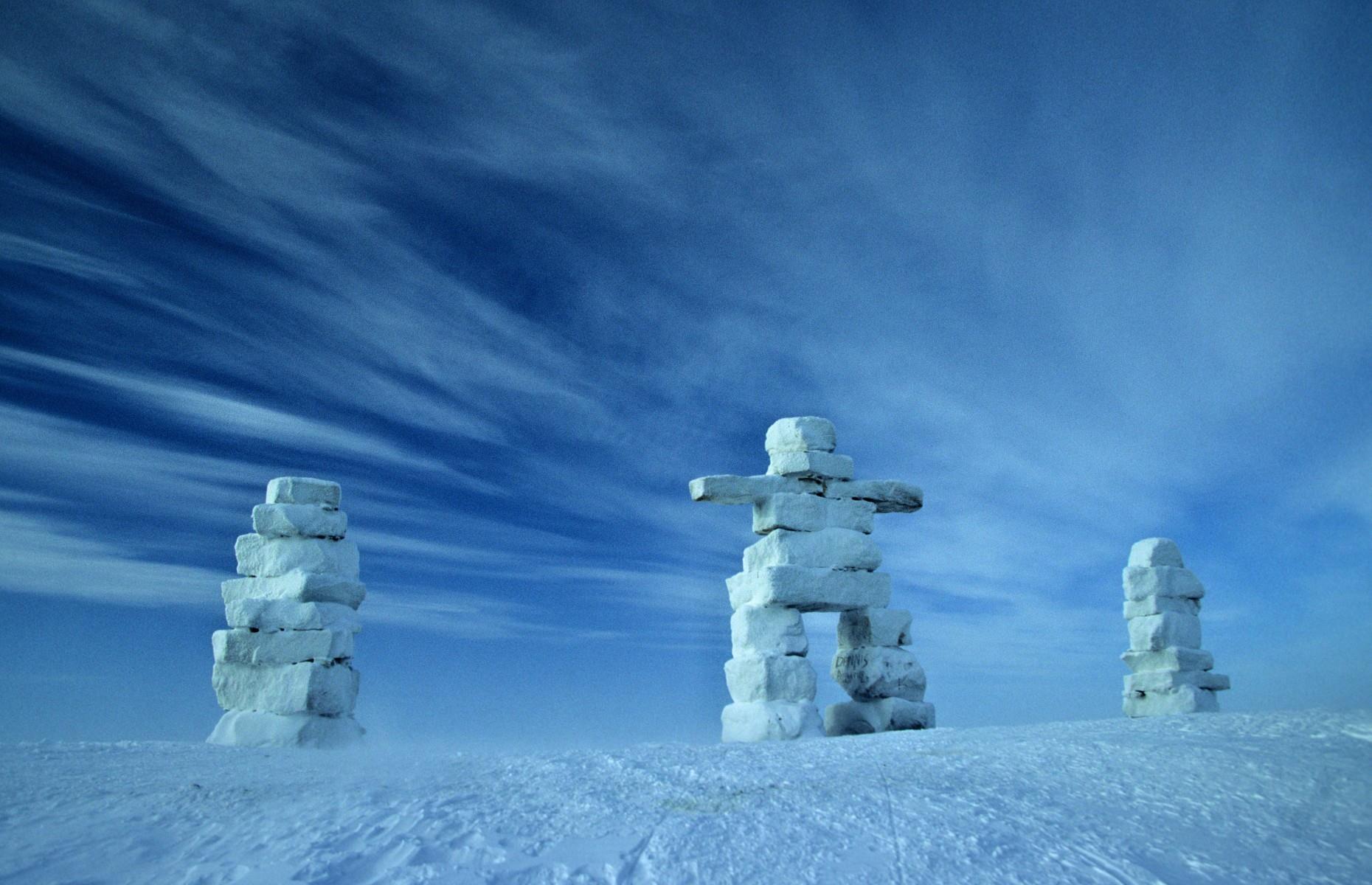
Digging up the past
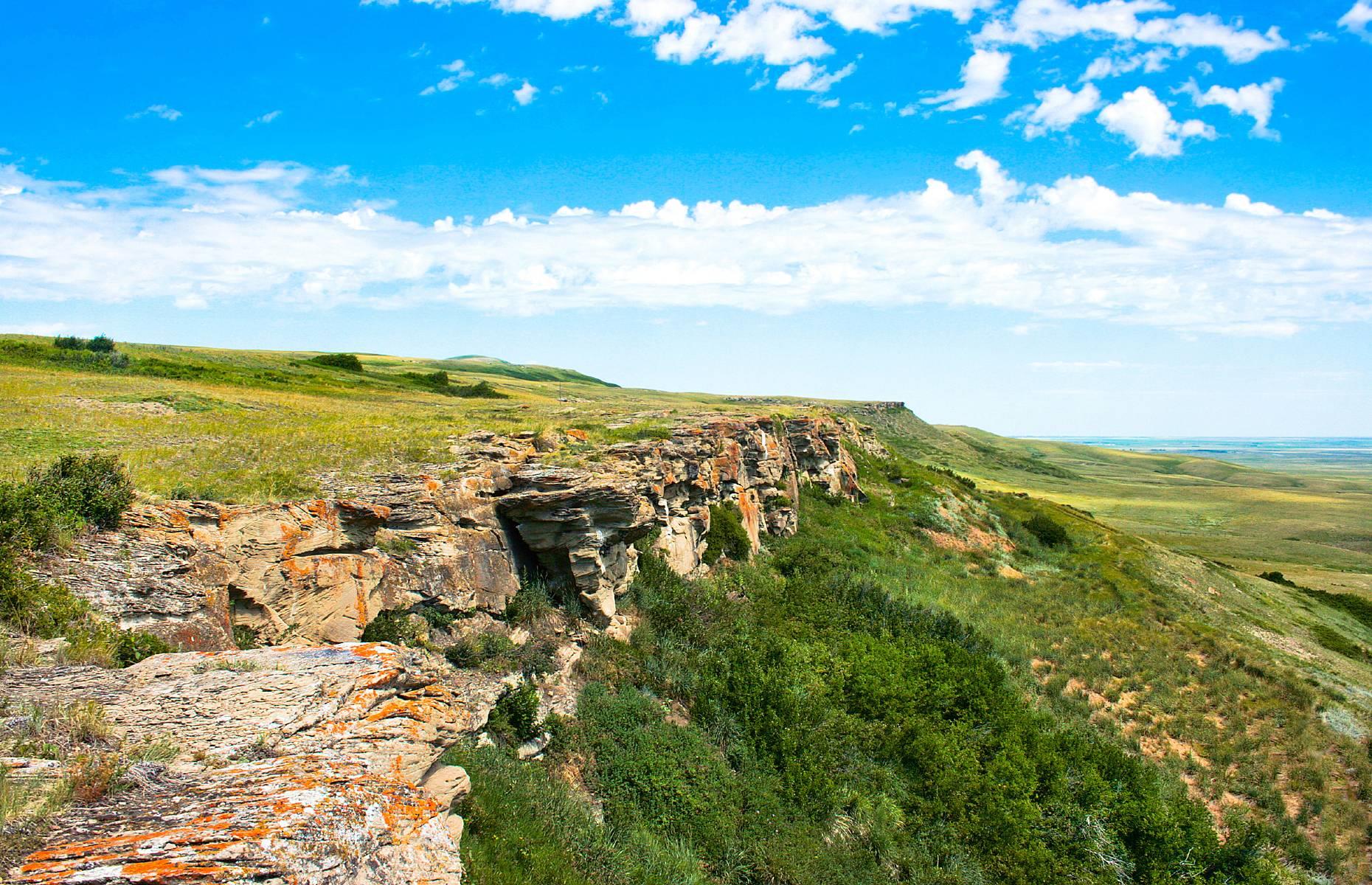
Head-Smashed-In Buffalo Jump, Alberta
Bad-tempered bison were dangerous prey for the hungry Blackfoot tribe, but its brave hunters had a clever technique for bringing them down. They used their knowledge of bison behavior to drive the animals over a cliff edge at the colorfully named Head-Smashed-In Buffalo Jump – a practice in use for half a millennium or more. The carcasses were processed where they lay, leaving tools and countless skeletons as archaeological evidence. The cliff is not named after the buffalos, but an unfortunate Blackfoot who got too close to the falling animals.
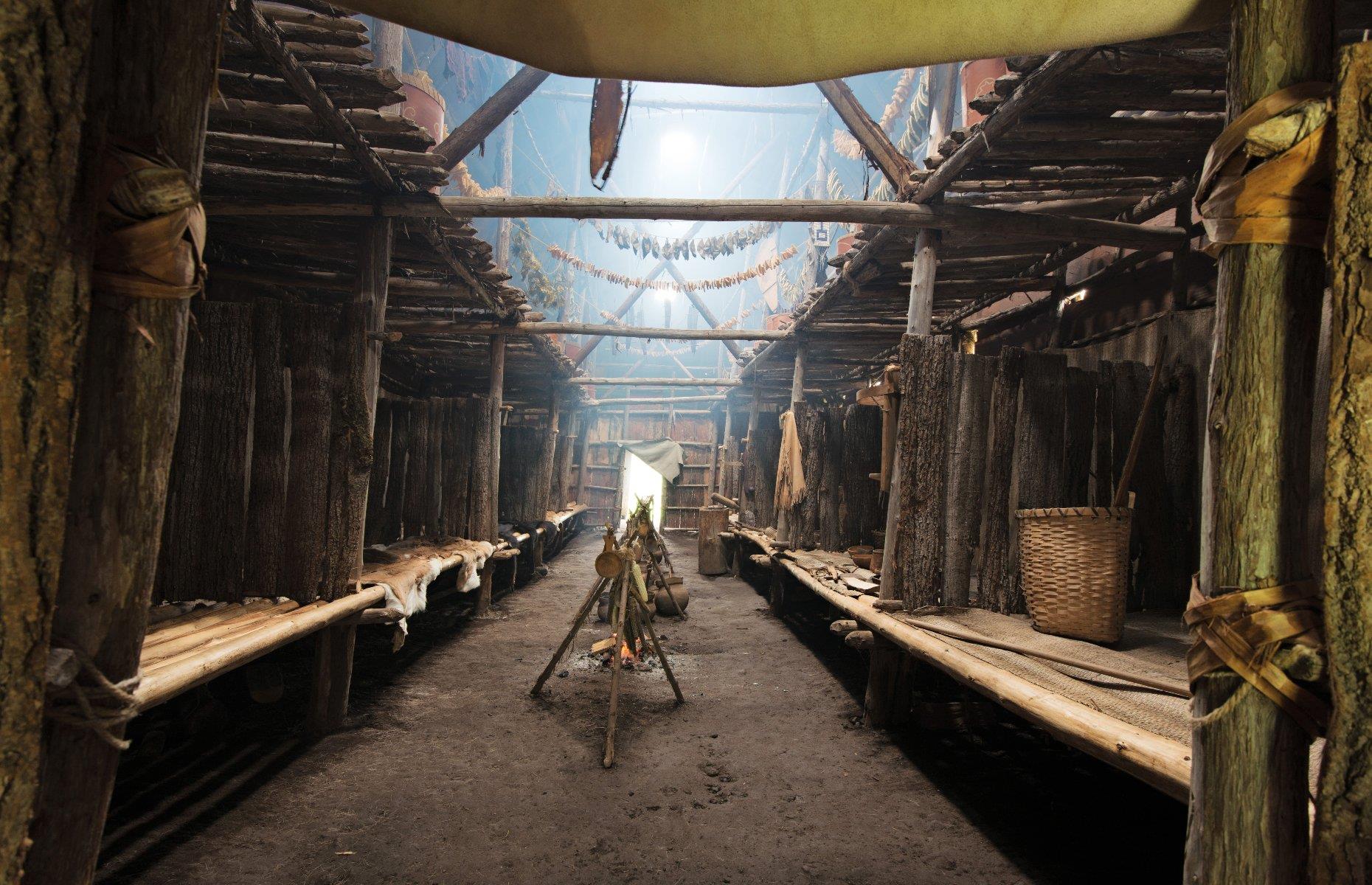
Droulers-Tsiionhiakwatha, Quebec
Some five miles (8km) southwest of Montreal is a short-lived settlement populated by the Iroquoian tribe around 1450. The village of Droulers-Tsiionhiakwatha was discovered in 1994, and archaeologists have unearthed longhouses, storage pits and rubbish dumps that catered for approximately 600 inhabitants. Many of the buildings have since been reconstructed, creating an entertaining and informative archaeological park where visitors can learn about everyday life in pre-colonial Quebec.
Love this? Follow us on Facebook for travel inspiration and more
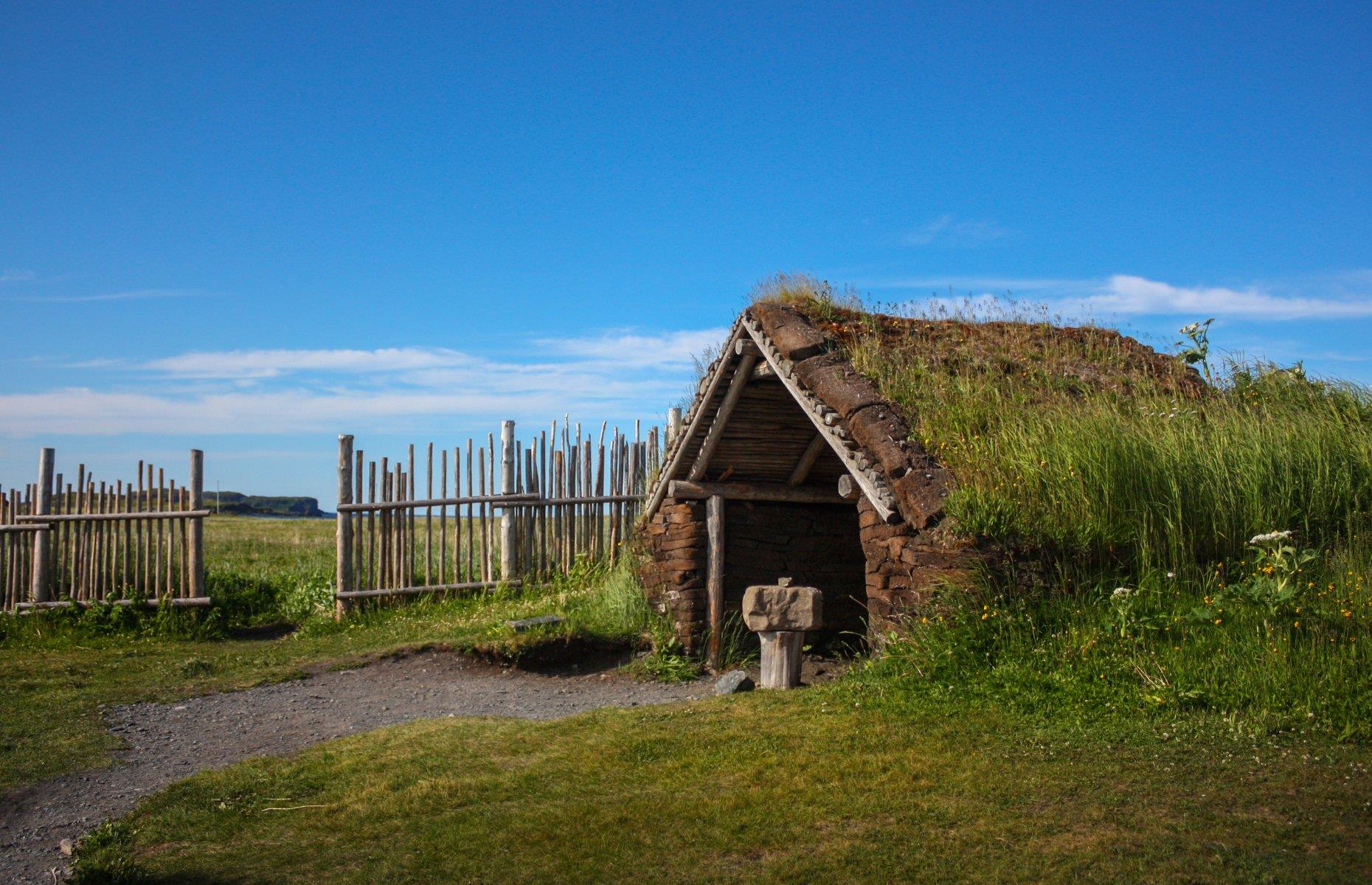
L’Anse Aux Meadows, Newfoundland and Labrador
For nearly 500 years Christopher Columbus was thought to be the first European to set foot in the Americas, but he lost his place in the record books in 1960 when archaeologists dug up L’Anse aux Meadows, and discovered that 100 or so Vikings had beaten him across the Atlantic. Nobody knows how long the Vikings stayed in Canada, or whether their sturdy wooden huts on the Newfoundland coast were part of an abandoned colony or trading station. But excavators found evidence of shipbuilding, woodworking and iron production, and the reconstructed buildings and modern visitor center give a strong sense of what the village must once have been like.

Herschel Petroglyphs, Saskatchewan
Like the tip of an iceberg, the large boulder overlooking Eagle Creek in southwest Saskatchewan is only partly exposed above the earth. But the small pits carved into its surface well below modern ground level suggest that the rock was once a much more prominent part of the landscape. Presumably that’s why local tribes left their mark on the boulder – although it’s still unclear whether the carvings were made during the 1st century AD or even earlier, perhaps as far back as 8,000 BC.
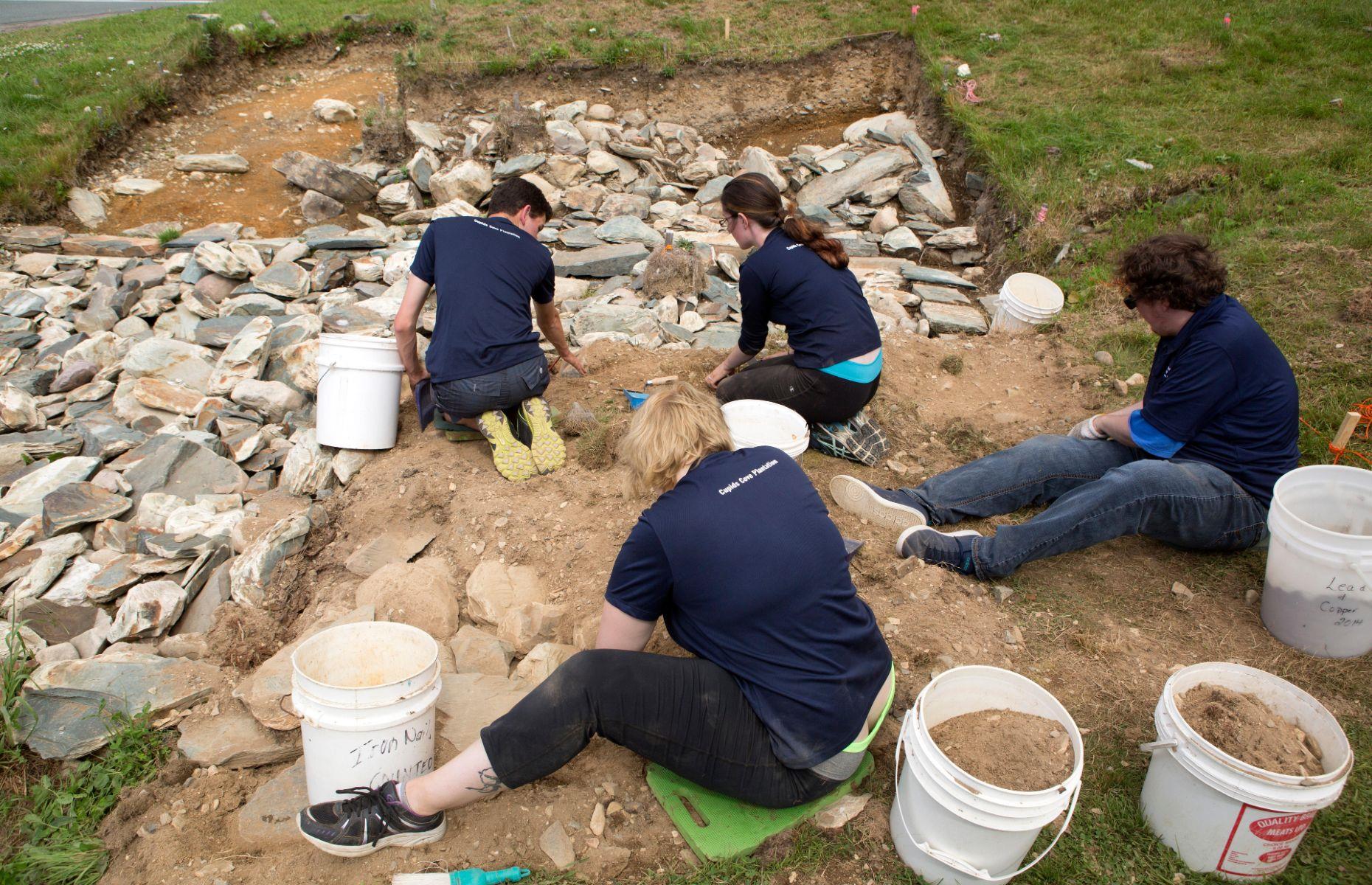
Cupids Cove, Newfoundland and Labrador
The first English settlers in Canada built a plantation beside Conception Bay in 1610. It was mostly abandoned by 1700 and forgotten for 250 years, until archaeologists rediscovered it near the picturesque modern-day village of Cupids. All visitors to Cupids Cove will find a small museum displaying artifacts found at the site, but some lucky guests might also see relics unearthed before their eyes at the ongoing excavations. The archaeologists are happy to chat with onlookers and explain what they’re working on.
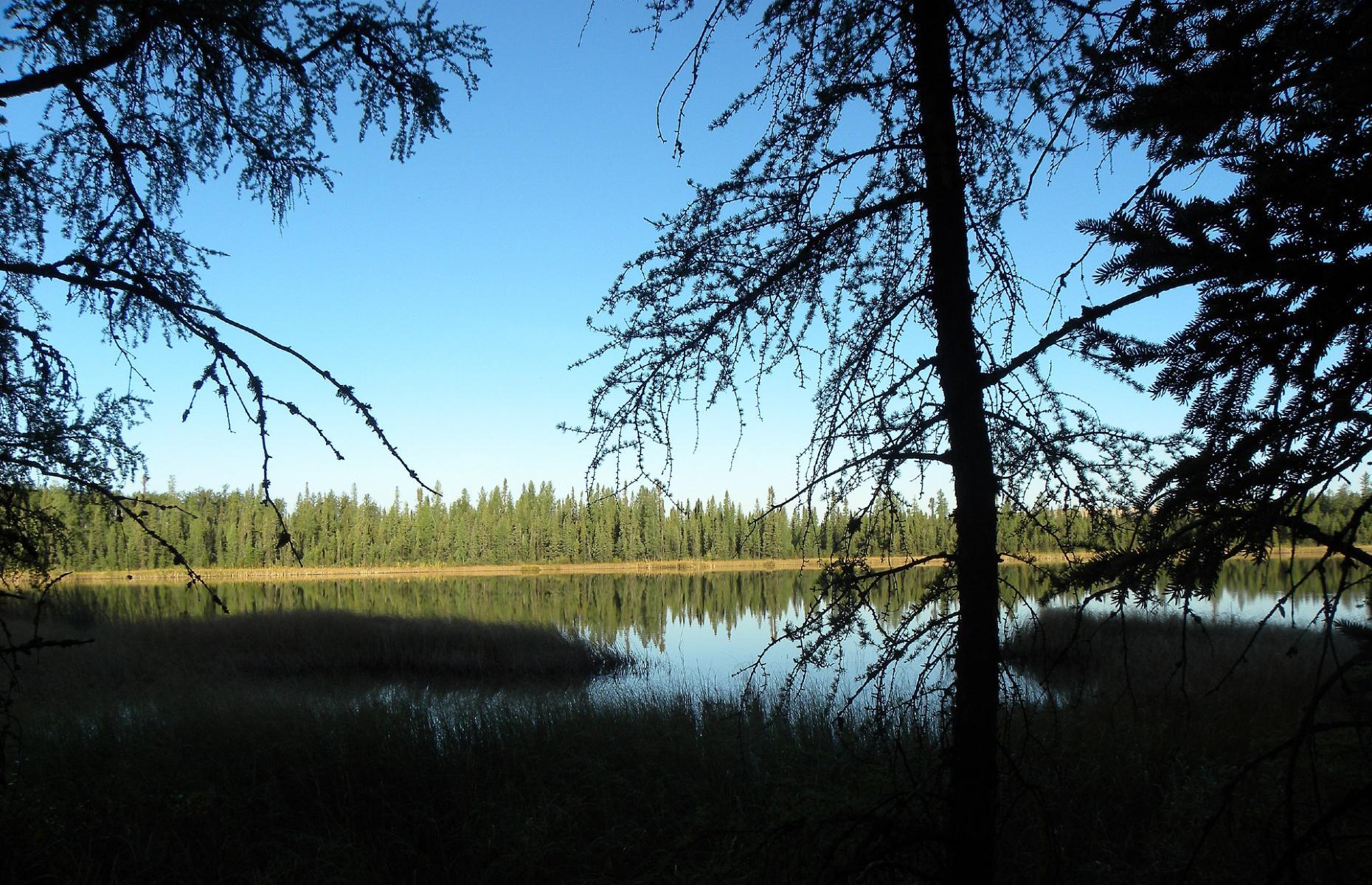
Quarry of the Ancestors, Alberta
A quirk of geology means that a particularly pure variety of rock rises to the surface in what is now a swampy forest in Alberta, and it didn’t take long for Indigenous tribes to realize that it was perfect for knapping into stone tools. They visited the site for thousands of years after its first use around 9,800 years ago, and modern-day archaeologists have also returned time and again to uncover ancient spear points, arrowheads and stone flakes left behind by skilled ancient toolmakers.
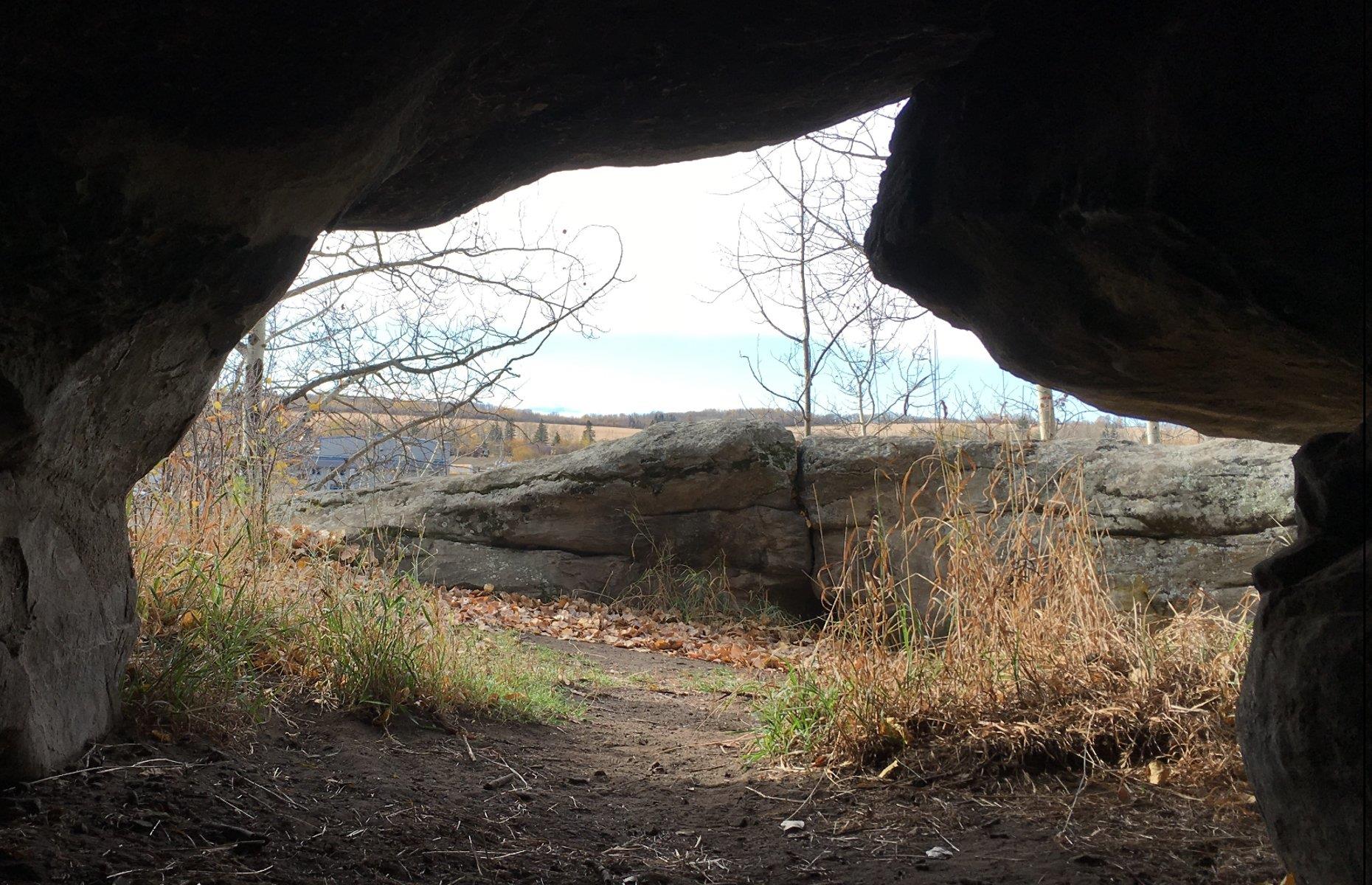
Tse'K'wa, British Columbia
Also known as Charlie Lake Cave, this archaeological site is best known for its rubbish. Up to 12,000 years ago the inhabitants of the cave dug a waste pit just outside its entrance, wwhere they dumped debris from their bison hunts. They also buried two ravens, though the birds were deposited more than a thousand years apart. The archaeologists that excavated the cave in the 1970s and 1980s concluded that the birds could be the earliest known evidence of ritual behavior on the entire continent.
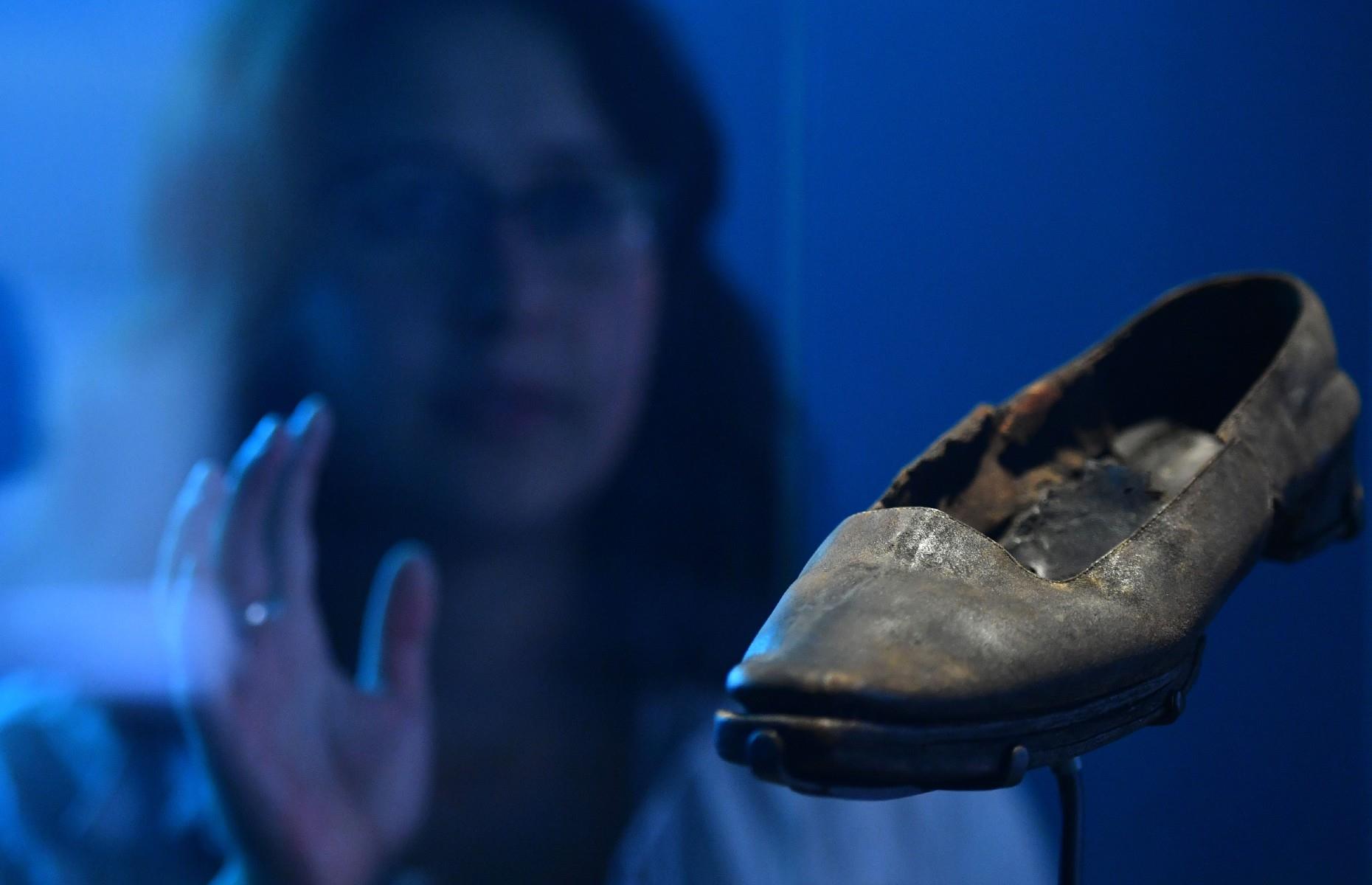
HMS Erebus, Nunavut
British explorer Sir John Franklin embarked on his notorious expedition to map a route through the icy Northwest Passage in 1845 – but he, his crew and his ships were never seen again. Investigators determined that his crew had become icebound and starved to death, but his flagship HMS Erebus remained missing until 2014, when it was at last located west of the Adelaide Peninsula. Marine archaeologists have since examined the wreck and raised several artifacts for public display, but its exact location has been kept a secret.
These amazing artifacts were all found on shipwrecks
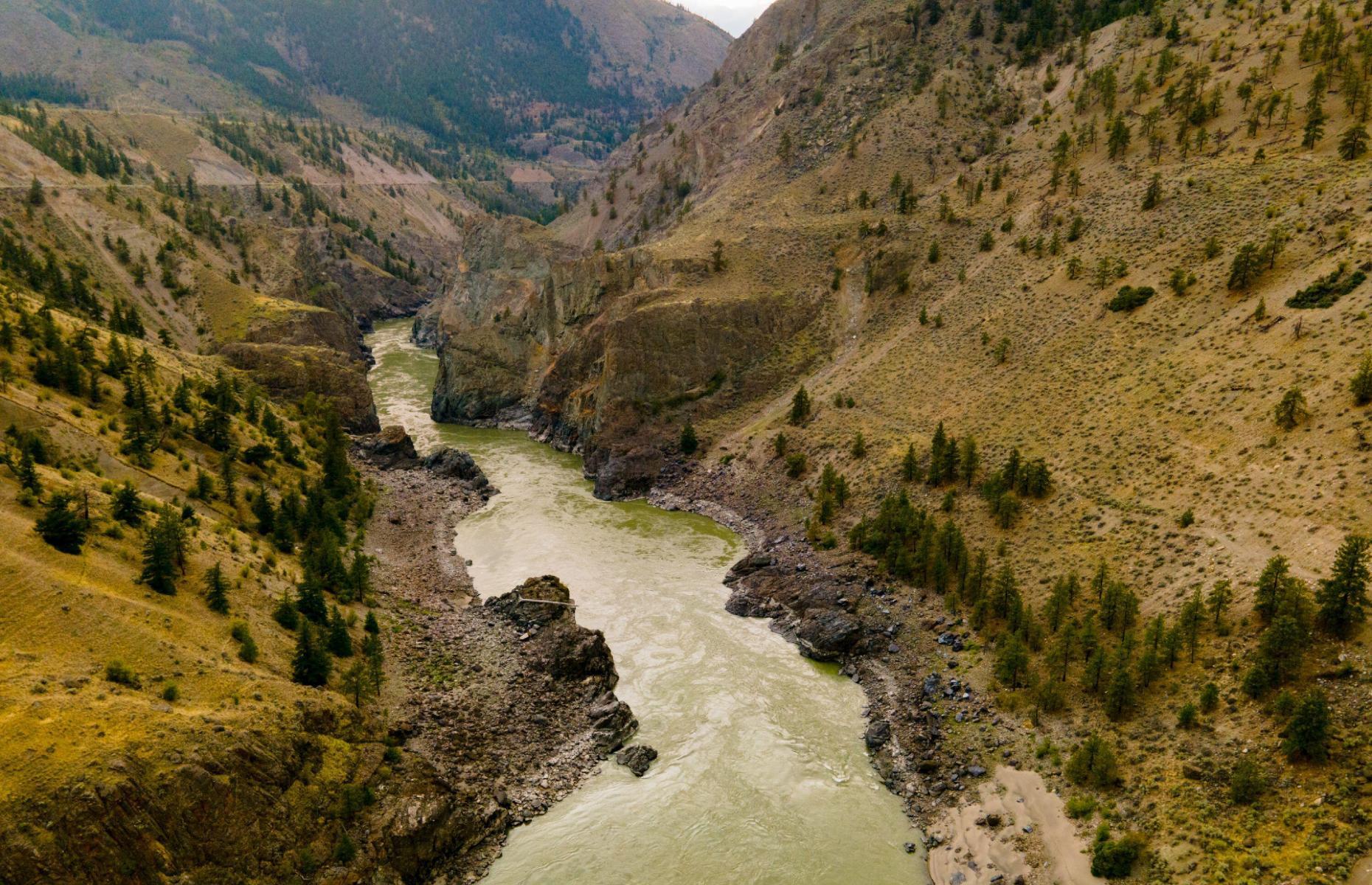
Keatley Creek, British Columbia
Indigenous peoples first began living along Keatley Creek 7,000 years ago, and around 4,000 years ago a large community began to thrive here thanks to abundant fisheries and easy woodland hunting. The depressions left by more than 115 pit houses have since been found, some of which were as large as 70 feet (21m) in diameter. Archaeologists are unsure what caused the network of villages to be suddenly abandoned around a thousand years ago, but suggestions include a landslide on the Fraser River that blocked salmon runs, crippling the area's subsistence and trade economy.

Crawford Lake, Ontario
This attractive lagoon between Toronto and Hamilton offers gorgeous panoramic views, but its real wonders lie beneath the surface. The lake is 'meromictic', which means its layers of water do not mix, therefore the layers of sediment on its bed are a goldmine for scientists and archaeologists. Sediment samples reveal precise details about human activity going back thousands of years, from the arrival of the corn-growing Iroquois all the way back to the prehistoric Anthropocene era, when humans first started impacting Earth's ecosystems.
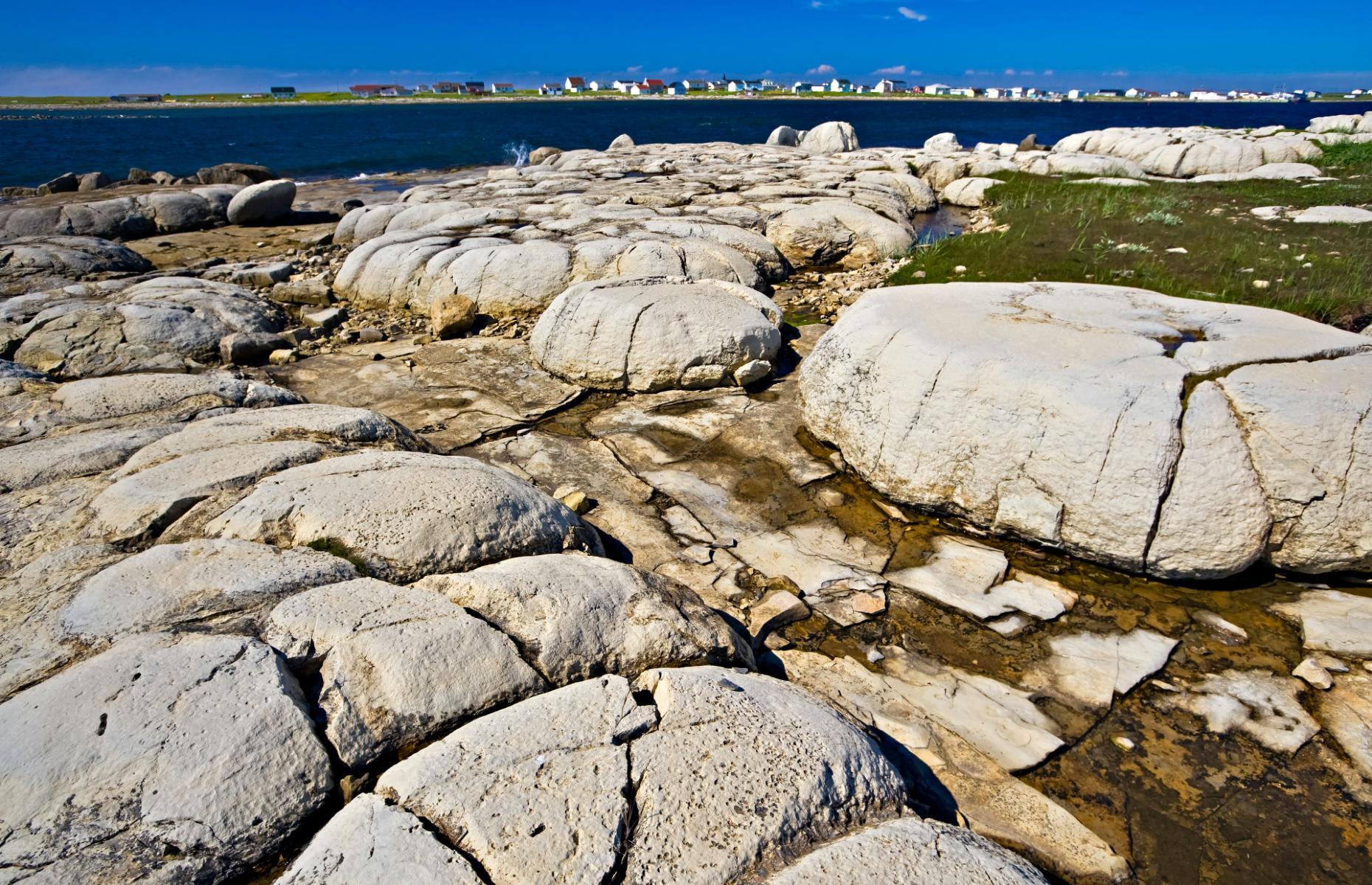
Flower’s Cove, Newfoundland and Labrador
The northwest coast of Newfoundland features the limestone barrens – a long stretch of unforested, rocky coastline. It may look bleak, but the section around Flower’s Cove contains a rare find: fossilized thrombolites, ancient stone structures formed millions of years ago by cyanobacteria and algae. It’s a top destination for geologists and paleontologists looking to understand the coastal landscape of the distant past, when it was lapped by warm, salty sea.
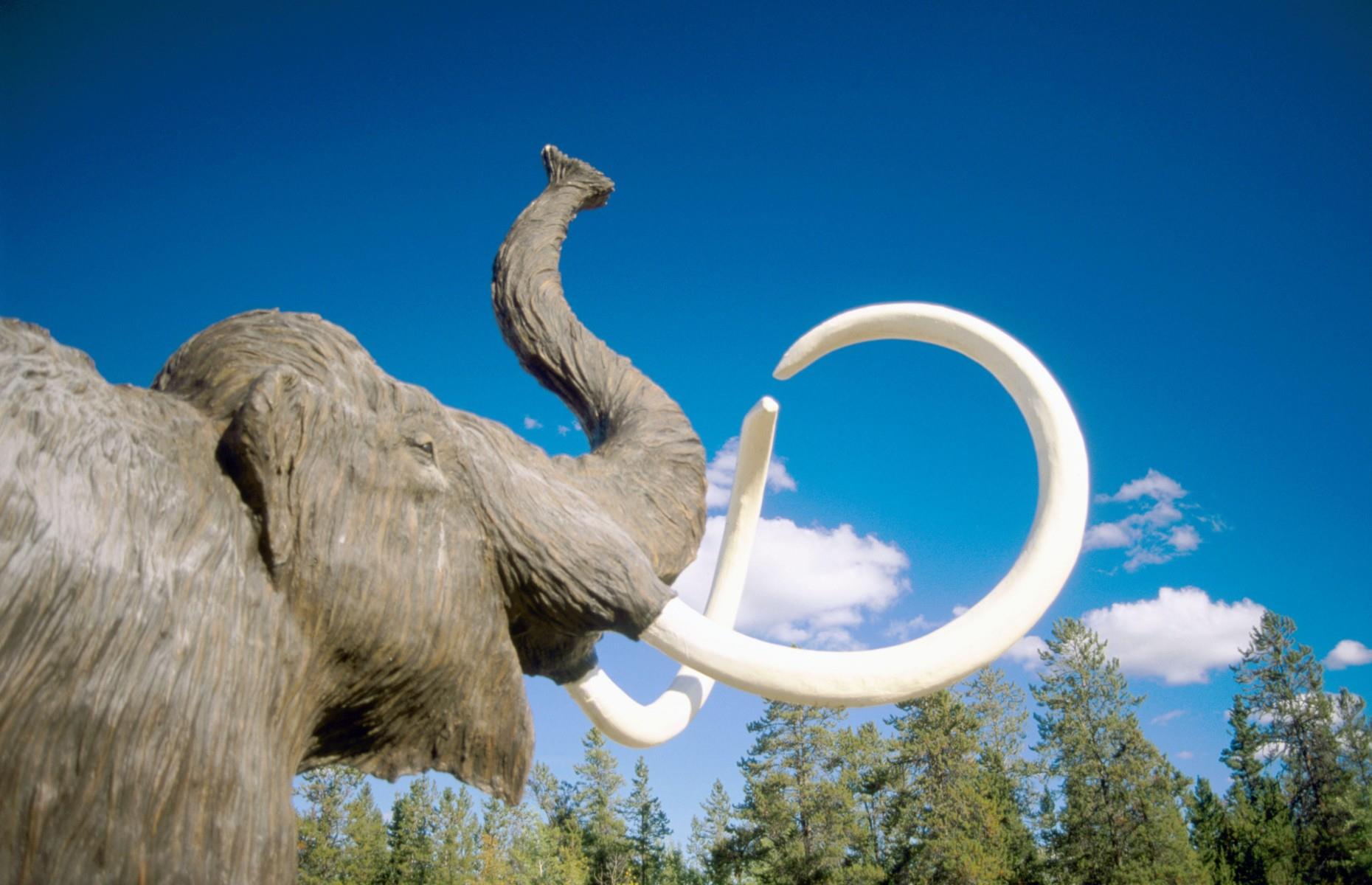
Bluefish Caves, Yukon
North America’s first human inhabitants arrived from the far northwest, when the continent was still attached to Siberia by a land bridge known as Beringia. Archaeologists working in Bluefish Caves discovered evidence of these early residents, collecting stone tools, butchered bones and other relics that may date back as far as 23,000 BC. Although the Bluefish Caves are off-limits to visitors, a life-size diorama has been constructed at the Yukon Beringia Interpretive Centre in Whitehorse.
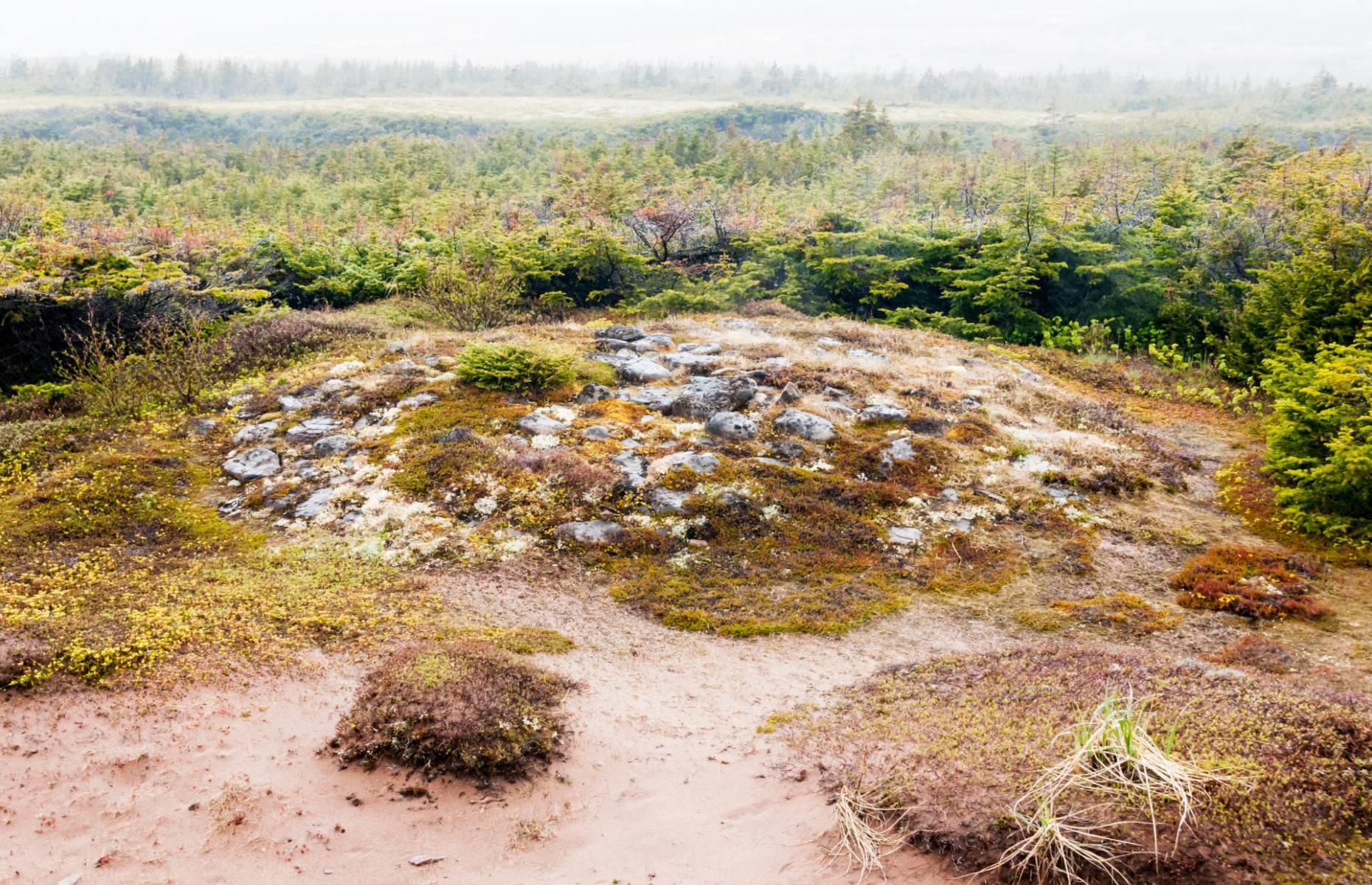
L'Anse Amour Burial Mound, Newfoundland and Labrador
This burial mound on the coast of southern Labrador is the oldest known funerary monument in North America, marking the grave of an adolescent boy who belonged to the Maritime Archaic people and died around 5,500 BC. The body was covered with red ochre, wrapped in birch bark and placed in a large pit flanked by fires. Walrus tusks, harpoon heads, paint stones and a bone whistle were then interred with him, beneath a 26-foot-wide (8m) mound that probably took the local tribe at least a week to create. Archaeologists excavated the site in 1974 before restoring the mound’s original shape for modern-day visitors to admire.
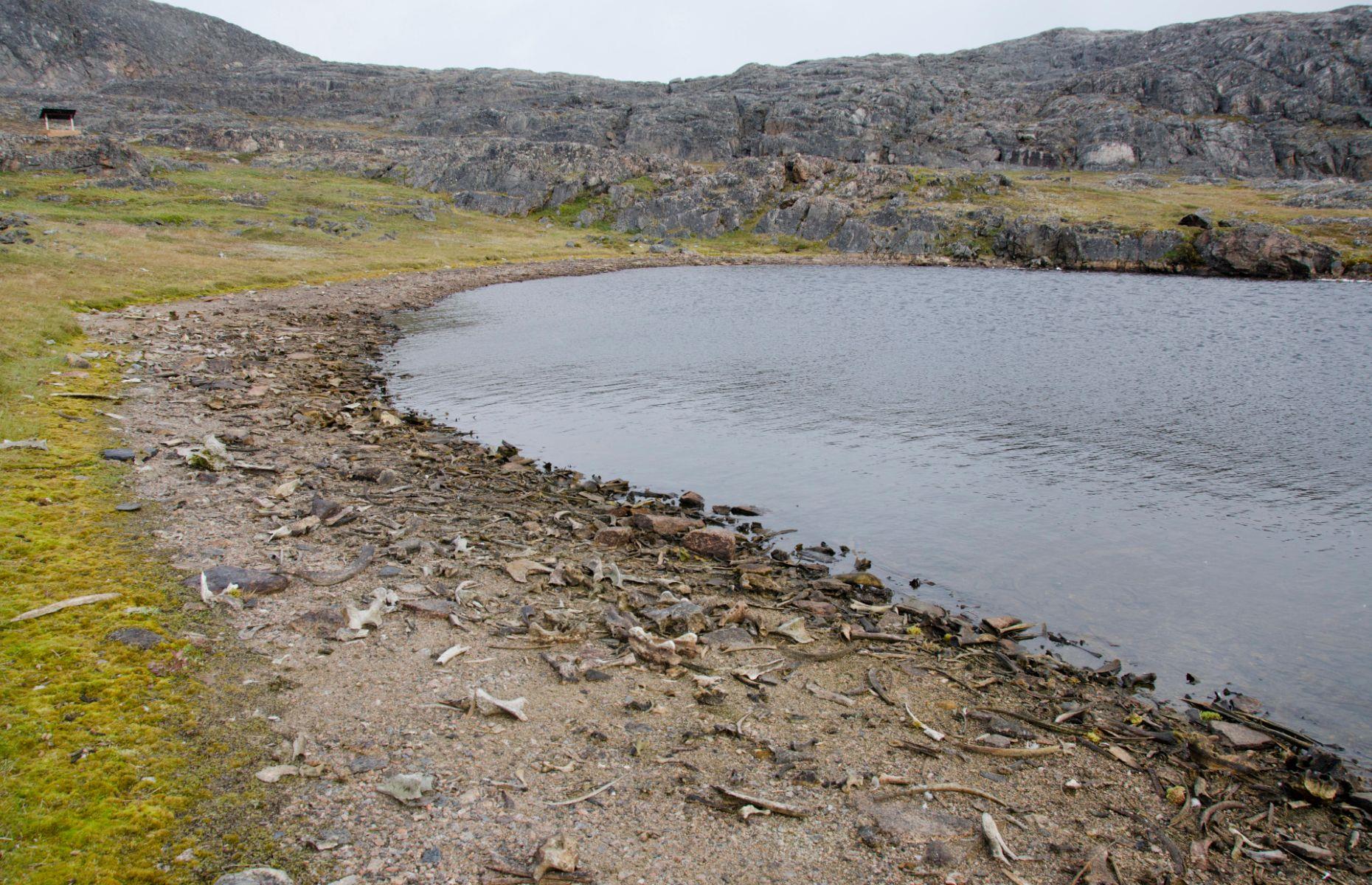
Mallikjuaq Territorial Park, Nunavut
This island park, spread across Mallik Island and Dorset Island, boasts archaeological sites from the area’s Indigenous inhabitants dating back 3,000 years. Stone house foundations have survived the icy centuries since, and some of the scattered whale, seal and walrus skeletons still bear the marks of ancient hunters. There are also tent rings, fireplaces and meat caches belonging to the Inuit who lived here when white explorers first started traveling through the region.
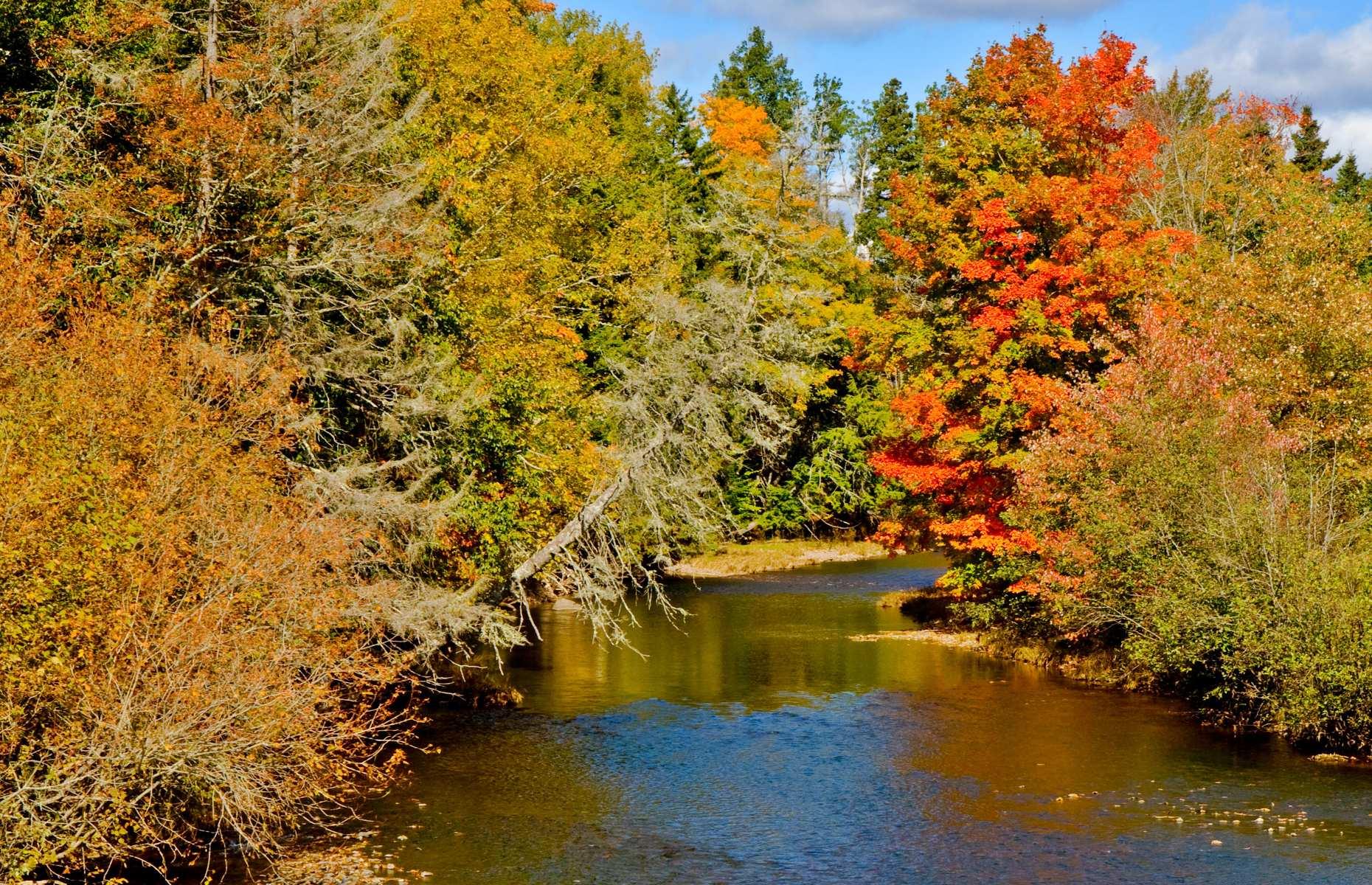
Debert Palaeo-Indian Site, Nova Scotia
We’re lucky that a local married couple stumbled across these ancient remains when they went blueberry picking near the village of Debert in Nova Scotia in 1948, as the husband happened to be an amateur archaeologist. But even he had no idea that the artifacts he pulled up by the roots dated to 9,000 BC and represented the earliest known human activity on the Canadian Atlantic coast. Further investigation revealed 4,500 stone objects across five locations – probably seasonal camps used by Indigenous tribes as they followed the caribou migration.
Amazing archaeological finds uncovered by amateurs

Parc Cartier-Roberval, Quebec
Jacques Cartier was France’s Christopher Columbus – he led his country’s first expeditions to the so-called New World. Cartier’s third voyage of discovery ranged inland along the St Lawrence River and founded the first French colony on the riverside. Charlesbourg-Royal was abandoned after only two years thanks to starvation and hostile natives, and its exact location was lost until archaeologists rediscovered it in 2006 in present-day Cap-Rouge. The find is now preserved as a riverside park with historic trails.
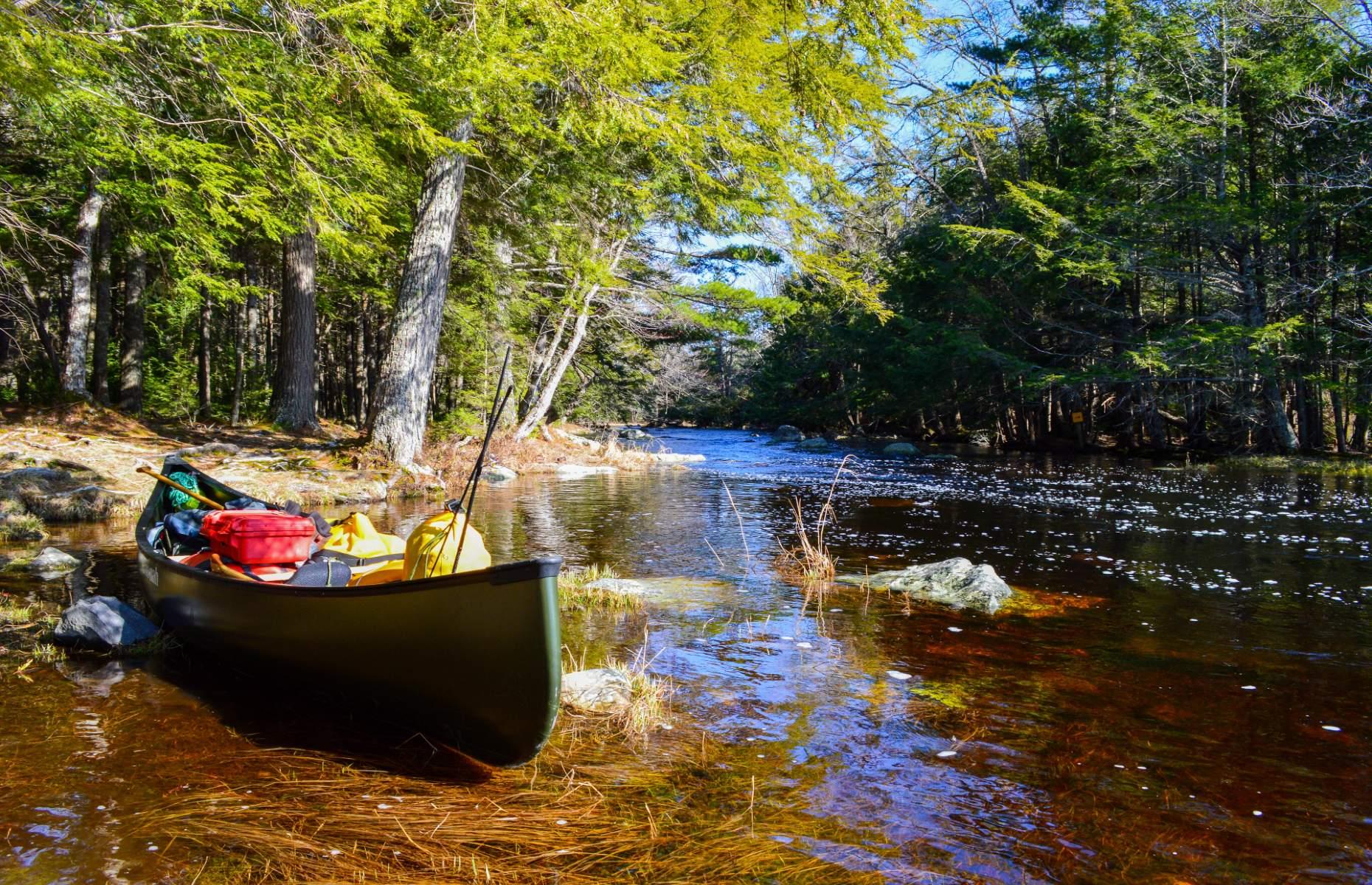
Kejimkujik National Park, Nova Scotia
For thousands of years Indigenous peoples traversed the lakes and rivers of Kejimkujik by canoe. Archaeologists have since scoured more than 150 square miles (400sq km) of lakeshore and riverbank, uncovering camps, hunting sites and burial grounds. They also unearthed more than 500 individual petroglyphs recording details of everyday Mi'kmaq life. Some depict men and women in traditional dress, some show sailors hunting porpoises from canoes rigged with small sails, and some even bear the signatures of the artists that created them. Follow in the Mi’kmaq wake by hiring a canoe, kayak or paddleboard to explore the ancestral waterways.

Colony of Avalon, Newfoundland and Labrador
Like many early colonial settlements, the town of Ferryland in Avalon Colony was abandoned when its pioneers discovered better land. Now, the Colony of Avalon visitor attraction – still a working archaeological site – provides a snapshot of the early years of the English in Canada. Archaeologists have pulled more than a million individual objects from the rock-strewn soil, and the Colony of Avalon Foundation offers you the chance to add to the collection with hands-on excavation experiences.
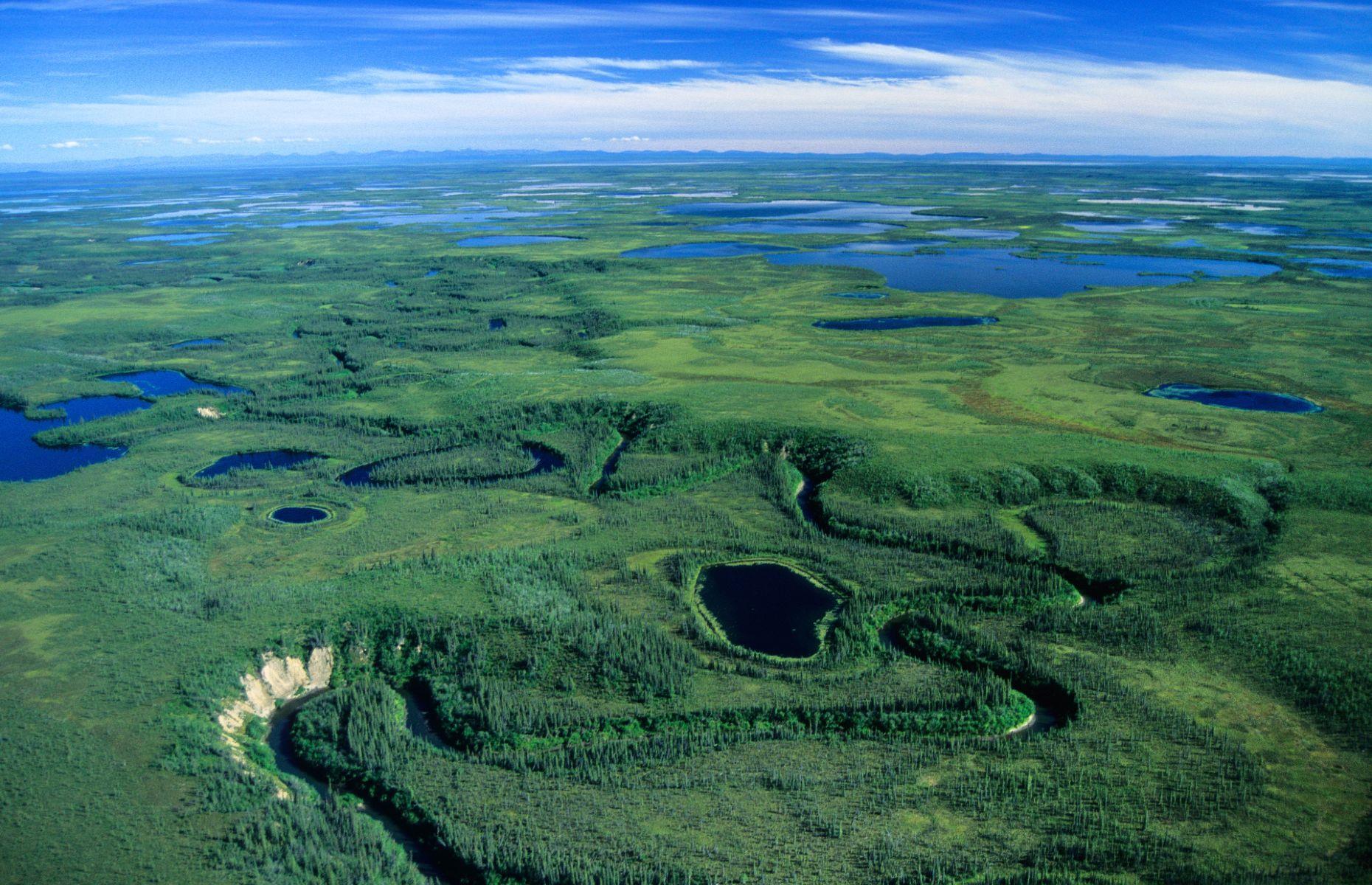
Van Tat K'atr'anahtii, Yukon
Also known by its anglicized name 'Old Crow Flats', this wetland complex along the Old Crow River is inside the Arctic Circle and surrounded by mountains on all sides. But that didn’t stop the Vuntut Gwitchin people settling here more than 10,000 years ago. The Indigenous tribe, known as 'the people of the lakes', survived in the harsh north by hunting, and their arrival may have contributed to the local extinction of ground sloths, giant beavers and mammoths, all of which survive only in fossils.
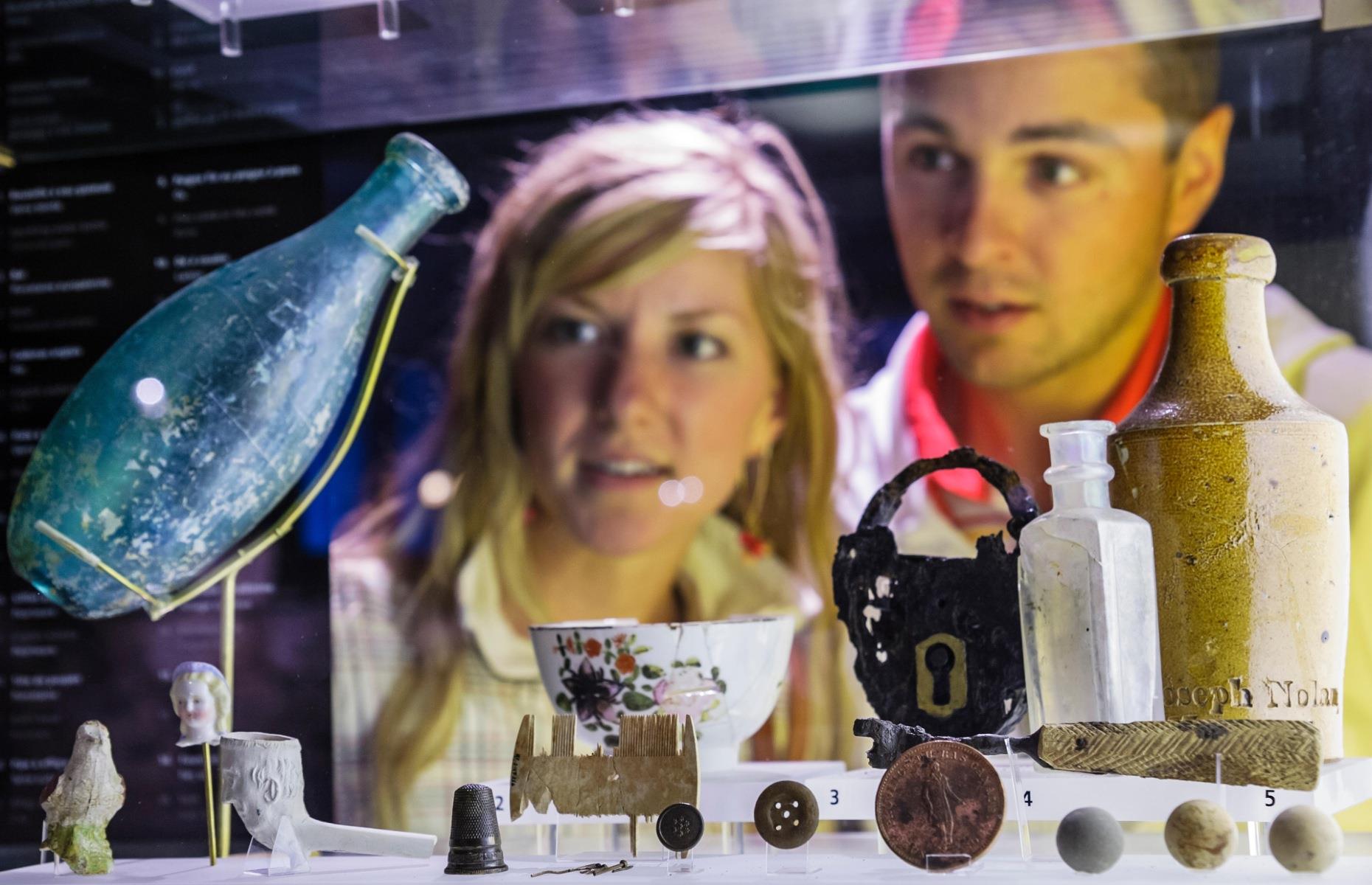
Pointe-a-Calliere, Quebec
Montreal’s biggest and most-visited museum is built on top of several buildings and structures dating back to the city’s founding in the mid-17th century. The museum was constructed atop piles and pillars to ensure the archaeology was disturbed as little as possible, and visitors can view a range of in-situ sites including the city's first marketplace, the Fort Ville-Marie fortress, the city's first Catholic cemetery and even an enormous old sewer. All are presented in an engaging way, making innovative use of modern technology.
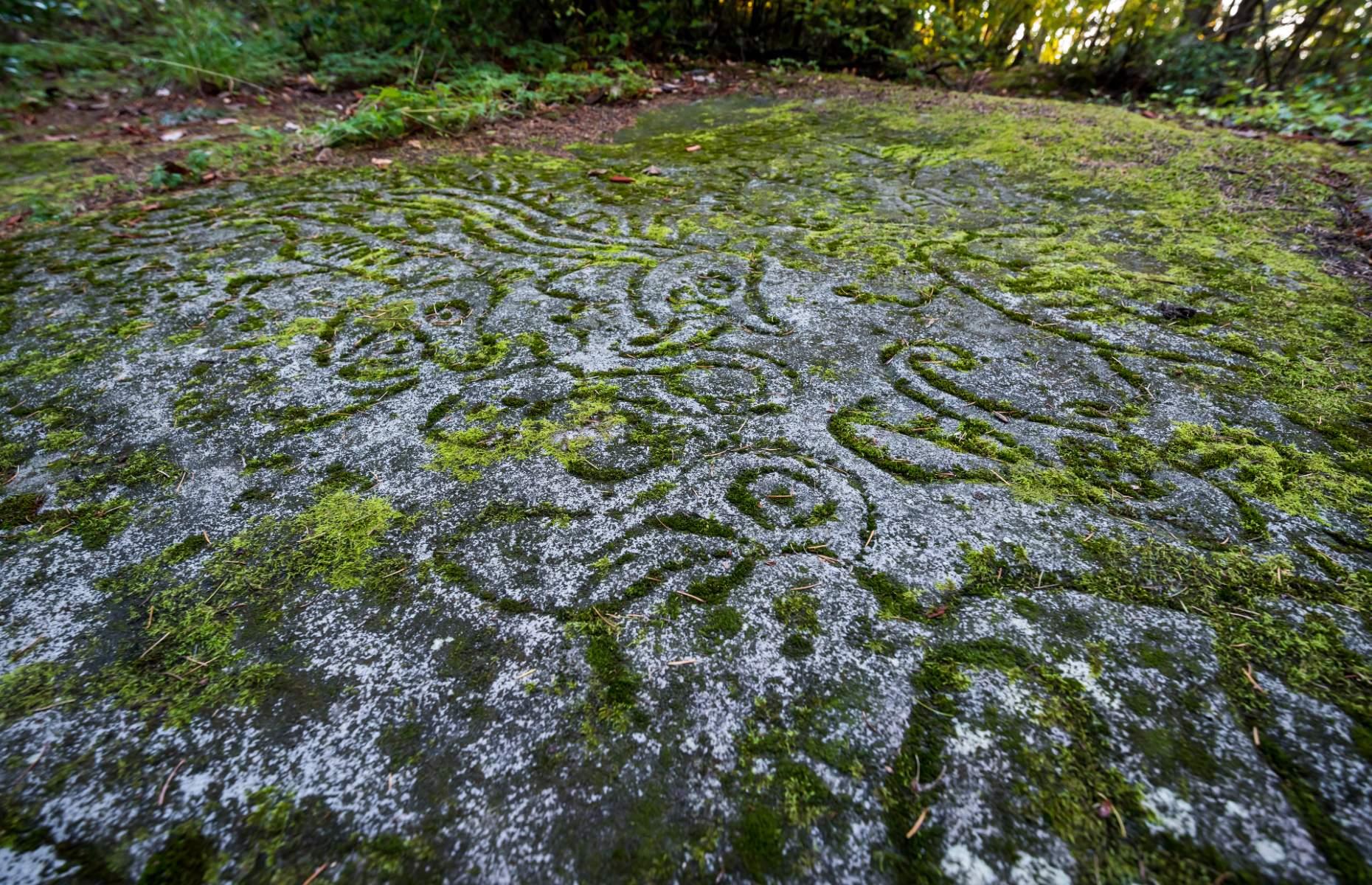
Petroglyphs Provincial Park, Ontario
The Indigenous peoples that lived near the modern town of Woodview regarded the forest as sacred – some thought that deep crevices in the rock led to the spirit world, and that the sound of water trickling underground was spirits talking. Around a thousand years ago, local tribes carved 1,200 petroglyphs into the rocks – the largest concentration of Indigenous carvings in Canada – including images of shamans, animals and spirits. Now, the carvings known as the Teaching Rocks are protected from the elements by a shelter at the heart of the provincial park.
These ancient finds quite literally changed history
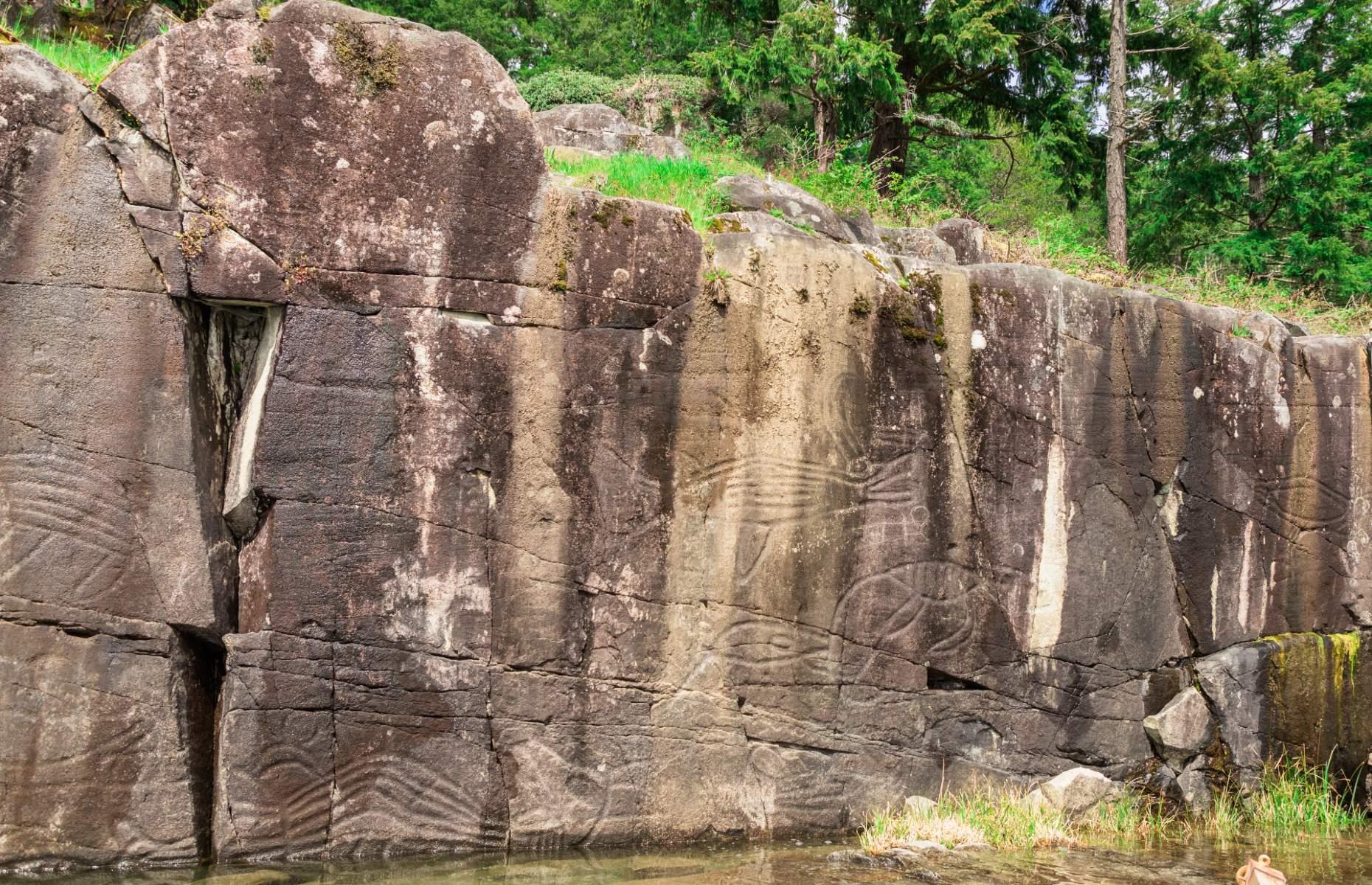
Sproat Lake, British Columbia
Sproat Lake is best known as a summer getaway for Vancouverites, but the kayakers, hikers and paddleboarders that frequent its shores are unaware that the area was once home to Indigenous tribes as far back as 11,000 BC. Some of the early inhabitants must have been artists, because they carved the K'ak'awin petroglyph on lakeshore rocks – the wavy designs are thought to depict a mythological sea serpent.
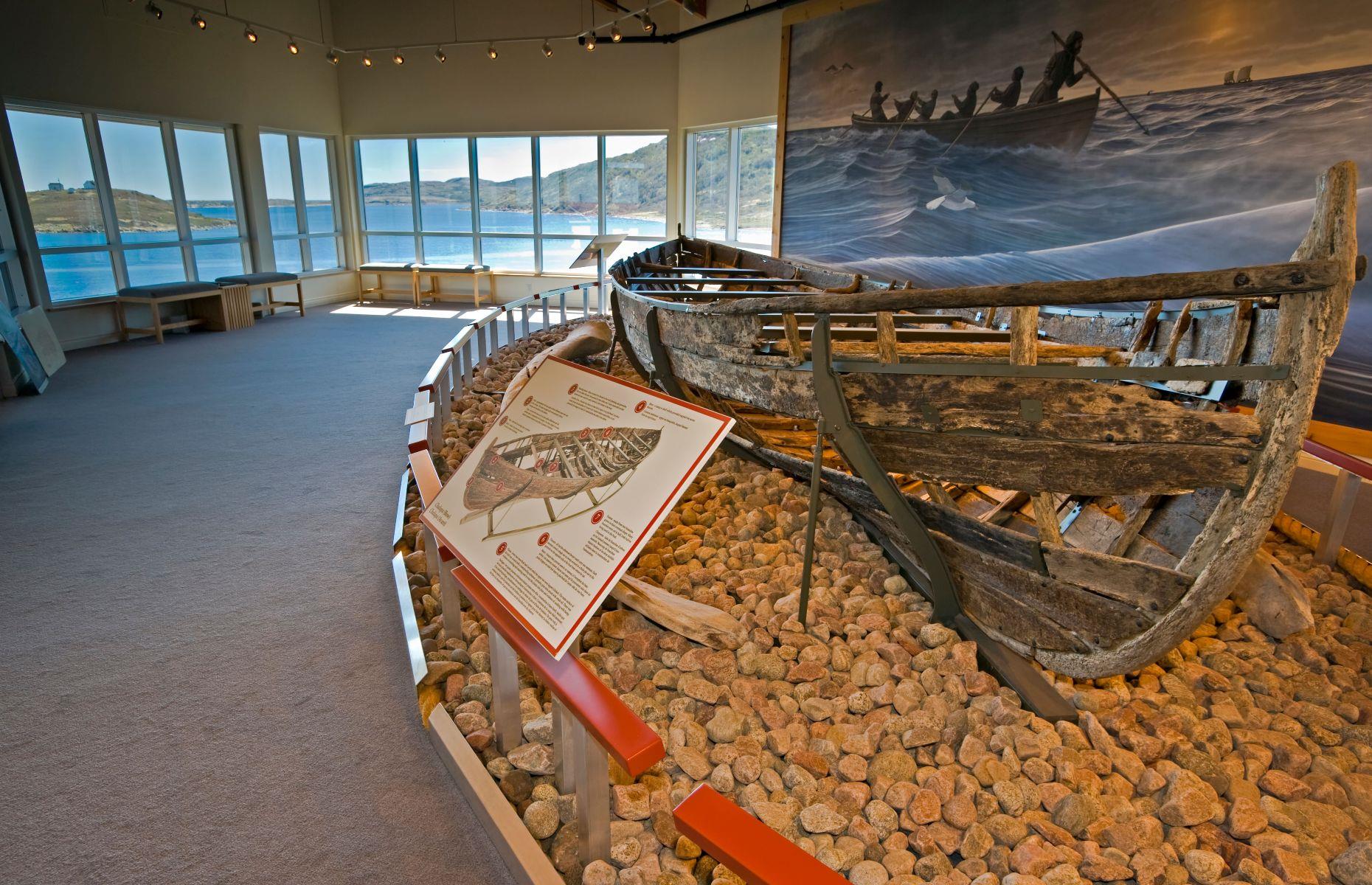
Red Bay, Newfoundland and Labrador
Spanish and French pioneers on the Newfoundland coast discovered that its waters were thick with whales, and established a port at Red Bay to handle carcasses and process valuable whale oil. The gruesome trade has now been consigned to history, but the modern village has a whaling museum that includes a surprisingly small chalupa that's North America's oldest known whaling boat. The vessel spent 400 years at the bottom of Red Bay before it was recovered by maritime archaeologists, and is dwarfed by whale bones elsewhere in the museum.
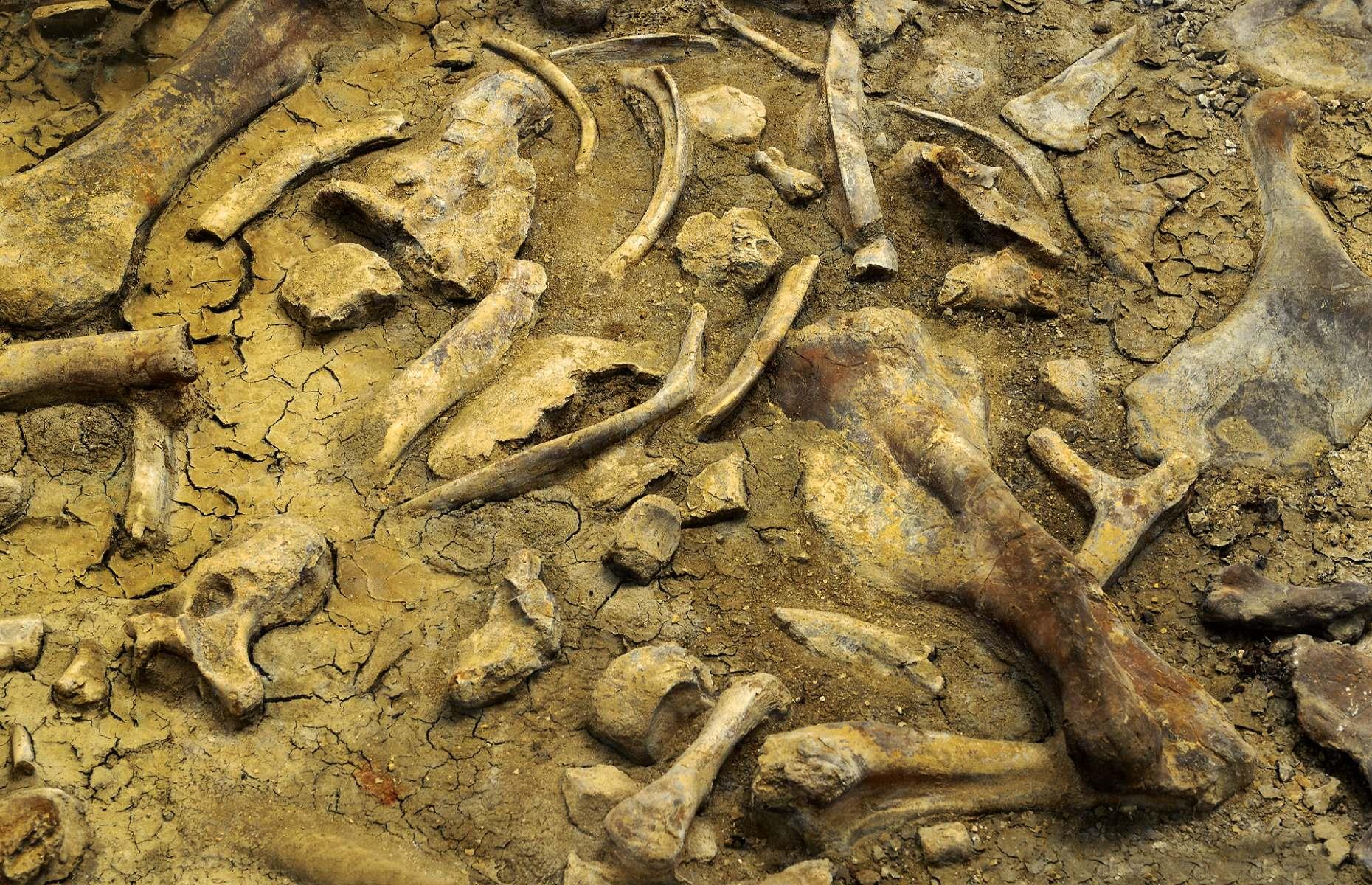
Dinosaur Provincial Park, Alberta
The arid badlands of the Red Deer River valley in southern Alberta are perfect for the preservation of dinosaur fossils. At present, 350 or so specimens from the Dinosaur Provincial Park are spread across more than 30 major world museums, while many more are on display at the park's visitor center. Here you’ll find an astonishing range of finds, from large herbivores, bird-like creatures and duck-billed dinosaurs to the ever-popular T-rex-esque hunters. The 30 square miles (78sq km) of parkland have been a UNESCO World Heritage Site since 1979.
Discover the most fascinating fossil finds from recent years
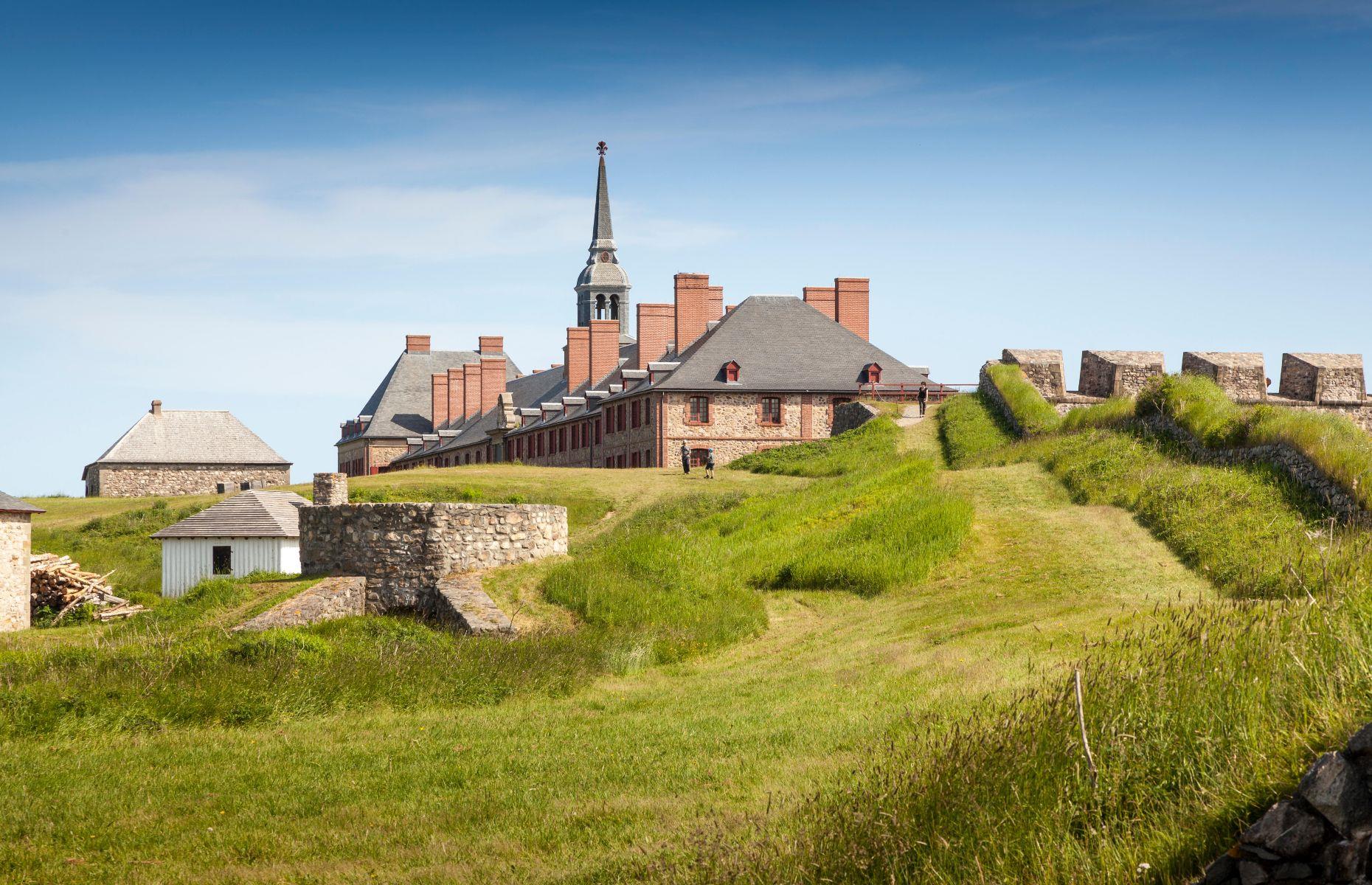
Fortress of Louisbourg, Nova Scotia
This 18th-century French fortress is now a well-known living history museum that entertains and informs visitors with reconstructions and reenactments from Canada’s colonial past. But only a quarter of the original fort and town has been restored; the rest is still under investigation by archaeologists, who are working against the clock to record buildings at risk of destruction by coastal erosion and rising sea levels. They’ve also excavated graves from a burial ground to stop Canada’s colonial inhabitants being washed into the Atlantic.
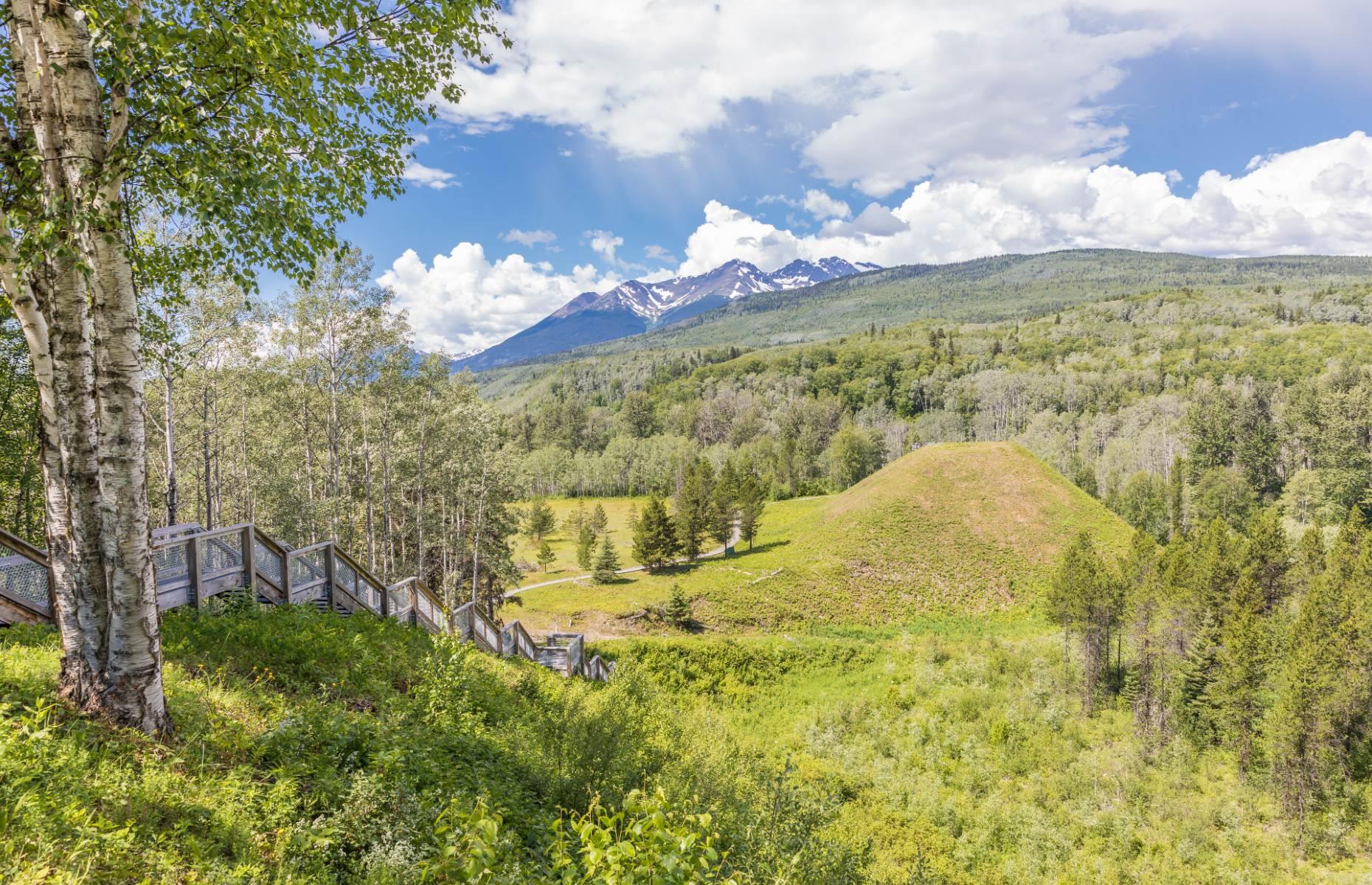
Gitwangak Battle Hill, British Columbia
The Indigenous peoples along the Kitwanga River had a habit of raiding each other’s territory. When the village belonging to the Gitwangak tribe came under attack, its tribespeople would retreat to a hillfort, now known as Gitwangak Battle Hill, and use its steep sides to protect themselves. During the 1970s, archaeologists uncovered the remains of a palisade and defensive works. The mound can still be climbed, and a collection of totem poles stand nearby.
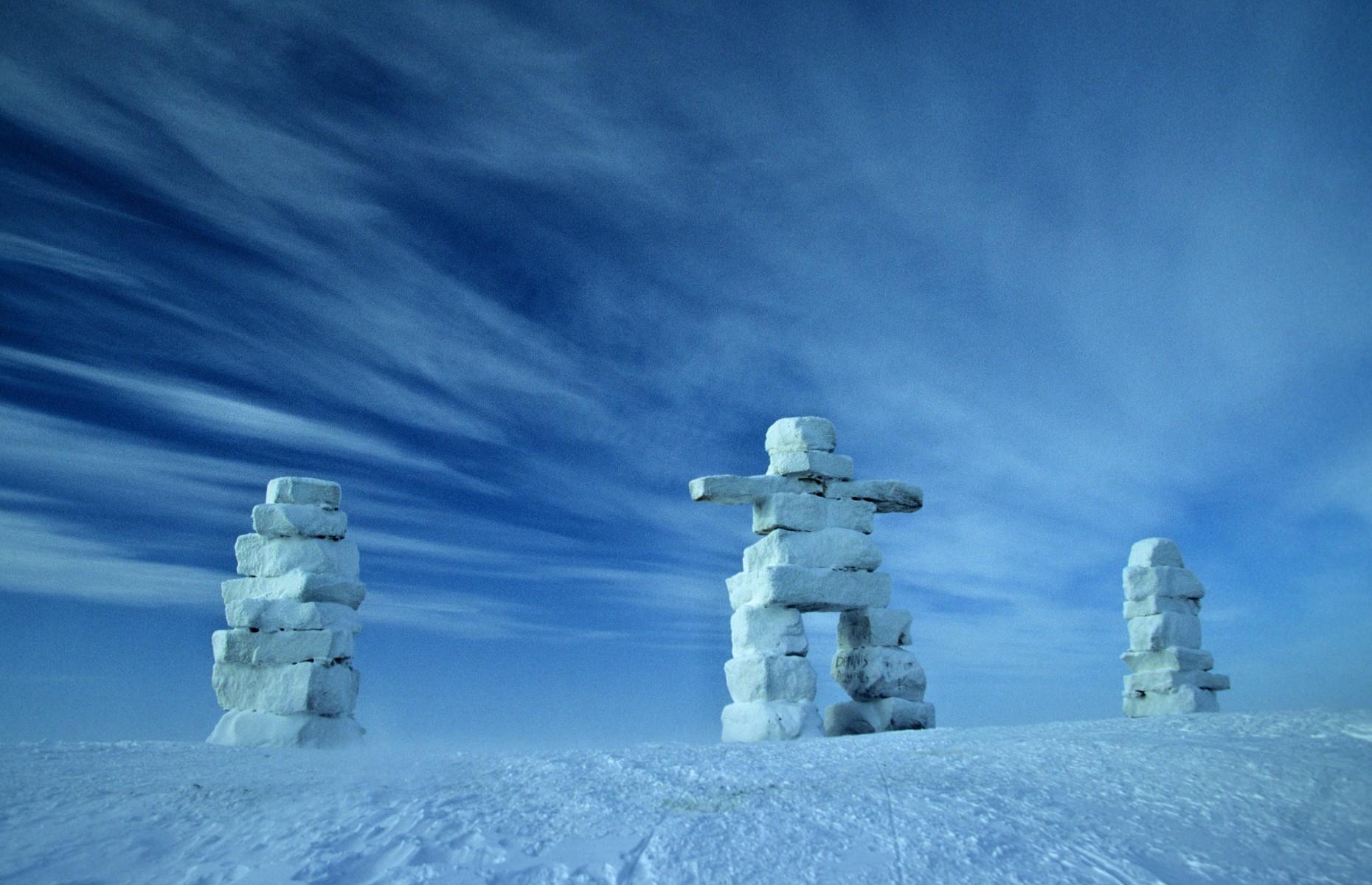
Igloolik Island, Nunavut
The Inuit inhabited Igloolik Island – between the Canadian mainland and Baffin Island, north of the Arctic Circle – from 2000 BC, and founded a number of settlements. Now only one small village remains, but archaeologists know about the others after discovering qarmaq (grass sod houses) and inukshuk (humanoid stone sculptures). Fishing and seal-hunting opportunities also made Igloolik Island a handy stopover for 19th-century explorer Edward Parry, who left behind evidence of his winter camp.

Chateau Saint-Louis, Quebec
When French colonists wanted a defendable seat of government for the colony of Quebec, they chose a prominent hill overlooking modern-day Quebec City. Even so, the British managed to capture the governor’s chateau in 1759. They gradually rebuilt the house but it was promptly destroyed by fire in 1834, after which it was replaced by a series of terraces. The remains of the French and British buildings, four forts and several outbuildings are now open to the public.
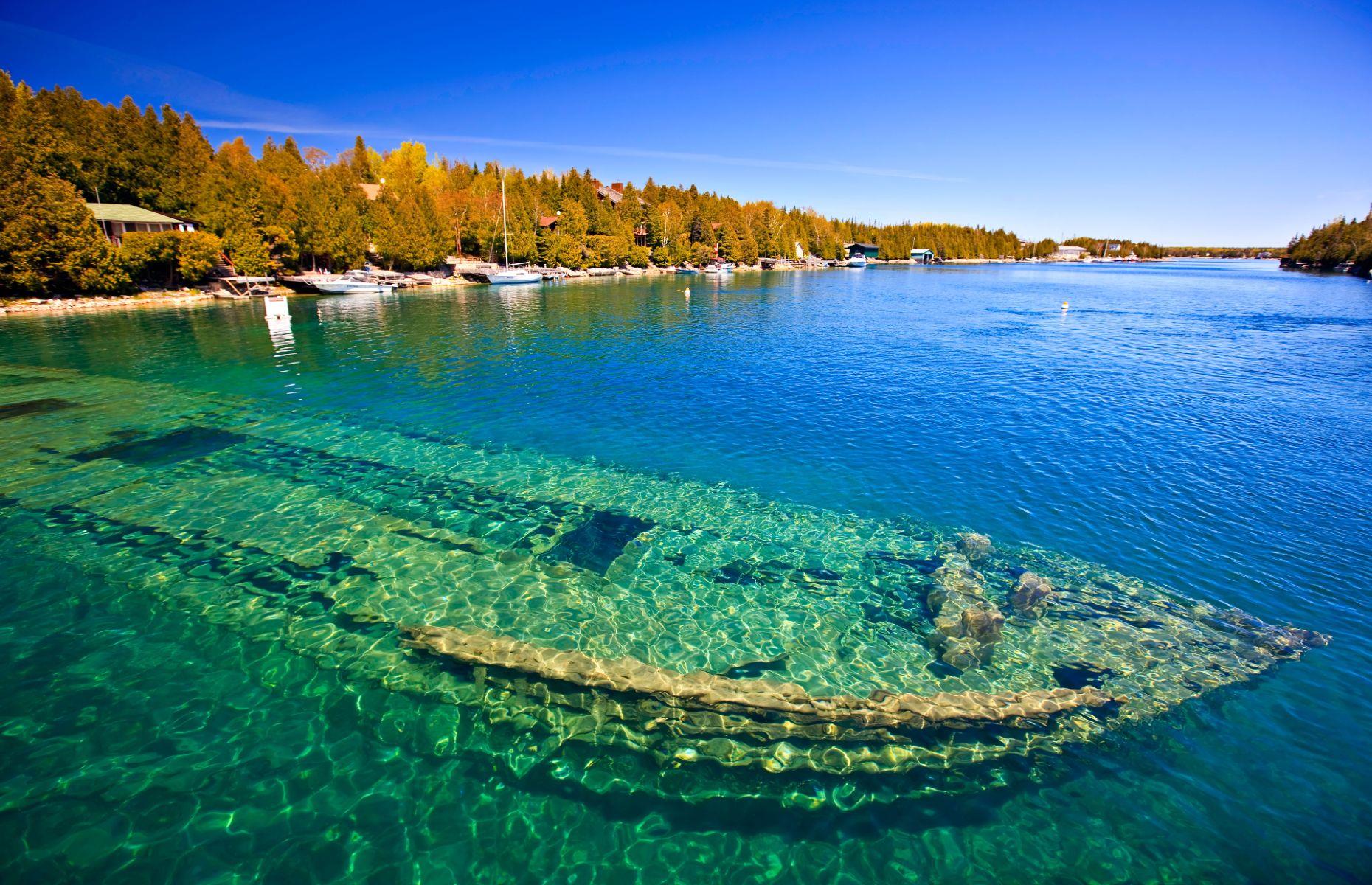
Fathom Five National Marine Park, Ontario
Lake Huron might be entirely inland, but the extraordinary number of shipwrecks at Fathom Five suggest it was just as treacherous for skippers as anywhere on the high seas. Maritime archaeologists have swept away the silt to uncover 24 sunken vessels, from the Avalon Voyager II – in water so shallow it can be viewed by snorkelers – to the 217-foot (66m) steamer Forest City. The area is famous for its scuba diving, but you can stay dry and see the wrecks too, since glass-bottom boat tours pass over the 19th-century ships Arabia and Sweepstakes.
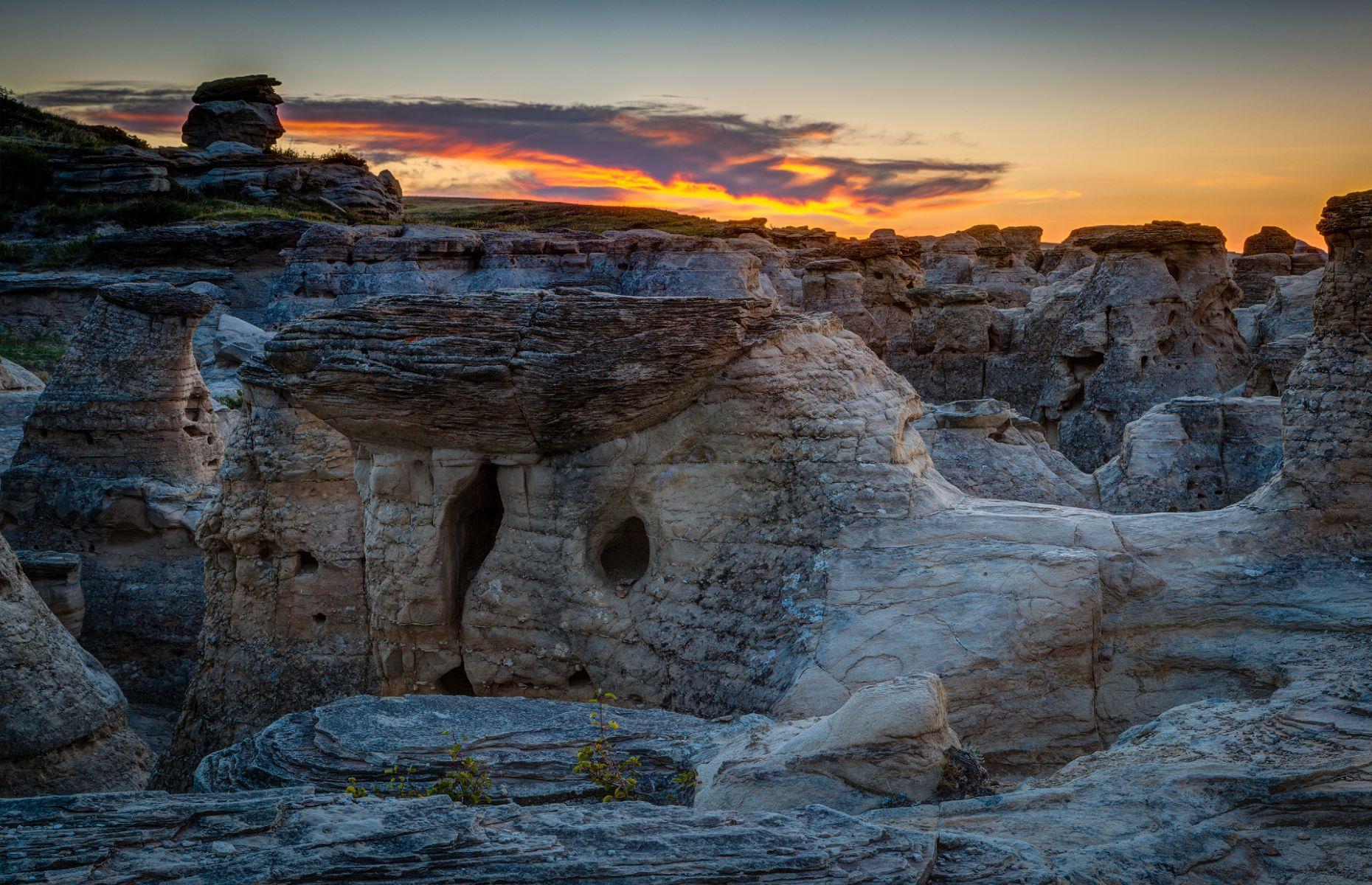
Writing-on-Stone Provincial Park, Alberta
Almost in touching distance of Canada’s southern border, this 1,100-hectare prairie contains the greatest concentration of Indigenous rock art in the Great Plains. Thousands of individual works dating back more than 3,000 years are spread across 50+ sites, with hiking trails linking some of the best areas to explore. The Blackfoot created most of the carvings, although other nomadic tribes may also have left their own artworks on the towering cliffs and spires.
Now learn about America's most important archaeological discoveries
More for You
Caitlin Clark gets fancy and dazzles in a red dress to collect Wooden Award
Supreme Court unanimously rules against exorbitant government fees
The Most Terrifying Bridge in Every State
Traumatic Disney Movies That Scarred a Generation of Children
38 Common American Sayings That Make Absolutely No Sense To Non-Americans
Ex-MLB star and Senate candidate Steve Garvey ‘stunned’ by depths of CA homeless crisis, will seek audit
7 CDs You Probably Owned, Threw Out and Now Are Worth Bank
Florida Removes 1.4 Million People from Health Care Plan
Tesla Owner Calls Police on Rivian Driver Using Supercharger
Vladimir Putin issues chilling new WW3 warning after successful test of experimental nuclear missile
15 Movies That Haunted Us for Days
Michael Cooper shares wife's uncanny suggestion of making Larry Bird his HOF presenter: "When it is all over with, we're all human"
36-year-old brought in $77,000 in passive income from Etsy in 2023—she spends 5-10 minutes per day on it
Top 30 Most Difficult Songs to Sing
Marvel Studios Unveils Updated Thunderbolts Logo & Title at CinemaCon
Sam's Club makes a key move designed to trump Costco
27 Side Characters That Stole The Spotlight
3 underrated Netflix movies you should watch this weekend (April 12-14)
British intelligence: Putin's military bribery attempt could have consequences
We’re not playing around in Florida: Ashley Moody

IMAGES
VIDEO
COMMENTS
The drive from Calgary to Head-Smashed-In Buffalo Jump is 183 km which takes approximately one hour and 50 minutes. If leaving from the city, take AB-2 / Deerfoot south, following the signs for Fort Macleod and Lethbridge. Follow AB-2 south for an hour and a half until reaching AB-785 W, and turn right at the marker for Head-Smashed-In Buffalo ...
Head-Smashed-In Buffalo Jump Interpretive Centre is a UNESCO-designated World Heritage Site that preserves and interprets over 6,000 years of Plains Buffalo culture. Through vast landscapes, exhibits, and diverse programming, learn about the cultural significance of this cliff to the Plains People. ... Fort MacLeod, Alberta 403-553-2731. → ...
Known for its remarkable testimony of prehistoric life, the site bears witness to a custom practiced by indigenous people of the North American plains for nearly 6,000 years. With its elaborate drive lane complex and deep archaeological deposits still intact, Head-Smashed-In Buffalo Jump was designated a World Heritage site by UNESCO in 1981.
If You're Going: Head-Smashed-In Buffalo Jump. Address: Route 785, Fort MacLeod, Alberta, Canada AB T0L 0Z0 ( Google Map) Cost: $15 Canadian for adults, $13 for seniors, $10 for kids. When to Visit: Open 10-5 everyday (only open Wednesday through Sunday in winter) Website: https://headsmashedin.ca/. Further Reading: Head Smashed In Buffalo ...
Next, follow AB-785 W until you see the entrance sign for Head-Smashed-In Buffalo Jump on your right. The drive from Calgary to Head-Smashed-In Buffalo Jump typically takes about two hours, depending on traffic and road conditions. Parking area at the Jump site. Traveling from Edmonton is about 5 hours by car.
Sign at the Entrance. Head-Smashed-In Buffalo Jump is a buffalo jump located where the foothills of the Rocky Mountains begin to rise from the prairie 18 km (11 mi) west of Fort Macleod, Alberta, Canada, on Highway 785.It is a UNESCO World Heritage Site and home of a museum of Blackfoot culture. Joe Crowshoe Sr. OC (1903-1999) - Aapohsoy'yiis (Weasel Tail) - a ceremonial Elder of the ...
Head-Smashed-In Buffalo Jump is located in southern Alberta, Canada, where the foothills of the Rocky Mountains meet the Great Plains. It is the best preserved example of the communal hunting techniques and of the way of life of the Plains people based on the vast herds of bison that existed in North America for more than five millennia.
Head-Smashed-In Buffalo Jump is located 18 kilometres (15 minutes) north and west of Fort Macleod on Secondary Highway #785 (paved). ... The Buffalo Jump Cafe remains closed, but the space is available for use by individuals and small groups; Vending machine available; ... Toll-free in Alberta: first dial 310-0000 Email: [email protected]
Head-Smashed-In Buffalo Jump is located 18 km northwest of Fort Macleod, Alberta, Canada on Highway 785. Good footwear is recommended for walking on the trails. cultures and civilizations rites ...
After the Sun Dance, the bands again separated to pursue the buffalo. In the fall, the bands would gradually shift to their wintering areas and prepare the bison jumps and pounds. Several bands might join together at particularly good sites, such as Head-Smashed-In Buffalo Jump. As the bison moved into the area, drawn by water and richer forage ...
The story behind this Unesco World Heritage site with the strangest name of any attraction in Alberta is one of ingenuity and resourcefulness - and is key to the First Nations' cultural heritage (and Canada's, too!). The Blackfoot people used the cliffs near the town of Fort Macleod to hunt buffalo when conditions were right.
At one point in our history, more than 60 million buffalo roamed the continent's Interior Plains including the wide-open grasslands of Alberta's fertile province, Today, those numbers have perished but Head-Smashed-In Buffalo Jump, located just 18 km northwest of Fort McLeod along highway 785 in the south end of Alberta, is home to the museum of Blackfoot culture and a trip back to a time ...
The Head-Smashed-In Buffalo Jump is located in Southern Alberta, approximately 20km northwest of Fort MacLeod and in the heart of the Blackfoot Nation's traditional territory [3]. It represents one of the best persevered buffalo jumps left in the area. The bones of the bison are high in potassium, and bone mining was a profitable industry ...
Most visitors to Alberta head to Banff and Jasper, which are amazing but in my humble opinion, Head-Smashed-In Buffalo Jump is also worth a visit to explore this lesser-seen part of Alberta. This post has been updated and republished. Head-Smashed-In Buffalo Jump is a UNESCO Site and one ...
Head-Smashed-In Buffalo Jump. This is one of the world's oldest and best-preserved buffalo jumps. Indigenous hunters used the buffalo jump for nearly 6,000 years. You can tour the storied cliffs with an Indigenous guide to learn more about the history and importance of Head-Smashed-In Buffalo Jump, which became a UNESCO World Heritage Site in ...
Head-Smashed-In Buffalo Jump - Facts and How to Visit. Visit Head Smashed In Buffalo Jump and learn about the Plains People and their efficient buffalo hunt which ensured their survival through the harsh prairie winter. This UNESCO World Heritage Site, 2 hours south of Calgary, Alberta Canada, shows evidence of use for over 6,000 years.
Piskun, the Buffalo Jump. This 3-hour immersive experience takes visitors back in time to learn the basics of buffalo hunting, get deeper into the Blackfoot culture, and get a much better appreciation of the site. First, an elder gives everyone a traditional Blackfoot blessing, a truly special and heart-warming experience in and of itself.
Alberta's Head-Smashed-In Buffalo Jump brings the history of the Plains Indians to life. Learn about the buffalo hunt, see the cliffs that spelled their doom...
Hours and fees of Head-Smashed-In Buffalo Jump. Head-Smashed-In Buffalo Jump is open 7 days a week from 10 AM - 5 PM except for Easter Sunday, Christmas Eve, Christmas and New Year's Day. On occasion they close if there is severe weather so check ahead of time. Admission for adults is $15, youth 7-17 are $10, and kids 6 and under are free.
History of Head-smashed-in Buffalo Jump. Head-Smashed-In Buffalo Jump Interpretive Centre is a UNESCO-designated World Heritage Site that preserves and interprets over 6,000 years of Plains Buffalo culture. Through vast landscapes, exhibits, and diverse programming, learn about the cultural significance of this cliff to the Plains People.
All About Head-Smashed-In Buffalo Jump . This buffalo jump is one of the deepest, oldest and best-preserved bison kill sites in North America. It is located on a cliffside at the southeastern edge of the Porcupine Hills, near Fort Macleod, Alberta.Head-Smashed-In Buffalo Jump is a world-class cultural site with an impressive, multi-story Interpretive Centre that leads visitors from the past to ...
Cate Shipley's travel guide for Fort Macleod with 11 favorite places to visit. ... Prairie Dog Kennels is conveniently located in Southern Alberta off of Hwy 519 (The Granum Hwy). ... 104079 RR252 follow the kennel signs to our new modern facility. 49 min · 32.6 mi. 2. Head-Smashed-In Buffalo Jump World Heritage Site. Save. Historical landmark ...
See some highlights of the Head-Smashed-In Experience! See 360 degree panoramic views plus photos of the display areas. ... Introducing Head-Smashed-In Buffalo Jump! (YouTube link - Travel Alberta) ... Menu. Visit; Events; Programs & Experiences; About; Contact. Phone: 403-553-2731 Toll-free in Alberta: first dial 310-0000 Email: info.hsibj@gov ...
Head-Smashed-In Buffalo Jump is just one of the places you can visit on your tailor-made vacation to Canada created by Audley's travel experts.
Head-Smashed-In Buffalo Jump, Alberta Bad-tempered bison were dangerous prey for the hungry Blackfoot tribe, but its brave hunters had a clever technique for bringing them down.